Existing customer? Sign in

24 powerful customer satisfaction survey questions (+ templates)

Customer feedback surveys are important because they give you an insight into what your customers are thinking and feeling. This information can help you make decisions about your product, your customer service, and your overall business strategy. Customer satisfaction surveys (CSAT) are an important way to measure how your customers feel about their experience with your company.
Creating customer satisfaction surveys is reasonably straightforward, but you have to make sure you’re asking the right questions. If you ask too many questions, customers won’t fill out the whole survey. Ask the wrong questions, and they won’t tell you what’s really happening with your business.
To help you create a survey that will get you the high-quality customer feedback you need, we’ve put together a list of more than 20 customer satisfaction survey questions. We’ve also included some example CSAT survey templates you can use to measure customer satisfaction and get started today.
Why customer satisfaction surveys are important
Customer satisfaction surveys help you to understand your customer’s needs and wants. They also allow you to track customer satisfaction over time, so you can see if your company is making improvements. Additionally, customer satisfaction surveys can help you identify areas where your company needs to make changes.
This is important, because customer satisfaction data shows that satisfied customers are more likely to be repeat customers and continue doing business with you. They’re also more likely to refer new customers by telling their friends and family about your company. On the other hand, dissatisfied customers are more likely to take their business elsewhere.
We’ve written a “What Is CSAT?” guide that explains the customer satisfaction survey format in more detail.
What makes a good customer satisfaction survey question?
The questions you ask in your survey can make a big difference in the quality of the data you collect. There are a few things to keep in mind when you’re creating customer survey questions:
Make sure the questions are relevant to your business
You want to ask questions that will help you understand your customer’s experience and how you can improve it. For example, “How easy is it to find the customer service number on our website?” is a relevant question for a company that offers customer service.
Keep the questions short and simple
The survey should be quick and easy for customers to fill out. Customers are more likely to answer short, simple questions than long, complicated ones. So avoid long, complicated questions. For example, “How would you rate the customer service you received on a scale of 1 to 5, with 5 being the best?” is a simple question that can be easily answered.
Aim to make questions specific
Vague questions won’t give you the specific data you need to improve your customer’s experience. For example, “How was your customer service experience?” is too vague. A better question would be, “How satisfied are you with the customer service you received?”
Avoid asking leading questions
Leading questions are those that suggest a particular answer. For example, “Was our customer service friendly?” is a leading question because it suggests that the customer service was friendly. Leading questions can bias your results.
Make sure that questions are clear
Ambiguous questions can be confusing for customers and lead to inaccurate answers. For example, “How do you feel about our customer service?” is an ambiguous question. A better question would be, “How satisfied are you with the customer service you received?”

Now that you know what to keep in mind when creating your survey questions, let’s take a look at some customer feedback survey sample questions you can use to measure customer satisfaction.
20+ customer satisfaction survey questions to get better feedback
CSAT surveys can unlock valuable insights for companies that use them, but if you’re not asking the right questions, you won’t get the accurate data you need to make better decisions. Or, as we like to say, “The quality of the data is only as good as the quality of the questions.”
It’s important to remember that sharing good feedback is hard. Customers rarely enjoy filling out surveys, so it’s your job to make sure that questions are clear, concise, and relevant.
Writer’s block is common when it comes to customer satisfaction surveys, so we’ve compiled a list of consumer satisfaction survey questions that you can use as a starting point.
Questions to understand the experience
Understanding how people experience your product or service is key to understanding customer satisfaction. By asking these types of questions, you can identify areas where your customer experience could be improved. This can also help you better meet your customer’s needs.
- 1. How satisfied are you with the quality of the product/service?
- 2. Did our product/service meet your expectations?
- 3. How likely are you to recommend our product/service to a friend or family member?
- 4. How satisfied are you with the speed of our product/service?
- 5. How satisfied are you with the price of our product/service?
Questions about specific touchpoints
These questions can help you understand how your customer feels about specific touchpoints in their customer journey. By asking these types of questions, you can identify moments of delight, points of friction, and customer pain points.
- 1. How easy was it to find what you were looking for?
- 2. How easy was it to purchase the product/service you were looking for?
- 3. Did you experience any issues when using our product/service?
- 4. What was your overall impression of our product/service?
- 5. What was the most memorable part of your experience?
Questions about customer demographics
By understanding your customer’s demographics, you can tailor the customer experience to better meet their needs. These types of questions can also help you segment your customer base and target your marketing efforts.
- 1. What is your age?
- 2. What is your gender identity?
- 3. Where do you live?
- 4. What is your approximate annual income?
- 5. What is your employment status?
- 6. What is the highest level of education you have completed?
- 7. Do you have children under the age of 18?
- 8. What is your marital status?
- 9. What is your primary language?
Questions about personal preferences, behaviour and desires
While demographic data can help you understand your customer base, it’s also important to understand how they behave and what motivates them. Taking psychographic information into account, like personal beliefs and values, allows you to develop experiences that people will remember.
- 1. What is the most important thing to you in a product/service?
- 2. What type of product/service do you usually purchase?
- 3. What would motivate you to purchase our product/service again?
- 4. What is your favourite thing about (the industry related to your product/service)?
- 5. Is there anything you don’t like about (the industry related to your product/service)?

Customer satisfaction survey templates
Now that you know what customer satisfaction questions to ask, it’s time to put together your survey. To make things easier, we’ve created some customer satisfaction survey examples and templates that you can use as a starting point.
Basic CSAT survey template
This basic customer satisfaction survey template can be used to collect feedback about any type of product or service. Choose this customer satisfaction questionnaire template if you need a great starting point for creating your own customer satisfaction survey.
Get template
Retail survey template
This CSAT template is designed specifically for retail businesses. It covers all the key areas that are important to customers when they’re shopping, such as customer service, product selection, and value.
Restaurant survey template
This template is designed specifically for restaurants and the food service industry. It covers all the key areas that are important to customers when they’re dining out, such as food quality, service, and value.
Hotel survey template
This guest survey template is designed specifically for hotels. It covers all the key areas that are important to customers when they’re staying at a hotel, such as cleanliness, comfort, and value.
Banking survey template
This customer satisfaction survey is designed specifically for banks. It covers all the key areas that are important to customers when they’re banking, such as customer service, fees, and accessibility.
Event survey template
This CSAT template is designed specifically for events. It covers all the key areas that are important to customers when they’re attending an event, such as the venue, food, and entertainment.
Spa/Salon survey template
This CSAT survey template is designed specifically for spas and salons. It covers all the key areas that are important to customers when they’re getting a spa or salon treatment, such as customer service, cleanliness, and value.
Barbershop survey template
This customer satisfaction survey is designed specifically for barbershops. It covers all the key areas that are important to customers when they’re getting a haircut, such as customer service, quality of the haircut, and value.
Client satisfaction survey template
For client satisfaction survey examples specifically designed for businesses that work with clients, check out this template. It covers all the key areas that are important to clients, such as customer service, quality of work, and value.
IT help desk survey template
This questionnaire covers the essential IT help desk customer satisfaction survey questions. IT department customer satisfaction survey questions can be very specific, so it’s a great starting point for creating your own customer satisfaction survey for an IT help desk or support team.
We add new customer satisfaction survey samples every week. Sign up to get alerts whenever new a customer satisfaction survey form sample is added.
Sign up — It’s free
Remember, the survey is just the start. Once you’ve collected customer feedback, it’s important to take action on the results. Use customer satisfaction survey results to improve the customer experience, increase customer loyalty , and boost your bottom line.

How do you write a customer feedback survey?
Follow these four principles to write a good customer feedback survey.
- Keep it short: customer surveys should be short and to the point.
- Ask the right questions: make sure you’re asking questions that will actually give you useful insights into customer satisfaction.
- Make it easy to respond: make sure the survey is easy to complete, with clear instructions and obvious answers.
- Follow up: once you’ve collected customer feedback, make sure you take action on the results.
What are some good customer satisfaction survey questions?
The best customer satisfaction survey question is usually the most obvious - “How satisfied are you with our product/service?” - allow customers to answer this using a rating scale, then follow-up with additional questions that allow them to tell you greater details using their own words.
How effective are customer satisfaction surveys?
Customer satisfaction surveys are a powerful way to collect customer feedback. The insights that you gain from a good customer experience survey/questionnaire can help you improve customer satisfaction, increase customer loyalty, and boost your bottom line.
Why are surveys good for customer satisfaction?
Surveys alone aren’t going to magically improve customer satisfaction. But they are a powerful tool that, when used correctly, can give you valuable insights into your customer’s needs and wants.
Using surveys as part of your customer success and marketing strategy will enable you to make data-driven decisions that will improve customer satisfaction
How often should you send customer satisfaction surveys?
How often you should survey customers will depend on your business and customer needs. If you’re just starting out, you may want to send a survey after each customer interaction. As you get more data, you may want to send surveys less frequently.
A good rule of thumb is to send a customer satisfaction survey at least once a quarter, or after any major customer service interaction.
How do you create a customer satisfaction survey?
Creating a customer satisfaction survey is easy with a dedicated feedback platform, such as TRACX . The benefits of using an all-in-one tool are that it’s easy to create beautiful surveys that are optimised for customer engagement, and you can easily track and analyse customer feedback over time.
What are the types of survey questions?
Most survey questions will fall under one of three main categories:
- Open-ended questions - These are questions that allow the customer to answer in their own words. They’re great for understanding customer sentiment, but can be difficult to analyse.
- Closed questions - These are questions that can be answered with a yes/no or multiple choice answer. They’re easier to analyse, but may not give you as much detail as open-ended questions.
- Likert and Rating scale questions - These are questions that ask the customer to answer on a scale, such as “Very Satisfied” to “Very Unsatisfied”. They’re easy to analyse and a good way to segment customer feedback quickly.
Read more about the different types of survey questions .
Does customer satisfaction impact your Net Promoter Score?
Your Net Promoter Score (NPS) is a customer loyalty metric that measures how likely your customers are to recommend your product or service to others. It’s calculated using a special survey, called an NPS survey.
Customer satisfaction is just one of the factors that can impact your Net Promoter Score. Other factors can include customer engagement, customer effort, and customer retention.
Does customer effort impact your Customer Satisfaction Score?
Yes, your customer effort score can have a big impact on customer satisfaction. In fact, customer effort can be as good as NPS when it comes to predicting customer loyalty.
How do you improve customer satisfaction?
There are many ways to improve customer satisfaction. One of the easiest ways to start is simply by asking for feedback on a regular basis, and making sure that you act on it.
How do you guage customer satisfaction?
A good way to gauge customer satisfaction is through the use of CSAT surveys. To learn more about what CSAT means, we recommend starting with our “What is CSAT” guide .

Co-founder, TRACX
Tom is the co-founder of TRACX, a no-code marketing platform that allows local business owners to collect customer feedback and create engaging marketing campaigns. With over 17 years of experience in entrepreneurship, product development, and marketing for businesses large and small, Tom is currently responsible for developing product and marketing strategies for TRACX.
Give your business a boost with TRACX®
Sign up for free and get everything you need to turn visitors into customers, and customers into super-fans — all in one platform.
- TRACX is free forever
- Upgrade anytime, cancel anytime
- No coding necessary
- Get set up in seconds
- GDPR & CCPA-ready
- Hosted in EU datacentres
50+ Powerful Customer Satisfaction Survey Questions and Examples
It sounds cliche, but it’s true – Nothing is more important for a business than satisfied customers.
Think about it – How far would you get with your product if customers weren’t fully happy about using it?
Not very far, probably, and that’s in spite of your product doing exactly what it should, and perhaps even far far more.
It’s no surprise then that almost every business is either evaluating or planning to evaluate their customer satisfaction.
But unfortunately, almost all of them run into a fundamental problem – What questions to ask to get the real picture of their customer satisfaction.
In this guide, I’ll help you overcome this once and for all.
Below, you’ll find a complete list of customer satisfaction survey questions and examples. Consider it a reference point for your customer satisfaction surveys. Bookmark this page and turn to it every time you plan to run a new survey and aren’t sure about what questions to ask.
Before we get to those questions, let’s talk about this…
Why is everyone fussing about customer satisfaction survey questions?
Isn’t any question, providing it somehow relates to customer satisfaction, good enough for such a survey?
Well, yes, but only in theory.
In reality, however, there’s a bit more to the questions you ask than that.
For example – Not every question would work for a customer satisfaction survey.
Now, I admit that the example below may be a little too extreme. I don’t think anyone would create a survey like that. That said, it also illustrates well my point about not every question being suitable for customer satisfaction surveys.

First of all, the question makes an assumption about what constitutes a good product usage.
Granted, some users might be logging in every day. But for most SaaS or digital products, not everybody has to.
Think of email, for example. Most of us check emails multiple times per day, often several times per hour. However, I know a person who logs into his inbox only twice a day – Once in the morning to check for new messages, and once after lunch to process emails. That’s it.
But if we followed the thinking in the above survey, his email usage would only signal dissatisfaction with the product but that’s far from the truth.
The other problem with this survey question is that it uses a wrong format to collect replies. The question clearly asks for opinion. But the only option to answer is to provide a rating.
Instead of a rating question, this survey should have used either a long-form comment box or a dropdown with a list of options.
Although, again, if we consider the question the only way to answer it would be with either yes or no.

I’ve shown you a negative example so let’s turn the tables now.
Let’s see what happens when you ask good and relevant questions in customer satisfaction surveys.
Four reasons to really focus on customer satisfaction survey questions
I’ve already hinted at some characteristics of customer satisfaction survey questions (and we’ll talk more about that later in this guide.) They are clear and relevant. And here’s what you get from writing your questions this way:
Higher response rates. Strong survey questions are logical. They make sense to the person seeing them. They are also relevant to their situation, and offer a way for them to share their opinion unobtrusively.
As a result, customers are more likely to take and complete the survey, boosting your response rates in the process.
Better data accuracy and reliability. Because the person understood the question, they’ve provided you with a relevant and valuable answer. If that happens across all the surveys you run, the overall quality and accuracy of your data is only bound to go up.
Reduced bias. Well-written questions avoid making assumptions or influencing the respondent’s answers in any way. They also minimize confusion or misinterpretation.
Improved data analysis. This comes as a direct result of collecting better quality feedback. With that, you can conduct a more meaningful data analysis, and be sure that whatever conclusions you draw are based on real and meaningful answers.
Different types of questions to use in customer satisfaction surveys
There are dozens, if not hundreds, of distinct survey question types, particularly considering all possible variations and combinations. I’m sure someone somewhere has compiled them all.
But the thing is, not all of those questions would work in a customer satisfaction survey. In fact, typically, we use no more than a handful of different question types in such surveys:
- Likert scale questions which measure attitudes or opinions by asking respondents to rate statements on a scale, often from strongly disagree to strongly agree.
- Yes/No questions providing binary responses for straightforward questions.
- Ranking questions in which respondents prioritize options based on preference, revealing relative preferences among items.
- Multiple choice questions that allow respondents to select from predefined answer options, providing structured data.
- Open-ended questions that allow participants provide free-text responses, delivering in-depth insights but requiring manual analysis.
NPS survey, for example, uses a rating question.

( NPS question example)
Its follow-up question, however, usually uses an open-ended question, and asks participants to provide a detailed response.

(NPS follow-up question)
CSAT, on the other hand, uses a Likert scale question.

The ultimate reference list of customer satisfaction survey questions
Now, off to the good stuff.
I promised you a complete list of questions to ask in customer satisfaction surveys, and here it is.
To make it easier to locate the more relevant questions, I organized the list by different goals of customer satisfaction surveys.
Below, you’ll find the best questions for general customer satisfaction surveys, questions that help collect product feedback, profile users, evaluate your market positioning, and more.
So, without any further ado, here are the best customer satisfaction survey questions .
General customer satisfaction
Questions in this section are ideal for when you want to evaluate different aspects of your customer satisfaction – From loyalty, to customer effort.
Best NPS questions that help evaluate customer loyalty
Best follow-up questions for nps surveys, best csat questions to evaluate customer satisfaction, best ces questions to ask, product feedback .
Use these questions when evaluating what customers think about your product or its various features/capabilities.
User profiling
These are the best questions to ask when you’re trying to learn more about your users. A quick note, however – User profiling is strictly related to a company’s specific audience, target market, as well as goals and growth objectives. Naturally, I don’t know any of this about your business. Therefore, I could only list generic questions that might pertain to most businesses. But I acknowledge that they might not be entirely relevant to yours.
Market positioning
In a market positioning survey, you basically aim to assess how customers perceive your products in relation to competitors. Such a survey is the best way to uncover your unique value proposition and brand image, and understand how to market your product properly to engage the market.
Here are some questions that might help you achieve it.
Four rules for writing customer satisfaction survey questions
Questions I listed above provide a great reference for creating customer satisfaction surveys.
But I also acknowledge that the list does not (and simply cannot) include all aspects of customer satisfaction that you might want to evaluate. Nor could it ever cover all possible elements of your product or company experience that you’d like to learn more about.
For that reason, I decided to close this guide with a list of just four rules that you absolutely must keep in mind when you’re writing questions for customer satisfaction surveys.
These rules are
When we talk about clarity in surveys, we talk about writing questions that are easily understood, free from any ambiguity or confusion.
Writing clear questions ensures that your respondents will understand your questions. It will also minimize the risk of misinterpretation, and ensure that your survey measures what it needs to.
For example, it’s hard to consider a question like this clear:
“Do you sometimes, but not always, find that the product you purchased has qualities that you don’t necessarily dislike, but also don’t particularly like either?”
The question is ridiculously complex, for one. It contains double negatives, making it difficult to even know what it’s asking about.
Here’s the same question but written with clarity in mind:
“Have you ever purchased a product that you neither strongly liked or disliked?”
Writing with brevity means writing short.
Concise questions are easier for respondents to read and understand, after all. Long-winded or overly complex ones, however, will only leave them confused and lead to inaccurate responses or survey fatigue.
Brief questions also minimize the risk of bias, or influencing the person’s response.
Consider this example:
“How satisfied or dissatisfied are you with the overall experience of our product, including but not limited to factors like customer service, packaging, pricing, and the product’s performance, based on your recent purchase?”
It’s not a wrong question. ButI bet that even seeing it on screen makes your eyes hurt. It certainly does that to mine.
Now, check the alternative, written with brevity in mind:
“How satisfied are you with your recent product purchase?”
It’s quite a difference, right?
Focus
In this sense, focus is all about keeping questions closely aligned with your survey objectives. This is crucial because, unfortunately, as product people, we tend to want to do more than we should. Instead of just asking about product feedback, we also decide to ask about overall satisfaction. Instead of focusing on a single feature, we ask about a whole range of product characteristics, and so on.
Unfortunately, such lack of focus typically results in unclear and long questions that no one, and I do mean no one, wants to answer.
This question, for example, asks about a bunch of different product characteristics. But how is a person supposed to answer them using a single rating scale?
“How satisfied are you with our product quality, pricing, customer support, and the customization options available in our app?”

The correct way of structuring this question is by focusing on one characteristic only. Like this:
“How satisfied are you with our product quality?”
The last rule doesn’t relate to any particular aspect of a customer support survey question.
It’s here simply to remind you to test, test, and test your questions even more before you publish the survey.
And you, typically, can do this in two ways:
One is to create a small “test” audience segment and launch your survey to those users only.
The other is to use the “Limit responses” (or survey throttling) feature that will basically stop showing the survey once a specific number of responses have been collected.

And that’s it…
These are the best customer satisfaction survey questions to ask to evaluate how happy customers are about your product.
All that’s left is to get started running your customer satisfaction surveys.
Related posts

How to Get the Most Out of In-app Feedback: 11 Best Practices
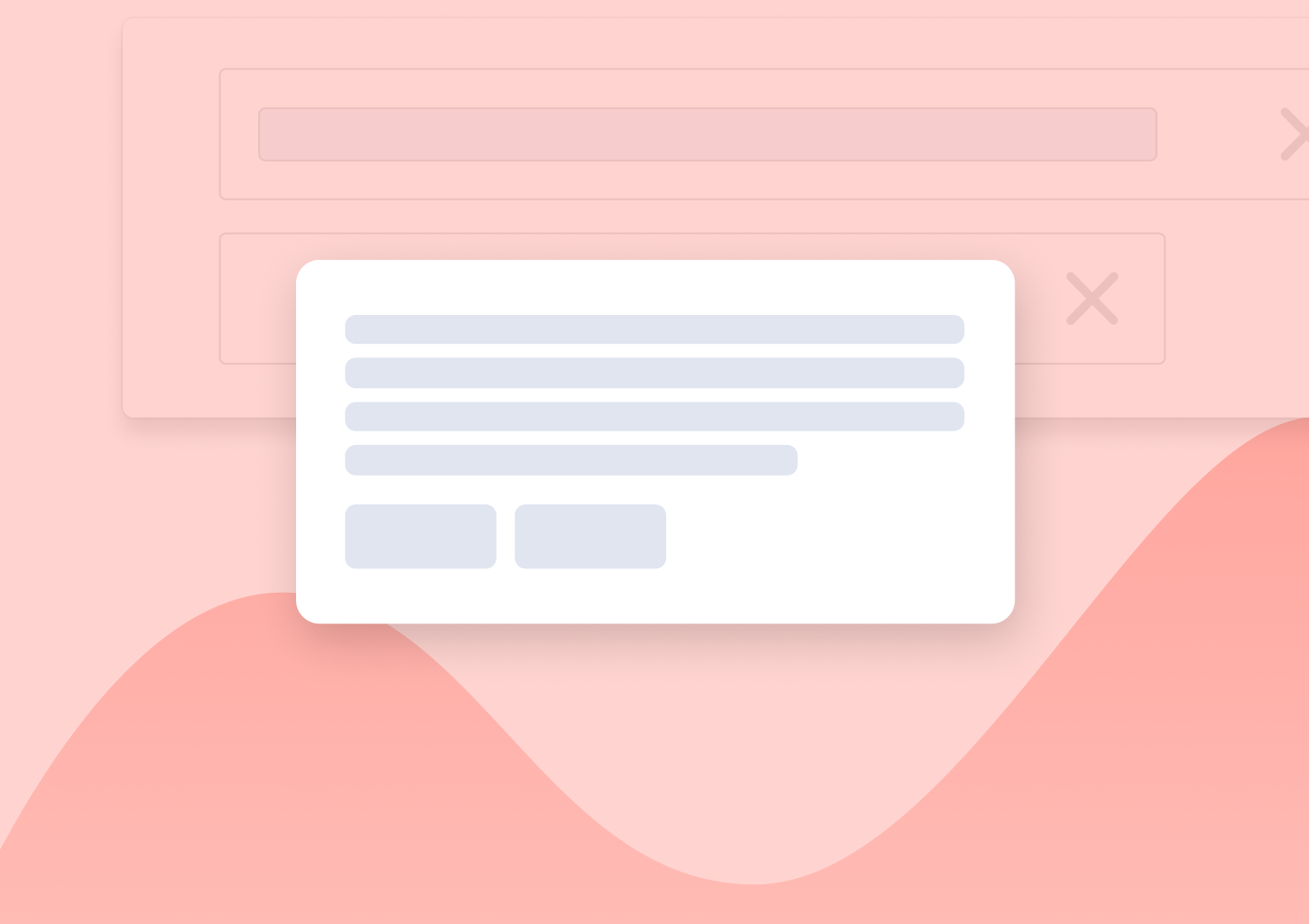
7 Best In-app Messaging Tools Today

What are In-app Notifications and Why You Must Be Using Them
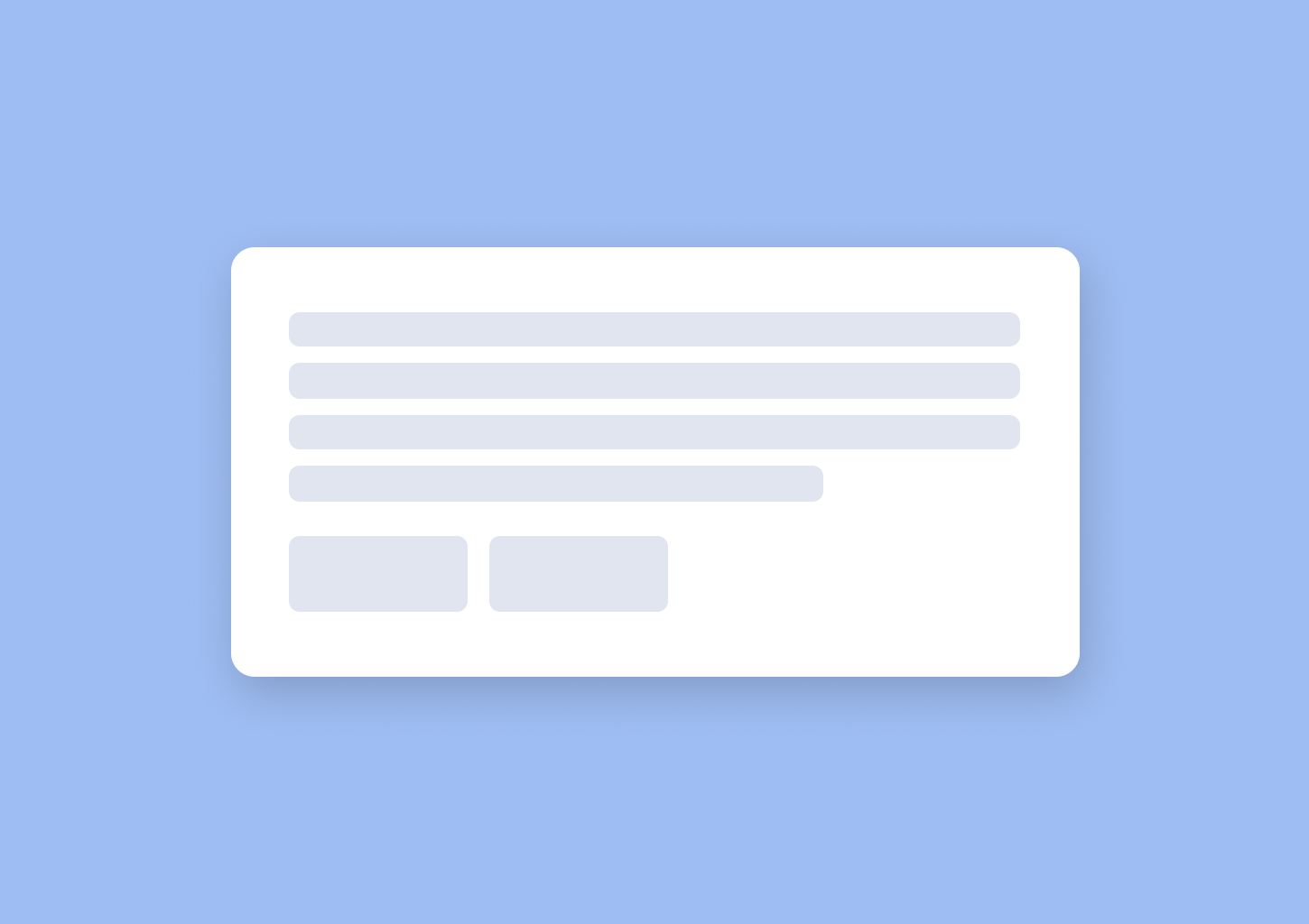
What is In-app Messaging: Everything You Need to Know

What is Product Research: A Guide for Founders
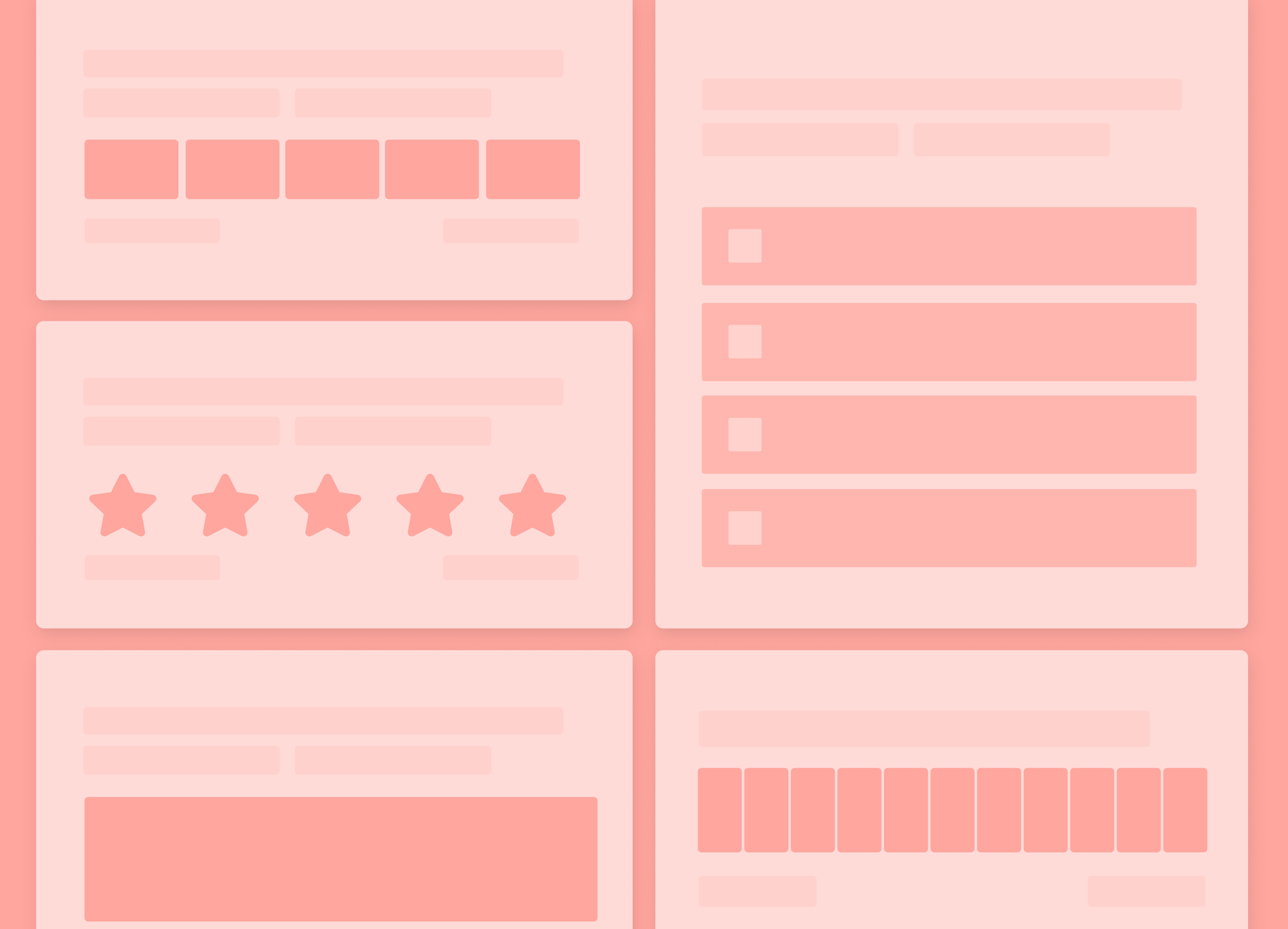
Which Survey Tool Is Best for UX Research? (10 Suggestions)

10 Questions to Ask in a Product Market Fit Survey

Product Discovery Process: The Do’s and Don’ts (and Everything Else You Need to Know)

This is How to Collect and Measure User Feedback for a Digital Product

How to Use UX Research Surveys for Product Development
- Legal Notice
- Privacy Policy
- Terms of Service
Root out friction in every digital experience, super-charge conversion rates, and optimize digital self-service
Uncover insights from any interaction, deliver AI-powered agent coaching, and reduce cost to serve
Increase revenue and loyalty with real-time insights and recommendations delivered to teams on the ground
Know how your people feel and empower managers to improve employee engagement, productivity, and retention
Take action in the moments that matter most along the employee journey and drive bottom line growth
Whatever they’re are saying, wherever they’re saying it, know exactly what’s going on with your people
Get faster, richer insights with qual and quant tools that make powerful market research available to everyone
Run concept tests, pricing studies, prototyping + more with fast, powerful studies designed by UX research experts
Track your brand performance 24/7 and act quickly to respond to opportunities and challenges in your market
Explore the platform powering Experience Management
- Free Account
- For Digital
- For Customer Care
- For Human Resources
- For Researchers
- Financial Services
- All Industries
Popular Use Cases
- Customer Experience
- Employee Experience
- Net Promoter Score
- Voice of Customer
- Customer Success Hub
- Product Documentation
- Training & Certification
- XM Institute
- Popular Resources
- Customer Stories
- Artificial Intelligence
- Market Research
- Partnerships
- Marketplace
The annual gathering of the experience leaders at the world’s iconic brands building breakthrough business results, live in Salt Lake City.
- English/AU & NZ
- Español/Europa
- Español/América Latina
- Português Brasileiro
- REQUEST DEMO
- Experience Management
Customer Satisfaction
- Customer Satisfaction (CSAT) Surveys
- What are customer satisfaction surveys?
- Why use customer satisfaction surveys
How do I measure customer satisfaction?
Types of customer experience surveys, types of customer satisfaction survey questions, additional questions to ask in your customer satisfaction survey, customer satisfaction survey design best practices, linking customer satisfaction surveys to your customer journey, how to turn your customer feedback into action, customer satisfaction survey templates, see how xm for customer frontlines works, customer satisfaction (csat) surveys: questions & template.
21 min read Consumers expect an exceptional experience with your company, and unfortunately, people talk about bad customer experiences more than they’ll brag about good ones. Read on to learn why satisfaction data is valuable information, and how to optimize your customer satisfaction surveys for useful insights.
What is customer satisfaction (CSAT) survey?
A customer satisfaction (CSAT) survey is used to determine a CSAT score by asking customers the question ‘How satisfied are you with [organization]? Answers range from 1-5 with 5 being “highly satisfied” and 1 being “highly unsatisfied”.
They are used to understand your customer’s satisfaction levels with your organization’s products, services, or experiences. This is one type of customer experience survey and can be used to gauge customers’ needs, understand problems with your products and/or services, or segment customers by their score. They often use rating scales to measure changes over time, and gain a deeper understanding of whether or not you’re meeting the customer’s expectations.
Get started with our free customer satisfaction survey template
Why use customer satisfaction surveys?
Customer satisfaction is at the core of human experience, reflecting customers’ liking of a company’s business activities. A customer satisfaction survey is a great way to understand how your customer feels about your business and their customer journey, and to nail down exactly what new customers might like about your offering.
There are several reasons why measuring your audience’s views with a customer satisfaction survey can be beneficial to your brand.
Customers will leave if they don’t feel like their experience was worth it
Our recent 2022 Global Consumer Trends Report found that 62% of customers think brands need to care about them more. With 9.5% of your revenue at risk from customers walking after a bad experience, knowing how your customers feel is financially beneficial. Gathering feedback via a customer satisfaction survey means you can figure out how to care for customers – and to monitor changes in customer sentiment before small issues become real problems.
A satisfying customer experience is worth the money for your target audience
Our research also found that 60% of consumers would buy more if businesses treated them better . Measuring which interactions and experiences your customers value will help you to judge what they will pay more for.
Satisfied customers will spread the word
Americans will mention a positive experience to an average of nine people and a negative experience to an average of 16 . This can have a knock-on effect for your brand reputation. According to Nielsen , 84% of consumers they surveyed thought word-of-mouth was the most trustworthy recommendation type. With every experience potentially attracting or pushing away future customers that hear of you this way, it’s vital to monitor how your customers feel with a customer satisfaction survey.
Satisfaction is a great indicator of retention, loyalty, and likelihood to repurchase
High levels of satisfaction (with pleasurable experiences) are strong predictors of customer and client retention and product repurchase. Customer satisfaction data that answers why loyal customers or clients enjoyed their experience helps the company recreate these experiences in the future. Effective businesses focus on creating and reinforcing world-class experiences so that they retain existing customers and add new customers.
A well-timed customer satisfaction survey can help you hone your customer journey
Mapping your customer journey is an important step of understanding your customers’ interactions with your brand – and for building out your customer lifecycle. However, it’s not enough to just create your journey map. You need to know how your customers feel at each stage of their experience with your brand, from the first interaction to getting in touch with customer service representatives, to making a purchase. A customer satisfaction survey can put your finger on the pulse of customer sentiment and give you a great sense of where your journey needs updating maximum efficacy.
To understand how satisfied your customers are, you need to understand the key drivers behind their experiences. The best way of discovering not only how your customers feel, but what has caused them to feel the way they do is by creating customer satisfaction surveys.
However, customer satisfaction feedback can be nebulous. Giving your customers a framework for their feedback – such as likelihood to recommend with a scale of 0 – 10 – can help you contrast and compare answers over time, as well as develop insights and action across multiple relationships.
Choosing the type of customer satisfaction survey you wish to create will help you to develop a metric for measuring – and improving – your customer satisfaction.
There are a few ways you can measure customer experience through customer or client satisfaction surveys. The first question you need to answer is what metrics you want to use.
The most commonly used metrics are:
- Net Promoter Score (NPS) ® – Probably the most popular measure of customer affinity towards your company. Created and trademarked by Bain & Company, the net promoter system involves a quick survey that typically asks “How likely are you to recommend [company name] to a friend” with a Likert scale question from 0-10
- Customer Effort Score (CES) – This metric measures how hard it was for a customer to be able to complete the task that prompted their interaction. This survey question could look like, “How easy was it to deal with our company today?” This survey and measurement system can be useful for post-interaction surveys with customer service or support teams
- Customer Satisfaction (CSAT) – This is a commonly used measure for product and services to rate how happy consumers are with what they purchased. The typical survey question to collect this feedback looks like, “How would you rate your overall satisfaction with the [goods/service] you received?” then offers a Likert scale question type between 1-5 with 5 being “highly satisfied” and 1 being “highly unsatisfied”
In this article, we will be focusing on customer satisfaction surveys (CSAT).
When building your customer satisfaction survey questions, the type of question you choose to ask can make a big difference to the insights you receive and your ability to improve the experience.
Here are the types and some sample customer satisfaction (CSAT) questions to help you decide which will get you the answers you’re looking for.
Likert scale questions
A Likert Scale question provides customers with options for their response from one extreme to another (i.e. satisfied to unsatisfied), with or without a neutral response.
For example, a five-point Likert scale question might look like this:
How satisfied are you with our service?
- Very satisfied
- Moderately satisfied
- Neither satisfied nor dissatisfied
- Moderately dissatisfied
- Very dissatisfied
An even Likert scale question removes the middle response to provide a binary choice.
These types of customer satisfaction survey questions are simple to understand and answer, and will provide you with quantifiable customer satisfaction data.
However, the real attitude of your customers can’t usually be deduced by just this type of question alone. Customers might have specific drivers that aren’t highlighted by this question, or they might feel reluctant to choose an “extreme” option, even if it is true for their experience.
Binary questions
Binary questions provide you with the quickest response to any feedback survey question. By asking a simple yes/no question (or its equivalent), you can get the general sense of whether customers’ needs have been met.
For example, you could ask:
Were you satisfied with your experience with us?
[Smiley face/Unhappy face]
Did you find what you were looking for today?
Again, this does not provide you with the full context of their answer.
Multiple choice questions
Multiple choice questions can enable you to find out more about customers and their experiences.
Which of our services was most useful for you today?
[Service A] [Service B] [Service C]
This type of question can be more leading for your customers, as you are providing the text answers for them to choose from. However, it can offer you more insight than a simple binary or Likert scale question.
Open-ended questions
This type of question allows your customer to provide a description in their own words of how satisfied they are with your products or services.
What could we have improved on today?
[Open text box]
Open-ended questions can give you a much more specific insight into a particular customer’s problems or highlights. However, they are also higher effort for your customers – which may put them off responding.
Get started with our free Customer Satisfaction Survey template
Adding additional questions can help you sort through and take action on your customer feedback — just remember that shorter is generally better when it comes to survey completion rate.
Usage frequency
Edit the usage frequency options below so that they are relevant to your industry or product. This helps you understand the user’s skill level with your product/service.
- Once a Month
- Every 2-3 Months
- 2-3 Times a Month
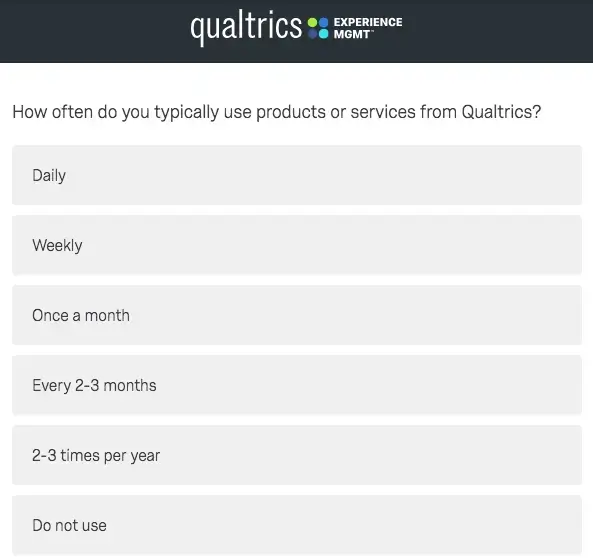
Product and usage survey questions
Product and usage survey questions can give you greater insight into how your customer base uses your products and services. Not only that, but you can learn more about how they feel about them as well. This can help inform not only how you approach customers, but also with your product development efforts. Incorporating customer feedback about your products, you know how to better meet their needs and improve their experience.
Product and usage survey questions you could ask include:
- How often do you use our products/services?
- Which key features of our products/our services are the most useful?
- How easy do you find our products/our services to use?
- Do our products/services provide value for money?
- Are there any features that you would like to see in our products/services?
- What problem are you trying to solve by using our products/our services?
Demographic Questions
Demographic questions can be helpful in understanding what audiences or customer segments you are excelling with or under serving. We recommend getting as much of this data from your customer database or CRM, instead of asking for it in a survey whenever possible. Below are some potential demographic questions you can add to your customer satisfaction survey.
- Employment Status
- Household Income
- Marital Status
- Children/dependents
- Location (zip code)
- Ethnic background
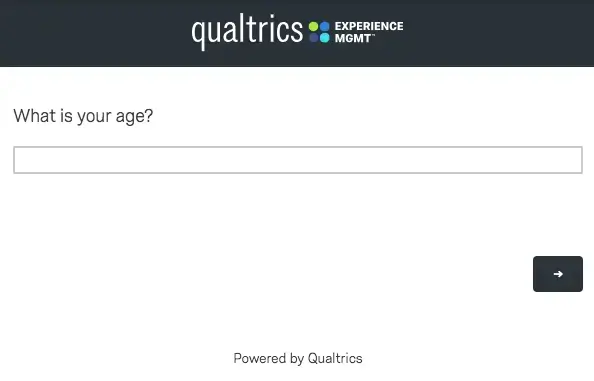
Psychographic survey questions
Unlike demographic survey questions, psychographic survey questions are more focused on psychological criteria. These questions can cover activities, interests and opinions, giving you a fuller picture of your customer profile. These questions can be open-ended, binary or multiple choice.
Psychographic questions might cover:
- Attitudes toward a certain product or service
- Religious beliefs
- Political affiliations
- Likes and dislikes towards certain topics
- Personal reasons behind purchases
Satisfaction category questions
This type of question helps you identify satisfaction key drivers and highlight the areas of a customer’s experience that are important, allowing you to align product and service priorities. Below are potential categories of drivers.
- Overall Quality
- Purchase Experience
- Installation/Onboarding
- Warranty/Repair Experience
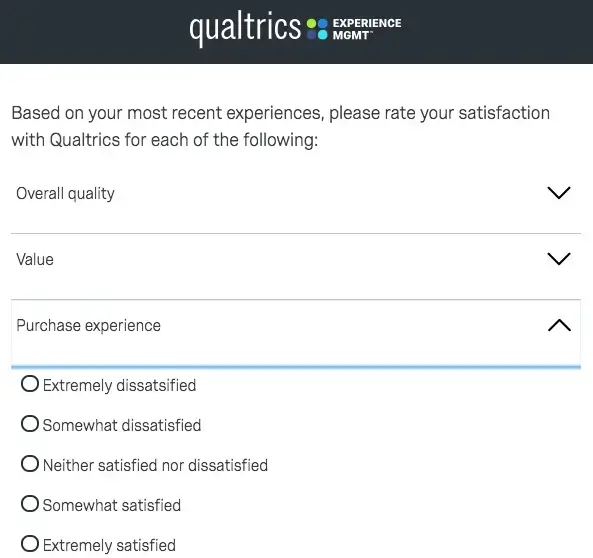
Open text feedback question
This question allows customers to provide unsolicited open-text feedback and their response to your customer satisfaction survey and mention specific topics or experiences for your team to review.
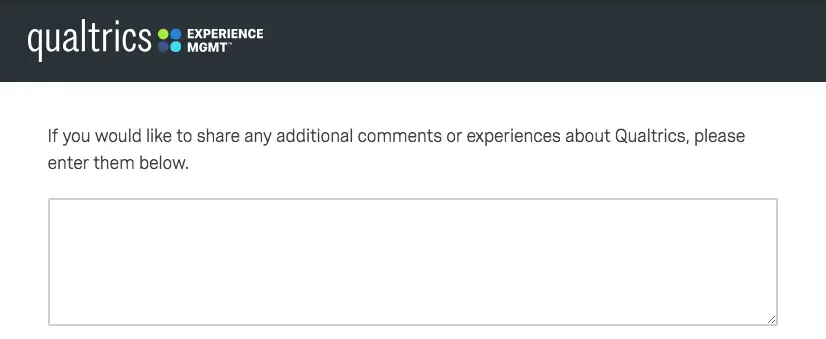
Action/ follow-up questions
This is a simple question asking if it’s okay if a member of the team reaches out to the respondent to try and understand and resolve any pain points.
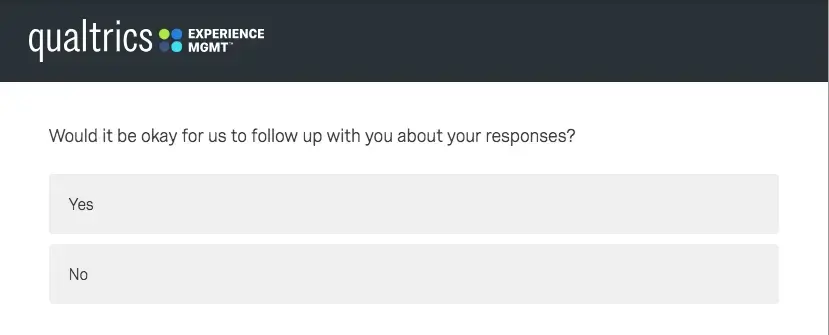
Properly constructed customer satisfaction surveys and questionnaires provide the insights that are the foundation for benchmarking customer happiness. Depending on what customer metrics you intend to use, it will determine what type of survey questions you need to ask your customers. Below are a few best practices:
- Ask for overall company rating first – This satisfaction survey question gives you great initial insight and allows you to compare to industry and internal benchmarks over time.
- Allow for open text feedback – Open text questions allow you to collect open-ended responses from your respondents. You can gain more detail about your customer’s experiences and you might uncover new insights you didn’t expect.
- Optimize for mobile – Many consumers are now completing surveys on mobile devices or within mobile apps, so your survey must be optimized for mobile devices . If it is too complicated for a mobile respondent, survey participation will decrease.
- Ask double-barrel questions – These questions touch on more than one issue, but only allow for one response. They are confusing for the respondent, and you’ll get skewed data because you don’t know which question the respondent is answering.
- Make the survey too long – The majority of CSAT surveys should be less than 10 questions. People won’t finish long surveys.
- Use internal or industry jargon- Your customers must be able to clearly understand each question without hesitation and using internal or industry jargon is confusing to respondents.
Asking your customers about their experiences at any time might seem useful, but ideally you will link your customer satisfaction survey to specific points in the customer journey. Proper timing of customer satisfaction surveys depends on the type of product or service provided, the type and number of customers served, the longevity and frequency of customer/supplier interactions, and the intended use of the results.
Nevertheless, timing when to send a customer satisfaction survey is extremely important no matter the circumstances.
Best practices include:
- Asking for responses shortly after the customer journey touchpoint has occurred: The experience should be fresh in your respondent’s mind so you get the most honest answers and gain insights that are accurate.
- Use multiple channels to give customers options they’ll prefer: You can solicit feedback face-to-face when they leave your store, email, online survey, phone, or within your mobile app.
- Avoid survey fatigue: Don’t quiz the same customers again and again throughout all the points of their journey – figure out when delivering a survey will give you the most useful insights.
- Take action once you have customer satisfaction data: There’s no use learning that part of your journey puts off your customers and then leaving the problem to fester. Take action to make changes once you know what experiences make customers feel less satisfied.
Delivering customer satisfaction surveys at the right points in the journey
Let’s look at an example of a customer journey from the airline industry. A customer satisfaction survey can be sent at every touchpoint in the process.
- After the customer books their flight – Feedback after the initial purchase is important because you want to understand if the person was satisfied with their checkout or purchase experience. Send an email with a link to an online survey after the customer purchases their flight to find out how satisfied they were with the booking process. Consumers want easy transactions, so look for ease-of-use in your data.
- After the actual flight – Post-purchase evaluations reflect the satisfaction of the individual customer at the time of product or service delivery (or shortly thereafter). This can be a transactional NPS or customer satisfaction survey and sent by email.
- After a customer service encounter- If the customer initiates contact with a customer service representative, a customer effort score (CES) survey should be sent immediately after the issue was resolved. For airlines, this could be a call to change a flight date or report lost baggage. The goal is to see how much effort it took to resolve the issue.
- Six months after the flight – To measure the long-term customer loyalty, relational NPS or CSAT surveys can be sent months after the transaction occurred to see if your customers are still loyal to your brand.
- In-app mobile feedback – You can request customer feedback on the mobile app or customer experience through a feedback tab in the app. Getting mobile app feedback is important — only your customers can tell you what will make them more satisfied with their experience.
Measuring customer satisfaction is important but what you do with the data is essential. If your customers take the time to fill out a survey, it’s important they know you’re serious about improving their experience.
- Close the loop – Respond quickly after receiving negative feedback from your customers. This is a chance to keep your customer loyal. 70 percent of consumers said they would be more likely to do business with an organization again if their complaint was handled well the first time.
- Analyze for trends – Understand what metrics you’re looking to improve and see if there are patterns on these specific items. For instance, if 30 percent of respondents say the customer service wait time was too long, you know you need to improve in that area.
- Company-wide effort- Every department must be on board to keep the customer satisfied. If customers complain about a product feature, the product department must be willing to receive the data and fix it. If customers complain about the service, customer service representatives need to understand how to fix the issues more effectively. Make sure the right people have the right visibility with role-based CX dashboards and analytics .
Do you want to go deeper into customer insights and create loyal and satisfied customers?
Though looking at customer satisfaction survey examples is helpful, we’ve gone one step further to create a customer satisfaction survey template to get you started.
Our prebuilt customer satisfaction survey template can be used in your customer experience management (CXM) to start properly measuring customer satisfaction. Keep in mind, all of these customer satisfaction surveys can be used today when you sign up for a FREE Qualtrics account .
Other Customer Feedback Resources:
- Customer Feedback – What to Collect and When
- Omni Channel Customer Feedback
- How to increase survey response rates
Related resources
Measuring customer satisfaction 22 min read, what is csat 8 min read, customer delight 18 min read, improving customer satisfaction 11 min read, customer satisfaction 16 min read.
Customer Journey
Customer Interactions 11 min read
Customer Service
Customer Service Experience 13 min read
Request demo.
Ready to learn more about Qualtrics?
23 Excellent Customer Satisfaction Survey Examples [+ Templates]
Published: May 30, 2023
Your product or service revolves around your customers and their experience.

How do you gauge their satisfaction or dissatisfaction with your products? And, how do you decide to work on a new feature if you don’t know whether the customer needs it or not?
This is where customer satisfaction surveys come in, as their results let you know exactly how your customers are feeling — how satisfied they are.
![research questions on client satisfaction → Free Download: 5 Customer Survey Templates [Access Now]](https://no-cache.hubspot.com/cta/default/53/9d36416b-3b0d-470c-a707-269296bb8683.png)
This journey of providing your customers with a positive experience starts from the moment they land on your website and extends beyond the moment they become your customer. Without question, delighting them and encouraging them to become loyal customers is a never-ending commitment. As Derek Sivers from CD Baby puts it, “Customer service is the new marketing.” And that couldn't be truer.
In this post, we’ll cover:
The Importance of Customer Satisfaction Surveys
Customer satisfaction survey questions, best practices for creating customer satisfaction surveys, customer satisfaction survey template.
- Customer Satisfaction Survey Examples
.webp)
5 Free Customer Satisfaction Survey Templates
Easily measure customer satisfaction and begin to improve your customer experience.
- Net Promoter Score
- Customer Effort Score
You're all set!
Click this link to access this resource at any time.
Tell us a little about yourself below to access the templates
Customer satisfaction surveys help businesses better understand and utilize the voice of the customer to sustain growth. There are several key reasons above and beyond this overarching goal that make customer satisfaction surveys a top priority for customer centric businesses.
1. Identifying negative themes in the customer experience: By conducting customer satisfaction surveys, companies can pinpoint negative themes that customers are having and work to resolve them. This helps improve the overall customer experience and increases customer loyalty.
2. Gauging customer loyalty: These surveys give customers a chance to share feedback that yields their propensity to be a loyal customer. Companies can use this information to better retain customers.
3. I dentifying customer trends: Surveys allow companies to identify trends in customer satisfaction over time. For example, if several customers have the same complaint about a product, there may be a shift happening in the market that your business hasn't noticed yet. Acting on this feedback can keep your business ahead of the curve to not only keep existing customers, but acquire new ones who are interested in that same trend.
4. Providing a competitive advantage: Companies that regularly conduct customer satisfaction surveys and make adjustments based on feedback are likely to outperform their competitors. This is because they are better able to meet customer needs and expectations.
5. Validating business decisions: Customer opinions and feedback are two of the most essential factors that validate decisions within your business, allowing you to become more equipped to meet their specific and immediate needs instead of basing your strategy on assumptions.
6. Shaping the customer lifecycle: Their opinions also shape the customer lifecycle. If you don’t know their thoughts, you have a lower chance of retaining them, delighting them, or enticing them to make future purchases.
With all of this in mind, you get opinions and information about satisfaction levels through your customer satisfaction surveys. Without them, you’d never know how your customers were feeling, and you’d never be able to meet their needs.
- What is your level of education?
- What is your approximate annual household income?
- Where do you work and what’s your job title?
- What industry are you in?
- What’s your most important priority when (insert something related to your industry)?
- What’s your biggest roadblock when (insert something related to your product)?
- On a scale of 1 to 10, how satisfied are you with your in-store experience today?
- How likely are you to recommend (insert product or service) to others?
- Rate your satisfaction with our team in resolving your issue.
- Did you feel that our team answered your inquiry promptly?
- Do you agree or disagree that your issue was effectively resolved?
- How likely are you to purchase again from us?
- How likely are you to return to our website?
- In your own words, describe how you feel about (insert company name or product here).
- How can we improve your experience with the company?
- What's working for you and why?
- What can our employees do better?
- How can our employees better support your business’s/your goals?
- How can we improve your experience with the website or the in-store location?
- Why did you choose our product over a competitor’s?
- What would be one word you’d use to describe us and why?
- May we contact you to follow up on these responses?
- In the future, would you be willing to take this survey again?
- If we were to update (insert product feature here), could we reach back out to talk about these changes?
- Can we connect you with a customer success manager via chat?
- Would you be open to discussing upgrade options for your product?
- Can we send you a list of useful resources for getting the most out of your product?
- How long have you been using the product?
- Which alternatives did you consider before purchasing the product?
- How often do you use the product or service?
- Does the product help you achieve your goals?
- What is your favorite tool or portion of the product or service?
If you want to obtain valuable feedback from your customers, then you have to ask them the right questions. Sharing information isn't always an easy task, and it's not the customer's job to provide your business with constructive criticism. Instead, it's the surveyor's responsibility to create a thought-provoking prompt that engages the participant.
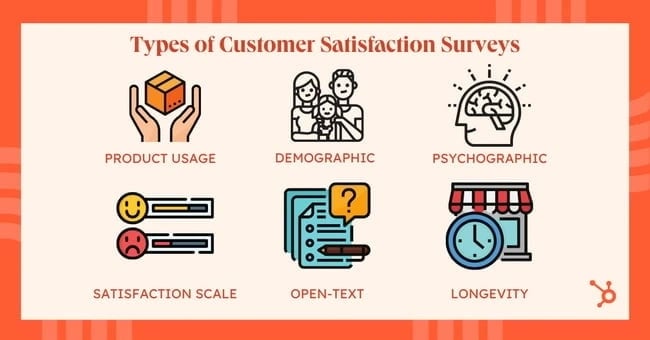
Customer Feedback Questions
To get the most out of customer feedback you’ll need to make sure you’re asking the right questions. Open-ended questions are a great way to gain more thorough explanations about your customer’s experience with your brand, but they’re not the only types of questions you can ask.
If you're getting stuck on deciding what to ask your customers, here are some of the types of questions we recommend including on your customer satisfaction survey:
Product Usage
When it comes to customer success and satisfaction, your business must collect feedback about your product or service. If you don't, then it's more difficult to assess customer needs and provide effective solutions.
Finding out how satisfied your users are with your offer provides your marketing and product teams with valuable information that can be used to improve customer retention .
Some questions that you could ask in this section are:
- What would you improve if you could?
- Which product features do you consider the most valuable?
- Which product feature do you use most often in your day-to-day ?
- What points of friction have you encountered while using the product?
- If there was one new feature you could suggest, what would it be and why?
Demographics
Demographics are essential to marketing and sales teams because they make it easier for companies to segment customers into buyer personas . By grouping customers based on key characteristics, this categorization helps employees visualize their target audience. Marketing and sales teams can then use that information to pursue leads that are most likely to convert.
When asking these types of questions, be sure to embrace a proactive and inclusive approach. These questions shouldn't be mandatory, so always provide an option for customers to omit an answer. Your goal is to extract honest information, but you don't want it to come at the expense of the customer's comfort.
Here are some demographics questions that you should consider including in your next survey:
- How old are you?
- Where are you located?
- If applicable, what gender do you identify as?
- What is your employment status?
- What is your marital status and do you have children?
Psychographics
Psychographic questions dig deeper than demographic questions, uncovering information relating to your customers’ preferences, habits, behaviors, and tendencies. It’s not about who your customer is, but why they do what they do.
Psychographic questions may seem intrusive, but they’re highly valuable pieces of information that give you a glimpse into the reasons for your customer’s buying habits. They’re usually phrased concerning your industry and not specifically about your product.
These questions are instrumental in customer satisfaction surveys because you can indirectly find out how you can better serve your customers.
Here are a few questions you might ask:
- Do you prefer to shop on your phone or your laptop?
- E.g. if you’re a mortgage lender, you might ask, “What’s your most important priority when buying a home?”
- E.g. if you’ve created a recipe-sharing app, you might ask, “What’s your biggest roadblock when trying to access the best recipes online?”
- How much time do you spend on (insert social media platform you’d like to use for advertising)?
- How much does sustainability matter to you in purchasing a product?
- How do you feel about (insert product type)?
- E.g, if you sell women’s razors, you might ask, “How do you feel about women’s razors?”
- What do you dislike about (insert product type)?
- How many hours a day do you spend doing (insert something that relates to your product)?
- E.g. if you sell ergonomic car seats, you might ask, “How many hours do you spend driving?”
Satisfaction Scale
Sometimes there are aspects of your offer or business that you want feedback on, but they aren't things that your customers are actively addressing. In these cases, it helps to be direct and ask customers how they feel about these specific details.
Before you do, you'll have to determine a quantifiable way to measure their responses. Adopting a satisfaction scale section is a great way to create a consistent approach to quantifying this subjective survey feedback. A few ways that you can implement this scale are:
- A scale measuring from 1 to 10 (or another number). 1 means the customer was extremely unsatisfied and 10 means the customer was very satisfied.
- A descriptive scale that measures a customer's response from unsatisfied to satisfied. The customer is given a shortlist of responses to choose from that range from “very unsatisfied” to “very satisfied."
- A picture scale that uses images to symbolize customer satisfaction. For example, you can use happy, sad, and indifferent emojis to quickly gather customer feedback.
Example questions include:
Open-text questions are survey questions that allow the participant to write out their response within a text box. This allows users to fully express their opinions using the customer's voice instead of the company's pre-written responses.
While they can sometimes be time-consuming to analyze, these questions encourage the participant to be honest and give them the freedom to address any topic. Open-text questions can be an instrumental asset when determining the core values of your customers.
Here are open-text questions you can ask in your next survey:
- Do you have any additional comments or feedback for us?
In the last section of your survey, you'll want to include questions about the steps that'll happen after submission. These questions permit your team to follow up with the participant in the future.
This comes in handy when you roll out changes and want to get updated feedback from the same customers that were surveyed earlier. You can phrase these types of questions in a few different ways:
While measuring customer satisfaction can be tricky to manage, asking effective questions can reveal highly valuable customer insights — and the questions we’ve listed above will do the trick.
Next, we’ll go over best practices for creating customer satisfaction surveys.
- Make sure you choose the right survey tool.
- Always ask short and relevant survey questions.
- Send the surveys at the right time.
- Always A/B test your surveys.
- Thank your customers for their feedback.
Designing a customer satisfaction survey is no easy task. Luckily, there are a few best practices that will help you increase response rates and get much-needed feedback from your customers.
1. Make sure you choose the right survey tool.
Choosing the right survey tool is important because it can significantly impact the quality of your results. A good survey tool should be easy to use, customizable, and be able to provide in-depth analytics. It should also have the ability to automate survey distribution and analysis.
Without the right customer survey feedback tool , you’ll have a whole lot of data and no way to distill it or glean valuable insights from it. Choose a tool that gives you the ability to ask different types of questions, examine basic metrics such as response rates, and track customer sentiment over time.
2. Always ask short and relevant survey questions.
No one enjoys spending a lot of time answering surveys, so be sure to keep your survey questions short and to the point. Asking short and relevant survey questions is the key to earning high completion rates. Long and complex survey questions can be overwhelming and may discourage customers from providing any feedback at all.
On the other hand, shorter questions allow customers to easily comprehend what is being asked and are more likely to provide accurate responses. When asking open-ended questions, keep the minimum character count short, make the question optional, or offer an incentive.
3. Send the surveys at the right time.
Give a lot of thought to the placement of your surveys throughout the customer journey. It wouldn’t make sense to send a survey to someone who’s only just subscribed to your blog — nor would it make sense to send one year after a customer stopped doing business with you.
Sending surveys at the right time is critical to getting accurate feedback. Customers are more likely to provide feedback when they are in a position to evaluate their experience with your company.
When do you send a customer service survey? Send it after a lengthy interaction with one of your teams, a few weeks after purchase or onboarding, and a few times throughout the year to measure the customer’s happiness.
4. Always A/B test your surveys.
A/B testing is an excellent way to find out whether your surveys are as effective as they can be. Simply create two versions of the survey with minimal changes. You can change the order of the questions, the number of questions, the wording, and even the color of the buttons. (Change only one thing at a time so you can accurately measure its impact on the survey.)
By comparing the results of each version, you can determine which version yields the highest response rate and provides the most accurate feedback. This can help you refine your survey strategy and improve the overall quality of your survey data.
5. Thank your customers for their feedback.
Thanking customers for their feedback is important to show that you value their opinion and are committed to improving the customer experience. It also helps to improve customer loyalty and increases the likelihood that they will provide feedback in the future.
Whether it’s through a gift card, a discount, or simply a nice email, always thank the customer for their time, regardless of the nature of the feedback.
By thanking customers for their feedback, you signal that you take their opinions seriously and are committed to addressing their concerns. This can help you maintain strong relationships with your customers and drive long-term business success.
Ready to craft your own customer satisfaction survey? Use the template in the next section to get started.
How To Use Customer Satisfaction Survey Results
1. define customer segments..
Customer satisfaction surveys can be used to segment customers based on their preferences. With these survey results, you can tailor your approach to specific customer groups and provide more personalized experiences.
2. Track customer satisfaction over time.
Identifying changes in customer sentiment can be difficult if you don't have multiple data points over a long period of time. Regular customer satisfaction surveys can be used to track this and address issues before they become systemic problems.
3. Benchmark against competitors.
Customer satisfaction survey results can be used to benchmark your company’s performance against competitors. This way, you'll identify areas where your company may be falling short and implement changes to improve your standing in the market.
The following customer satisfaction survey template can help you get answers from your customers in one easy step. It asks one simple question: “How satisfied were you with your experience today?” If you’d like, you can add more questions to get more details from your customers.
To make a copy of this template and get 4 bonus templates, click here .

Now you’ve got a template and are ready to create your customer satisfaction survey. In need of some inspiration? Take a look at these examples we pulled from different companies.
Customer Satisfaction Survey Examples from Real Brands
We’ve covered why asking for customer feedback is important and the types of questions to include, but you still might be wondering how to put it all together. Let’s check out the customer feedback example questions below from real companies to gain insight into how to roll out a survey of your own.
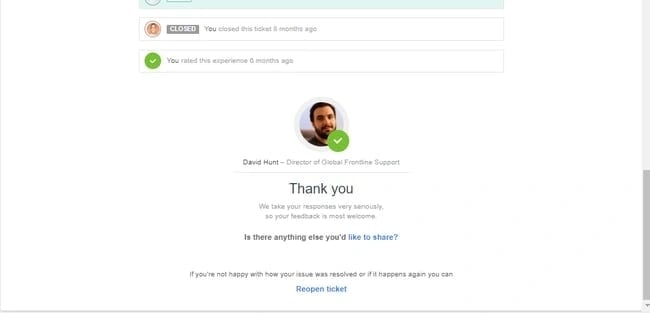
HubSpot is another company that uses NPS surveys to assess customer satisfaction. This score primarily comes into play with its customer support and success teams, who can be reviewed after each new interaction.
HubSpot's engineers then use these responses to address areas in their software that could use improvement. By using this scoring system, HubSpot can attain both qualitative and quantitative data to direct its product development efforts.
What we like:
HubSpot uses its surveys to create product-level improvements, and the best part is that for customers, answering one question is an effortless way to give feedback. So it’s a win-win on both sides. When you carry out surveys, be sure to forward the feedback to the right department to address any issue that your customers brought up.
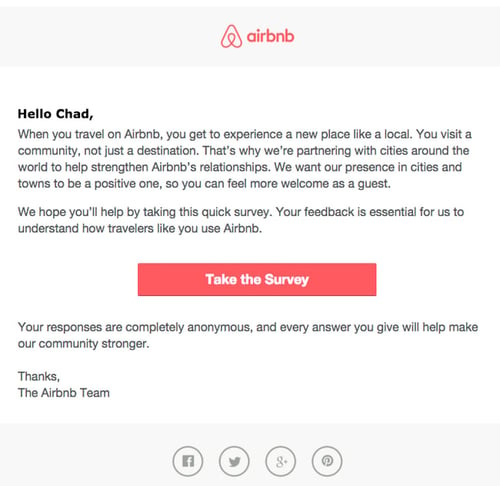
The Hilton Hotel company provides its customers overnight stays with promising customer service, upholding its century-old reputation.
To better understand what people’s stays were like, it offers a one-page survey where customers can willingly submit their feedback. It’s just a few questions long, most of which are logistical (such as where the visitor stayed and how long they stayed there for). Users then have the option of elaborating.
This seemingly simple survey from Hilton gives unhappy guests an easy, friction-free opportunity to submit feedback about their recent stay. It’s hosted on a public URL that guests can access without needing to get through any barriers. The questions are simple and easy to answer.
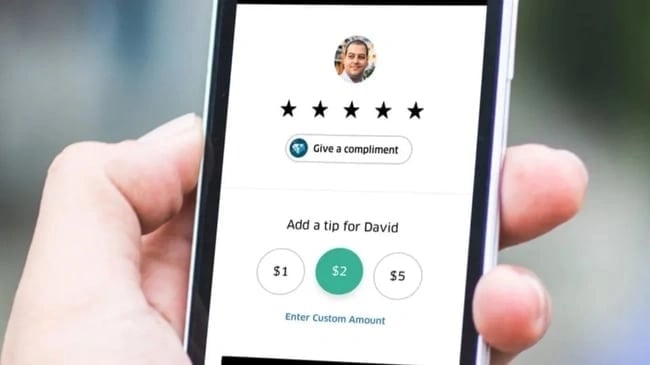
Uber has two target audiences — the drivers and the passengers — and it does a great job collecting opinions and reviews from both. The passengers give ratings after every ride, and the drivers rate the passengers as well.
This survey makes it fair and transparent for both the driver and the passenger, and these ratings affect both parties’ reputation as well. If a passenger has a lower rating, the driver has the authority to decline the booking. If you run a business with two target audiences, create a survey for both.
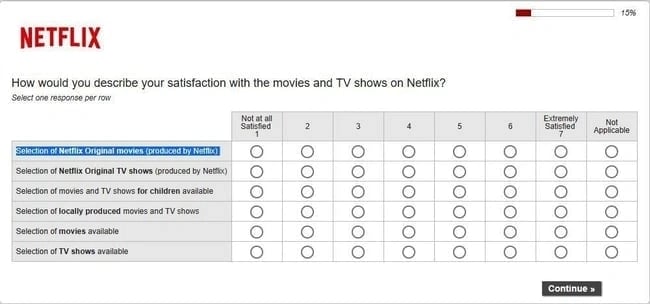
Netflix provides its customers with curated entertainment recommendations that would not be possible unless they had a great understanding of customer satisfaction.
Overall, Netflix brings out its A-game when it comes to customer experience. With its recommendation system, it is as customer-friendly as one can get. Netflix studies the behavior of all of its customers and recommends movies and shows per their ratings, likes and dislikes, or just what they have been watching. It also collects feedback periodically to improve its offerings.
In this survey, Netflix tries to better understand users’ behaviors and preferences. This shows that even if you dominate the market like Netflix does , you shouldn’t stop there. Continue collecting feedback from your customers and users, and don’t be afraid to get granular to understand their needs.
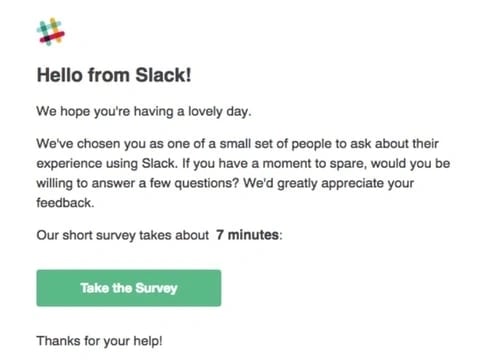
Slack is a business messaging app that helps professionals connect from anywhere. It bases its product development entirely on customer feedback.
In fact, customer feedback is at the epicenter of its efforts. For instance, there's a command within the application where users can send feedback to the Slack team, or just tell them what features the users would like to have. The co-founders read all the user feedback and made sure they responded to every ticket raised.
In the email above, Slack invites the user to take a survey to improve its offering. The email is short and to the point.
Slack’s commitment to collecting customer feedback is commendable, and so are its invitations to take the survey. In the above example, Slack makes the survey seem more exclusive by mentioning that it was only sent to a few people. Don’t be afraid to curate a short list of customers to send the survey to, especially if it seems like those customers would be more likely to answer.
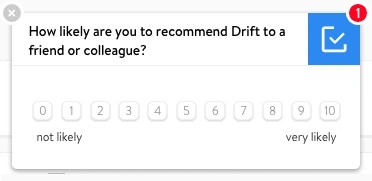
Drift provides businesses with a revenue acceleration platform that caters to a buyer-centric world. The above survey asks one simple question: “How likely are you to recommend Drift to a friend or colleague?” Sometimes, that’s really all you need.
Drift sends Net Promoter Score®, or NPS, surveys. NPS is a critical SaaS metric used to measure customer satisfaction. The only question it asks is whether the customer is likely to recommend the business to a friend or colleague — and this can be enough of an indicator of a customer’s happiness with your brand.
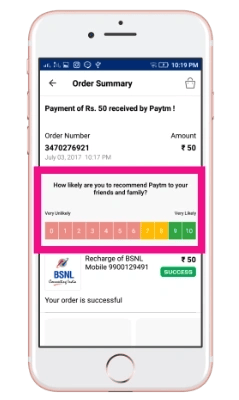
Paytm has always taken customer opinions into account and has taken serious steps to improve the customer experience.
Taking customer experience and security to another level, Paytm has created a “ bug bounty ” to catch fraudulent merchants. If customers accidentally buy fake movie tickets through the platform, for example, Paytm allows them to get refunds on their bookings.
Paytm gives users the opportunity to tangibly improve the product by giving them the ability to report bugs directly on the app. Plus, it not only collects customer feedback, it acts on it, too, by fixing those bugs. Overall, Paytm provides plenty of avenues for turning an unhappy customer into a happy one.
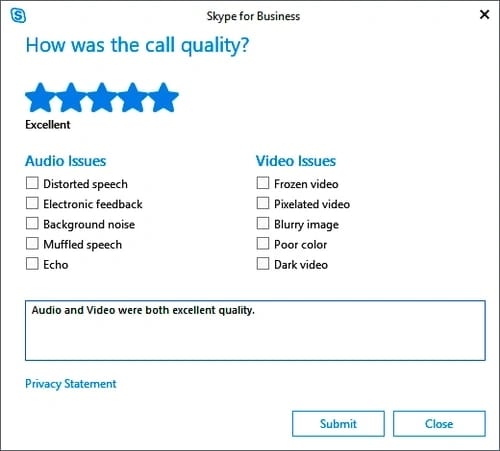
Another example of a product that provides great customer service is Skype, a business recognized for its telecommunication technology. If you call people using Skype, you know that it asks for feedback after every call. But more than that, it believes in immediately solving customers’ problems.
In the survey above, Skype asks for feedback on the quality of the call. It’s just three questions long, and when it comes to surveys, the shorter, the better. It also gives users the ability to quickly answer the questions by offering multiple choices instead of letting them write out an answer (though they have that option, too).
Skype gets straight to the point in this simple three-question customer satisfaction survey. Even more, it keeps the focus on the product by only asking about “Audio Issues” and “Video Issues.” If you sell a product where users might run into issues, consider asking targeted product performance questions, then leave a blank text box for users to elaborate.
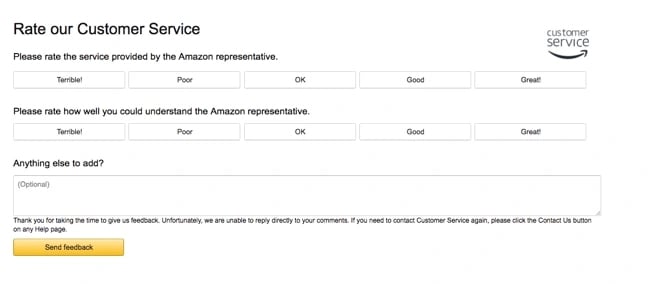
Amazon, one of the most popular eCommerce websites in the globe, exceeds user expectations by collecting all kinds of information. When you contact its customer service department, it sends you a customer feedback survey that asks three questions about your interaction:
- Please rate the service provided by the Amazon representative.
- Please rate how well you could understand the Amazon representative.
- Anything else to add?
But Amazon doesn’t stop there. It makes information easily accessible in a knowledge base , so users can find answers and troubleshoot on their own. This reduces the chances of incorrect purchases, which can make all the difference in a customer's buying decisions.
Amazon’s customer satisfaction survey is a great way to gauge how happy the customer is after getting help from the customer service team. It’s important because customers only reach out when they’re unhappy — so sending a survey like this one helps Amazon understand whether the customer is happy again. Like Amazon, be sure to send surveys after your customers interact with your service team.
10. Twitter
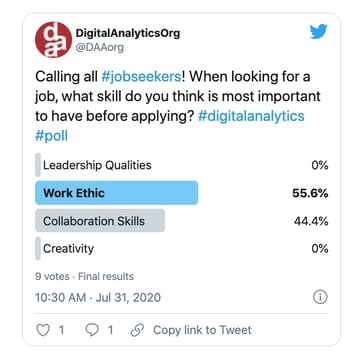
Zomato is one of the largest food delivery and review websites in the world, and its success can be largely attributed to customer satisfaction.
Another product with two types of audiences — restaurants and hungry diners — Zomato puts both of their needs and expectations into consideration. Every restaurant gets rated on the food, and every buyer gets to rate the restaurants. In the above survey, it asks for feedback with one simple statement:
“Tell us what you love about the app, or what we could be doing better.”
Then it allows users to free-write their thoughts.
This open-ended survey format is perfect for websites and apps. You would ideally always include the option to give feedback in a pop-up button, banner, or tab that users can click. That way, you don’t need to contact users first; they can voluntarily submit feedback to you.
12. Greyhound
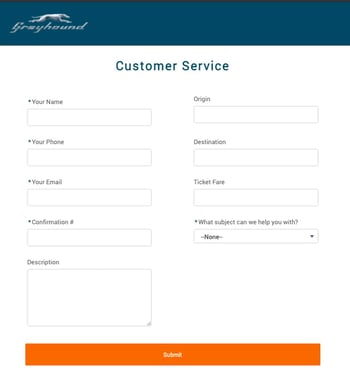
H&R Block Advisors sent another well-timed customer satisfaction survey — just after “Tax Season” in the U.S.
For accountants and financial advisors, the months before the tax filing deadline are the busiest, so a prompt survey after filing with H&R Block helps the company gauge how many returning customers it can expect.
H&R Block Advisors smartly sends the survey at a busy time for its business. If your business also has busy periods or periods where people are more interested in your products, send surveys during those time ranges to optimize the amount of responses you receive. You’ll get more submissions simply because you have more customers during those months.
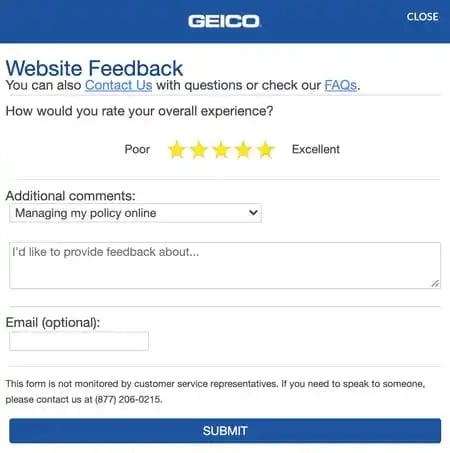
Measuring sentiment, in addition to satisfaction, is important when surveying your customers.
In this survey, GEICO asks about customer sentiment regarding a specific interaction during the purchase process — and the general feeling of the experience as well. In this way, GEICO can smooth out specific roadblocks throughout the customer journey, and get an in-the-moment snapshot of its wider customer sentiment.
GEICO’s example is simple, short, and to-the-point. It only has three questions and gives an additional avenue for contacting GEICO’s customer service team. Always give respondents a second option for submitting feedback or contacting your team to better gauge how satisfied they are with your brand.
16. Taco Bell

HubSpot for WordPress is a plugin that adds CRM functionalities, forms, and live chat to WordPress websites. In this survey, HubSpot aims to find out whether the plugin has been working as designed. It has just one simple request: “Rate your experience using HubSpot for WordPress.”
We recommend using this format for product-related surveys — specifically those that have to do with a single specific feature. For instance, if you recently rolled out a new update, this single-question survey can help you measure your customers’ opinions about the new addition to their software or product.
The five-star scale is simple to understand and makes it easy to answer, because all the user has to do is provide a star rating. The users can also answer straight in their email, instead of needing to access an external survey link. Sometimes, you don’t need to include complicated questions and options to create an effective customer satisfaction survey.
19. McDonald's
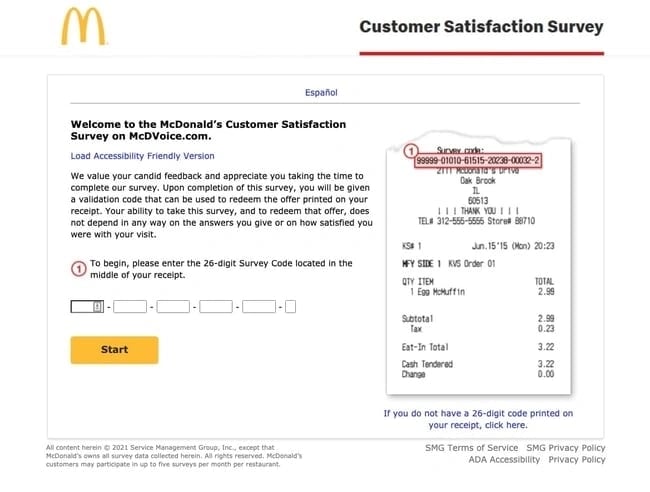
McDonalds is a fast food company that knows exactly how to cater to its customers, even deploying different strategies in countries across the world. One way it tracks success is through incentivized feedback.
One feature that stood out on this McDonald's survey was the labeled receipt on the right-hand side. The element is highlighted so participants know exactly what McDonald's is asking them about in the corresponding survey. Not only does this ensure McDonald's gets accurate information from the survey, but it also reduces any friction customers may have if they're unsure or confused about a question.
20. Home Depot

When customers go to hardware stores, they’re looking for a business that will satisfy their home renovation needs, and Home Depot delivers just that. It collects feedback from customers to improve its offerings and provide better service moving forward.
To entice participants to take the survey, Home Depot offers a $5,000 Home Depot gift card. Offering a sweepstakes entry up-front is a great way to ensure that you get feedback from customers who are more likely to purchase from you again. If you weren’t interested in Home Depot, you wouldn’t take a $5,000 gift card. Right away, you get to gauge the customer’s continuing interest in your business.
21. INBOUND
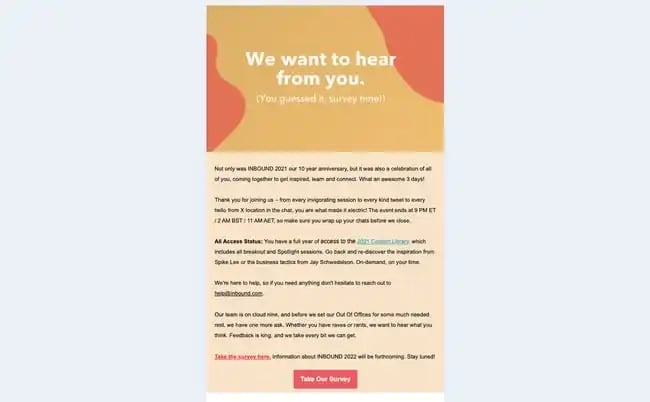
INBOUND is a yearly experience that brings together professionals and business leaders who are interested in growing their company the inbound way. To improve the experience every year, INBOUND asks for feedback — but first, it thanks attendees for coming and provides a link to the year’s recorded content.
This more easily compels the recipient to continue engaging with INBOUND. Even if they don’t answer the survey at the moment, they may come back later if they watch a recording of an INBOUND talk.
INBOUND’s example is great because it not only thanks attendees for attending, it also provides value by providing a link to the content library. Additionally, it gives respondents alternative ways to reach the INBOUND team. In your surveys, thank your customers for their business and provide additional value so they continue engaging with your brand.
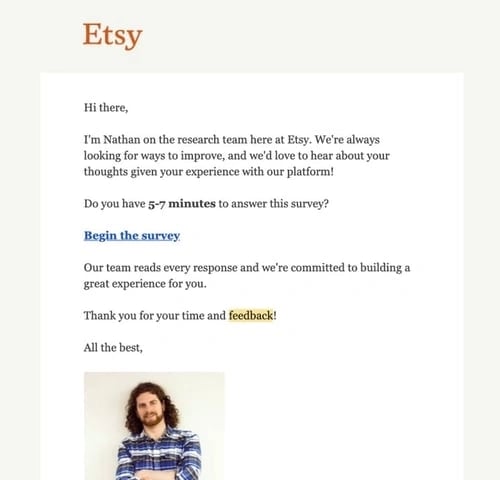
Etsy’s customer satisfaction survey takes a slightly different approach. Rather than sending the survey from a customer service rep’s email, it is sent from Etsy’s research team instead. Even more, a picture of the research team member is included at the end, making it easy to forge a human connection with the person who might actually read the survey responses.
Once you click on the link, you’re taken to an extensive survey that asks a multitude of questions. While shorter surveys are typically better, Etsy establishes the right expectations by sending the survey from the research team. This gives you the impression that the survey will be long and extensive, because it’s being used for research purposes.
Etsy’s example is a winner because it opens with a personal greeting from one of Etsy’s team members. Even if the email was mass-sent, that greeting immediately makes it feel more personal, and the picture of the Etsy staff member only personalizes it further. Lastly, if you plan to send a long survey, feel free to call it “research” to establish the right expectations.
23. Autonomous NYC
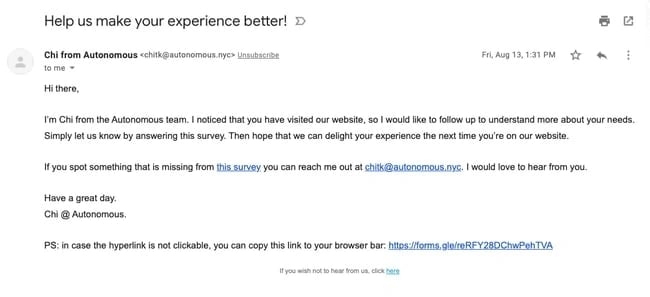
Sometimes, you don’t need a fancily designed email to ask for feedback. Instead, you can send an email just like Autonomous NYC’s. And if you don’t feel comfortable including a picture of yourself like in the Etsy example, you can simply include your first name to give the survey request a more personal feel.
Once you click on the link, you’re taken to a 2-page Google Form survey that measures the user’s happiness with their experience on Autonomous NYC’s website. The survey is clear, succinct, and easy to fill out.
Autonomous NYC’s customer satisfaction survey hits all the right notes. It’s short, but not so short that Autonomous NYC’s team can’t glean any insights. It also makes most questions optional, so that users have the choice to walk away after answering two questions. Give the same option to your survey recipients by making at least a few of the questions optional.
Get More Customer Feedback to Grow Your Business
Knowing how your customers feel about you is instrumental in growing your business. Use customer feedback surveys to collect information that can create lasting and positive changes in your company. When you know how your customer feels, you can make decisions that lead to higher revenue and increased customer retention, empowering you to grow better.
Net Promoter, Net Promoter System, Net Promoter Score, NPS and the NPS-related emoticons are registered trademarks of Bain & Company, Inc., Fred Reichheld and Satmetrix Systems, Inc.
Editor's note: This post was originally published in November 2020 and has been updated for comprehensiveness.
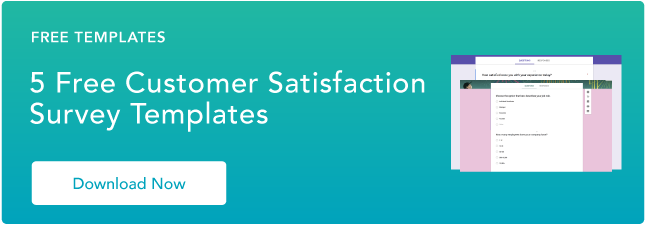
Don't forget to share this post!
Related articles.

What Is Total Quality Management & What’s Its Impact on Customers

What Is Customer Satisfaction Score (CSAT) and How to Measure It?

The Benefits of Customer Feedback, According to Experts

40 Customer Satisfaction Quotes to Inspire You to Make Customers Happy

12 Customer Satisfaction Metrics Worth Monitoring in 2023

Customer Effort Score (CES): What It Is & How to Measure It
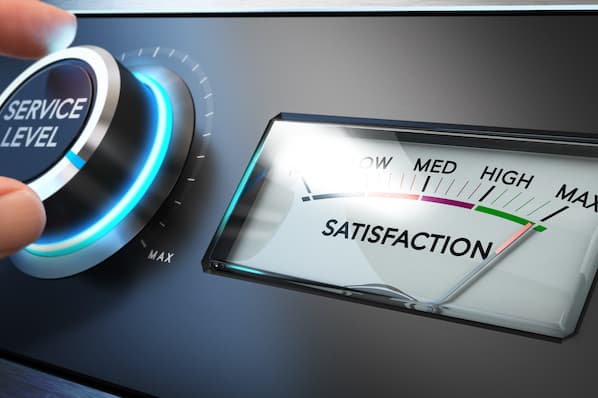
Which Industries See the Highest (and Lowest) Customer Satisfaction Levels?
![research questions on client satisfaction After Sales Service Strategy: What It Is & Why It's Important [+Examples]](https://blog.hubspot.com/hubfs/after-sales-service.jpg)
After Sales Service Strategy: What It Is & Why It's Important [+Examples]
![research questions on client satisfaction How To Design Customer Satisfaction Surveys That Get Results [+ Templates]](https://blog.hubspot.com/hubfs/customersatisfactionsurvey.webp)
How To Design Customer Satisfaction Surveys That Get Results [+ Templates]

Key Driver Analysis, Explained (& How to Use it To Improve CX)
5 free templates for learning more about your customers and respondents.
Service Hub provides everything you need to delight and retain customers while supporting the success of your whole front office
- Customer Loyalty , Marketing , Roundups
41 Experts Share the Best Ways To Research Customer Satisfaction
- 10 min read
- Last updated December 19, 2022
- By Jessica Huhn

ON THIS PAGE
Marketers overwhelmingly agree: It’s vital to research customer satisfaction.
After all, if you don’t know how satisfied customers are with your products or services, what you’re doing well, and what you could improve, your brand will struggle to acquire and retain customers. And only the most satisfied customers will refer their friends to your business!
When we asked 41 marketers to rate the importance of researching customer satisfaction, they gave it a 4.88 out of 5 (with 5 being “of greatest importance.”)
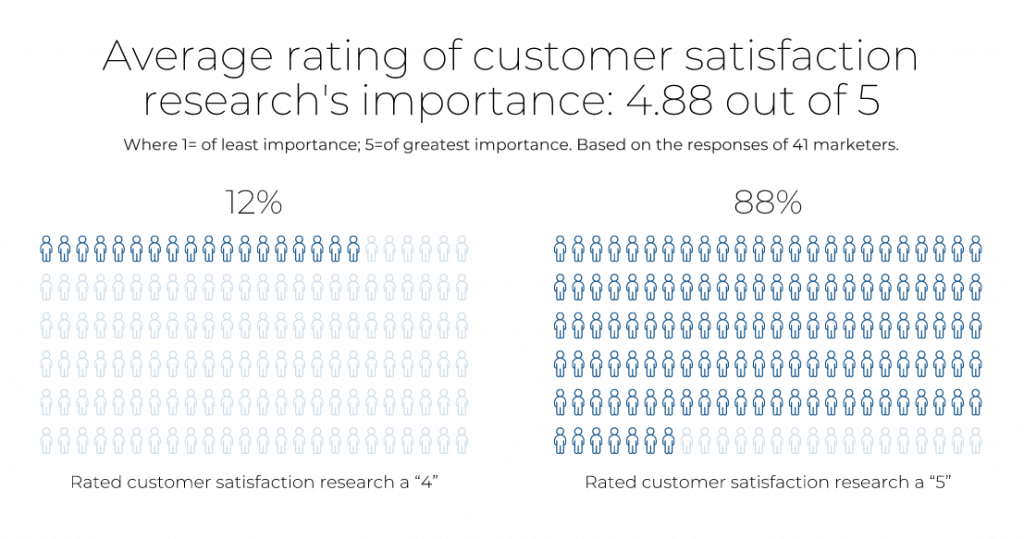
But how do these marketers research customer satisfaction ? What methods and research questions do they find most effective? Let’s dive into their expert insights.
Most companies research customer satisfaction at least once a month
First, how often do marketers research customer satisfaction?
While it varies, most marketers conduct research often. There was no majority answer, but 49% conduct customer satisfaction research monthly, 20% conduct it weekly, and another 20% conduct it daily.
Even with this variation, it’s still clear conducting frequent customer satisfaction research is best to gain an accurate picture of your customer’s changing opinions.
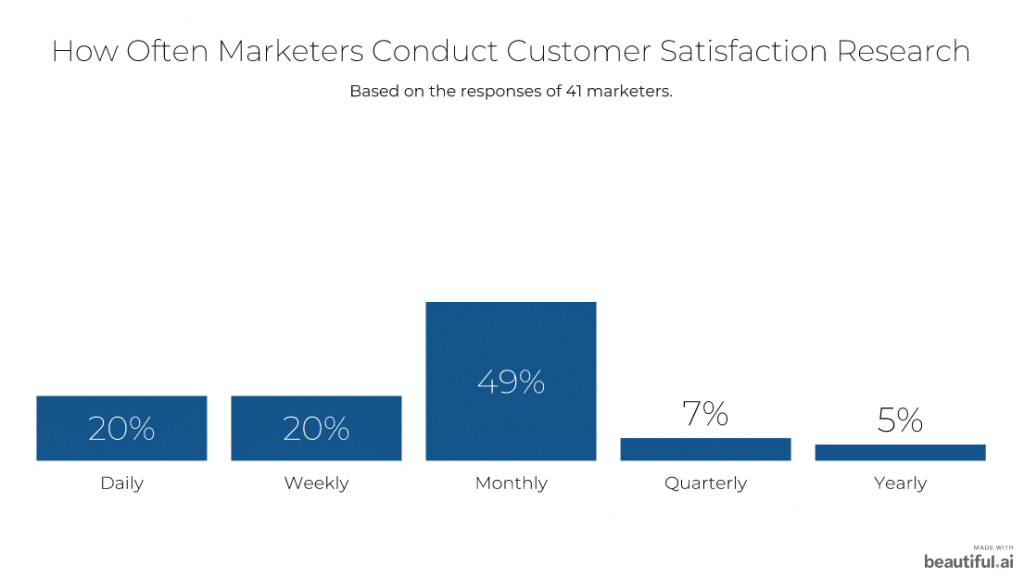
Most popular customer satisfaction research method: Email surveys
How exactly do marketers research customer satisfaction?
Email surveys are the most popular method (85% of marketers use them), followed by customer feedback forms (73%) and customer reviews (68%).
Email surveys can be easily personalized and sent right after a purchase, and customer feedback forms are also easy to deploy, making them simple and popular methods.
As for reviews, they’re often given by customers unprompted, so they provide a genuine picture of how customers feel. They’re also very easy to request and unearth.

7 most effective methods to research customer satisfaction
We then asked marketers to single out the method they find most effective for researching customer satisfaction, based on the above list.
Email surveys were the most effective method for 32% of marketers (making them the most popular and effective).
Customer reviews were selected by 20%, putting it in the second position.
These methods were followed closely by website/in-app surveys (15%) and in-person conversations (12%).
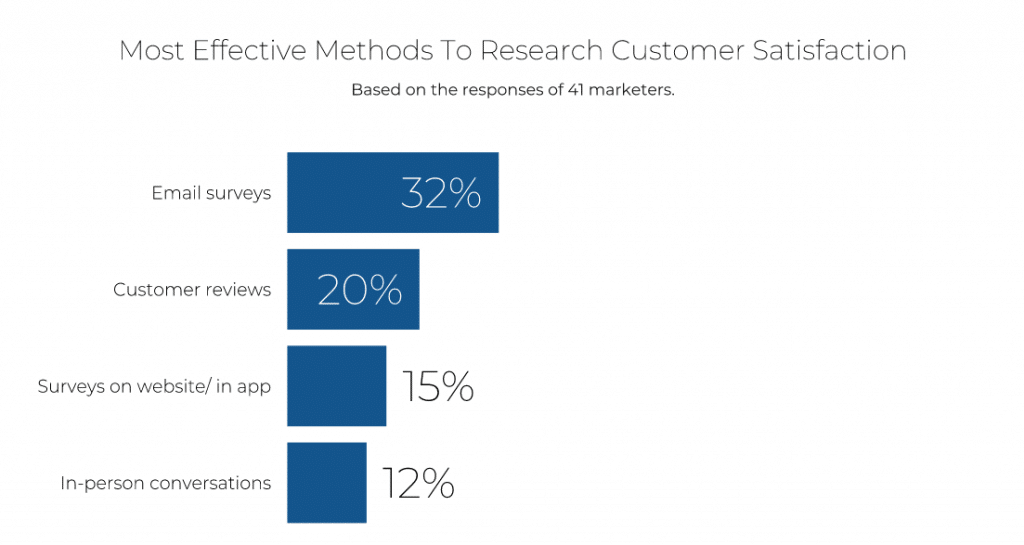
But why do marketers find these methods of researching customer satisfaction most effective? Hopefully, their explanations below will help you choose the methods that will work for you.
Email surveys
“We get the most responses via email surveys. They have provided us with more constructive feedback that’s easy to track and save information compared to other methods.” –Suzanne Pope, Whiterock Locators
“We often don’t give email the kudos it deserves. When a customer signs up for a service or purchases a product, an email a few days later can help a company understand just how well they hit the mark.” –Andrea Loubier, Mailbird
“In my opinion, a quick email survey is always the best way to get customer feedback without making them commit too much of their time. Email surveys are non-intrusive, not time-sensitive, and allow the customer to take their time to respond and produce a quality review.” –Mikkel Andreassen, Dixa
“People are more likely to reply when they are sent a personalized email with some questions about the services they have received.” –Maria Saigatova, Blast Sourcing
In-app surveys
“In-app functionality allows you to deliver targeted surveys to your customers and engage them at the ideal time to receive valuable customer feedback, all while providing a seamless customer experience.” –Cori Pearce, ChurnZero
Customer reviews
“Prompting customers to leave reviews can be beneficial to both parties. Customers can express their likes and dislikes, often in an anonymous way should they like. And this information can help a customer service department go from good to great.” –Sergei Belous, UpFlip
“Customer reviews are the way to receive the most genuine feedback possible. With no incentives for providing feedback, customers only do so if they’re very impressed with your services, or if they can offer criticism you can use to create growth and positive change.” –Alice Ray, Know Your Chickens
In-person conversations
“If it’s feasible, in-person conversations are always great to receive detailed customer satisfaction feedback. In-person conversations are effective because they allow the customer to provide specifics regarding their satisfaction/issues without bias from others.” Doreen Amatelli-Clark, Way to Goal Business Insights
“In-person conversations have always worked well for me because I can see the person’s facial expressions and body language much better. Being there in the same room as your client also gives you credibility because you spent your time and went to their office.” –Ben Walker, Transcription Outsourcing
Phone/video chat conversations
“Phone and video chat conversations allow you to dig into a customer’s preferences and really get to know their pain points. You’ll open up new pathways in conversation and learn a lot more than you expected about your most valuable customers.” –David Cusick, House Method
Social media
“Gaining customer satisfaction reactions from social media can be a bold choice, as it’s out there for the entire world to see. However, this can keep you genuine and authentic, and you can take the comments that are posted and devise innovative strategies from them.” –Carrie McKeegan, Greenback Expat Tax Services
Data analysis
“Analyzing data can provide a clear picture of how satisfied our customers are at any point. Are current customers continuing their service? Are they recommending others or even opting for more solutions that are offered? These things can provide a lot of valuable insight.” –Thomas Bolt, Big Eval
“We have used Net Promoter to gain a snapshot of our performance through the eyes of our current and past customers. Our goal is not only to determine the NPS, but to understand the cause of the score. This is achieved by asking follow-up questions through phone interviews.” –Alex Membrillo, Cardinal Digital Marketing Agency
“When customers are willing to promote your brand among their networks, this is the best marketing money cannot buy. Statistically, people trust the opinions and recommendations of others in their network above any other source. This is why NPS surveys are key.” –Jen Lawrence, Vye
Customer satisfaction metrics: Qualitative metrics are most popular
Now that we know the methods marketers use to research customer satisfaction, what specific metrics do they track?
Interestingly, the most popular metric, and the only one the majority use, is qualitative rather than quantitative.
Fifty-four percent of experts use customer comments to measure customer satisfaction. Comments give a clear picture of why customers are or are not satisfied with your brand. With this insight, you’ll be able to take direct action to increase customer satisfaction.
As for the most popular quantitative metrics:
- 49% use customer satisfaction score (CSAT) (“On a scale of 1-10, how satisfied were you with [product/service/experience]?)
- 44% use customer review scores
- 37% measure customer retention vs. churn
- 34% track customer lifetime value
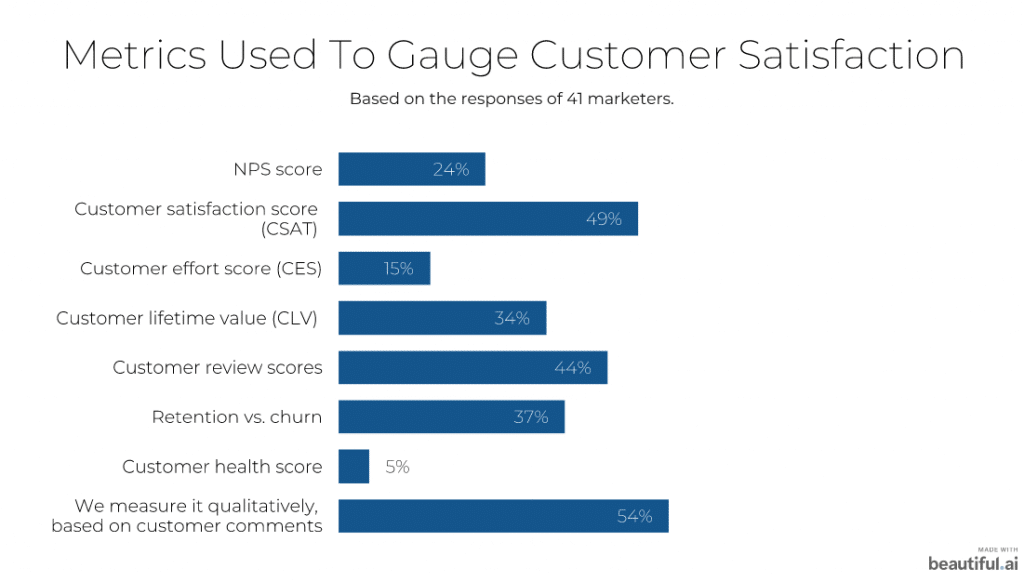
Specific tools marketers use for customer satisfaction research include:
- Hotjar (behavioral data analytics)
- Buzzsumo (social media monitoring)
- Survey Monkey (simple form building platform)
- ChurnZero ( customer success software with customer health scores)
- ReviewInc ( customer review management software )
- Survey Sparrow (omnichannel customer experience/survey building software)
- Informizely (website, email, and in-app survey integration)
- Zonka Feedback (CSAT, CES, and NPS survey software )
- Typeform (form building)
- Qualtrics (survey/customer feedback analytics)
- HubSpot (CRM software)
- Mention (social media monitoring/ brand mention tools )
8 best types of customer satisfaction research questions
The top customer satisfaction questions shared by marketers were as diverse as the businesses they work for. But there were several common themes in the questions they found most helpful.
Here are the favorite customer satisfaction survey questions, divided by category, for you to draw inspiration from.
Include a scale for people to rate the product
“I would say the best question to ask is, ‘How would you rate our product/service overall?’ based on a scale, since it provides a baseline to measure customer satisfaction.” –Suzanne Pope, Whiterock Locators
“Ask the consumer to score their happiness with the business, product or service, to generate an average CSAT ranking (customer satisfaction score). Usually, a customer satisfaction scale varies from 1–3, 1–5 or 1–10.” –Eliza Nimmick, Tutor The People
Ask why they chose your product/service
“Ask ‘What makes you choose us?’ Give participants a list of possible answers and ask them to rank nos. 1, 2, and 3. Then also give them the opportunity to comment if they wish. The list will spur their thinking, and you will learn both your strengths and weaknesses as compared to your competitors.” –Karen Condor, USInsuranceAgents.com
“Why did you choose our product or service over our competitors? What stood out, and made you choose our particular company?” –Alice Ray, Know Your Chickens
Learn whether they’d use your product or service again
“My key question would be ‘Would you use us again?’ That answers the all important question of how you are doing at building a loyal and engaged customer base for your business.” Adam Korbl, Ifax App
Carefully ask about negatives and places for improvement
“The one question I think you should ask is: “If you could change anything, what would it be?” There may be a lot of different answers, but that’s a good thing, to get different perspectives. If you see a common thread through the answers, you’ll have an idea of what to improve.” – Daniel Foley
“Is there anything about our services or solutions that would cause you to discontinue using them?” –Thomas Bolt, Big Eval
“I recommend the question ‘If a friend asked you about any negatives or downsides, what would you say?’ It’s tough to get negative feedback, especially in in-person or live interviews. Re-framing the “’What’s the worst thing?” question allows the customer to think differently and give honest feedback without feeling awkward about it.” –David Cusick, House Method
“I think you can never go wrong with an open-ended ‘What could have we done better?’ or ‘How can we improve?’ to allow the customer some room to expand and share their thoughts. Some of the best ideas come from your very own customers and with a bit of luck, they can offer excellent insight into your product that can be implemented in the future.” –Mikkel Andreassen, Dixa
“The best question to ask customers when conducting research on customer satisfaction is ‘What would have made the biggest improvement for your experience?’ Then you can nail down what improvements “”will make the biggest overall impact on our customers for the future.” –Jacob Rosenberg, Tajima Direct
Ask how they would rate your customer service
“Ask customers how they would rate your customer service department. This team is often the voice of your company, and you’ll want to clearly portray your company values and ethics.” –Sergei Belous, UpFlip
“Ask ‘Do you feel your experience, from the first email to the last and everything in between, was worth your money and time?’
Those two things are the most important to people and it should be for any business and by bringing those two things up in conversation allows them to answer you from a business point of view and may trigger them to bring up valuable info.” –Shaun Taylor, Moriti Safaris
“How happy are you with our current service compared to what you were expecting when you signed up?” –Jane Kovalkova, Chanty
“Ask customers to rate the customer service they have received on a scale. For example:
- On a scale of 1-10, please rate the service quality provided by the customer service rep.
- On a scale of 1-10, how effectively the customer support rep handled your problem today?
- On a scale of 1-10, how would you rate the friendliness of your customer representative?” –Rorie Devine, Gro.Team
Learn whether customers would refer your business to others
“I think asking the customer if they would refer your business, product or service to others is an important question to ask. If they truly received a great experience and think others would benefit as well, a referral is an inexpensive and easy way to grow business.” –David Peterson, HealthMarkets
“Would you recommend this business to a friend or family member? If yes, why ?” –Golda Criddle, ReviewInc
“When conducting these surveys, the best question to ask is, ‘How likely are you to recommend our product to your friends and family members?’ This question gives a great insight in how the customer feels about your product. If they are willing to recommend it to people they care about, that means they are satisfied with your product and will help spread the word about it.” –James Major, Insurance Panda
“Existing customers provide great insights about your business’s products and services. Asking “l’How likely are you to recommend our brand to a friend?’ can show how happy and satisfied they are.
“Telling their experiences to others can help you grow your brand. It can help you build and improve your brand’s services, which can attract more customers. Your existing customers will be your most valuable asset that can help in promoting your brand’s name.” –Dennis Bell, Byblos Coffee
“On a scale of 0-10, how likely are you to recommend our company? This is the net promoter score question.” –Jen Lawrence, Vye
Learn what problem they seek to solve with your product
“Ask, ‘What problem would you like to solve with our product?’ This question seeks information that usually cannot be gauged by analytics.
It’s great to ask this question even before finalizing the sale. It may be the case that your potential customers are looking for something different than their chosen product is. If you have other products that would much better suit their needs, it’s great to navigate them towards them before it’s too late and they get disappointed with a product that was not designed for what they actually need.” –Eliza Nimmick, Tutor The People
Focus on three key components in your questioning
“We would actually argue that effective customer satisfaction research cannot be narrowed down to one key question.
When measuring customer satisfaction for a product or service, researchers should focus on and measure the key components: xs the product/service’s relative importance to the customer, the customer’s expectations and then their satisfaction of that product/service.” –Doreen Amatelli-Clark, Way to Goal Business Insights
Wrapping up
No matter what methods and questions you choose, be sure to research customer satisfaction relatively often, and use both qualitative and quantitative measures. It’s always helpful if you ask customers how willing they are to refer your business to their friends ( the NPS question ).
When someone is ready to advocate for your business, this shows that they’re highly satisfied – customers won’t recommend you if they aren’t enthusiastic about what you have to offer.
Plus, referrals are an effective engine that will bring new customers to your business – customers who are more likely to stay loyal and satisfied.
Looking for more tips on researching customer satisfaction? Marketers share their top tips and strategies for customer satisfaction research in this roundup.
Related articles

The 11 Best PRM Software Options for 2024
How to Set Up Referral Tracking [+ Free Spreadsheet]

Top 10 Brand Ambassador Program Examples + Why They Work

How To Build a B2B Referral Program [15 Tips + Software]
🔥 ready to get more referrals.
COMPANY About Us Services Plans and Pricing Start a Free Referral Program
© Copyright 2024 Referral Rock Inc. All Rights Reserved.
- Coupon Code Generator
- Gift Card Code Generator
- Manual Referral Tracking Tool
- Referral Link Generator
- Referral Program Workbook
Cookie consent
We use our own and third-party cookies to show you more relevant content based on your browsing and navigation history. Please accept or manage your cookie settings below. Here's our cookie policy

- Form Builder Signups and orders
- Survey maker Research and feedback
- Quiz Maker Trivia and product match
- Find Customers Generate more leads
- Get Feedback Discover ways to improve
- Do research Uncover trends and ideas
- Marketers Forms for marketing teams
- Product Forms for product teams
- HR Forms for HR teams
- Customer success Forms for customer success teams
- Business Forms for general business
- Form templates
- Survey templates
- Quiz templates
- Poll templates
- Order forms
- Feedback forms
- Satisfaction surveys
- Application forms
- Feedback surveys
- Evaluation forms
- Request forms
- Signup forms
- Business surveys
- Marketing surveys
- Report forms
- Customer feedback form
- Registration form
- Branding questionnaire
- 360 feedback
- Lead generation
- Contact form
- Signup sheet
- Help center Find quick answers
- Contact us Speak to someone
- Our blog Get inspired
- Our community Share and learn
- Our guides Tips and how-to
- Updates News and announcements
- Brand Our guidelines
- Partners Browse or join
- Careers Join our team
- → 43 customer satisfaction survey quest...
43 customer satisfaction survey questions + 7 do's and don'ts
Use these customer satisfaction survey questions to inspire your next typeform.

Latest posts on Tips
Typeform | 05.2024
Think of your competitors as crocodiles. They’re patiently waiting for you to screw up your customer service or customer experience. And the moment you do, they’ll pounce and devour your brand—taking your customers with them.
So, how do you avoid being crocodiled?
You have to be on top of your brand perception —always. But to start improving, you need to know where to begin. Learn to ask the right customer satisfaction survey questions and see where you stand with your clients, then turn detractors into your biggest fans by showing them that you can do better.
Customer satisfaction survey questions
Customer satisfaction surveys measure how happy customers are with your product or brand. These questions can cover a variety of topics related to the product, from how well it performs to brand loyalty and product satisfaction.
1. On a scale of 1 to 10, how satisfied are you with [product]?
2. Did [product] fail to meet your expectations? If so, why?
3. Did [product] meet your expectations?
4. Which feature of [product] did you find most valuable?
5. Which feature of [product] did you find least valuable?
6. What new features or upgrades would you like to see from [brand]?
7. What are three words you’d use to describe your experience using [product]?
8. How would you rate the consistency of how [product] works?
9. Which step of the purchase process are you most satisfied with? Why?
10. Which step of the purchase process are you least satisfied with? Why?
11. How would you rate the consistency of [product]’s performance?
Check out our customer satisfaction survey template to learn more about what makes your customers happy.

Customer service survey questions
Customer service representatives are the first line of defense when a customer needs help. They can make or break how customers feel about your brand or product, so it’s important to ask some questions about service in your customer satisfaction survey.
12. How would you rate the effectiveness of [brand]’s customer service?
13. On a scale of 1 to 10, how would you rate the knowledge of [brand]’s representatives?
14. How long did you wait for a reply from a customer service representative?
15. How would you rate your satisfaction with your options for reaching a customer service representative?
16. Please rank your preferred way to contact a customer service representative of the following options: call, text, email, or live chat.
17. Please rate on a scale of 1 to 10 your overall experience purchasing [product].
18. Did your customer service experience impact how you think of [brand]? In what ways?
19. How could [brand]’s employees provide better service?
20. Was [brand]’s customer service representative able to resolve your issue?
21. How would you rate the friendliness of [brand]’s employees?
22. Did our customer service team provide clear and accurate information?
Check out our online customer service survey template to start gathering customer feedback today.
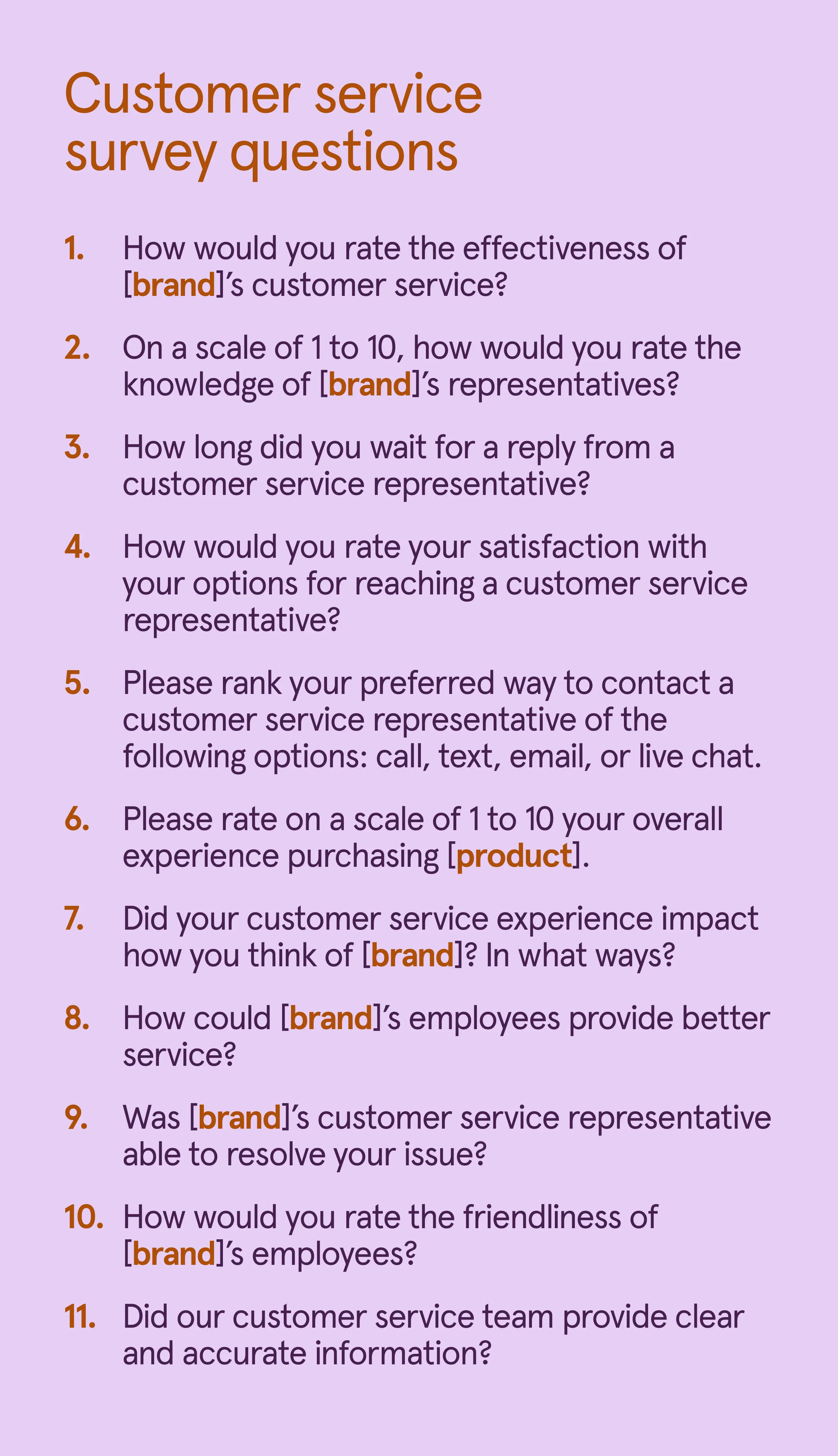
Net Promoter Score survey questions
Net Promoter Score (NPS) surveys measure the likelihood that a customer will recommend your brand or product to others. These questions ask respondents to respond on a scale of 1 to 10, with a higher score meaning the person is more likely to become a “promoter.” You might also find some of these questions on a brand awareness survey because high NPS scorers boost brand awareness.
23. On a scale of 1 to 10, how likely are you to recommend [product] to a friend over a competitor?
24. On a scale of 1 to 10, how likely are you to post positively on social media about [product]?
25. On a scale of 1 to 10, how likely are you to purchase from [brand] again?
26. On a scale of 1 to 10, how likely are you to recommend [product] to a friend based on your customer service experience?
27. On a scale of 1 to 10, how likely are you to recommend [product] to a friend based on your overall shopping experience?
28. On a scale of 1 to 10, how likely are you to recommend [product] to a family member?
29. On a scale of 1 to 10, how likely are you to recommend [product] to a coworker?
30. In what situations are you most likely to recommend [brand]?
31, Did someone recommend [product] to you? How did they convince you to make a purchase?
32. How well does [product] address common pain points in your industry?
33. How likely are you to interact with [brand] on social media?
Check out our Net Promoter Score survey template to investigate your brand’s biggest fans.
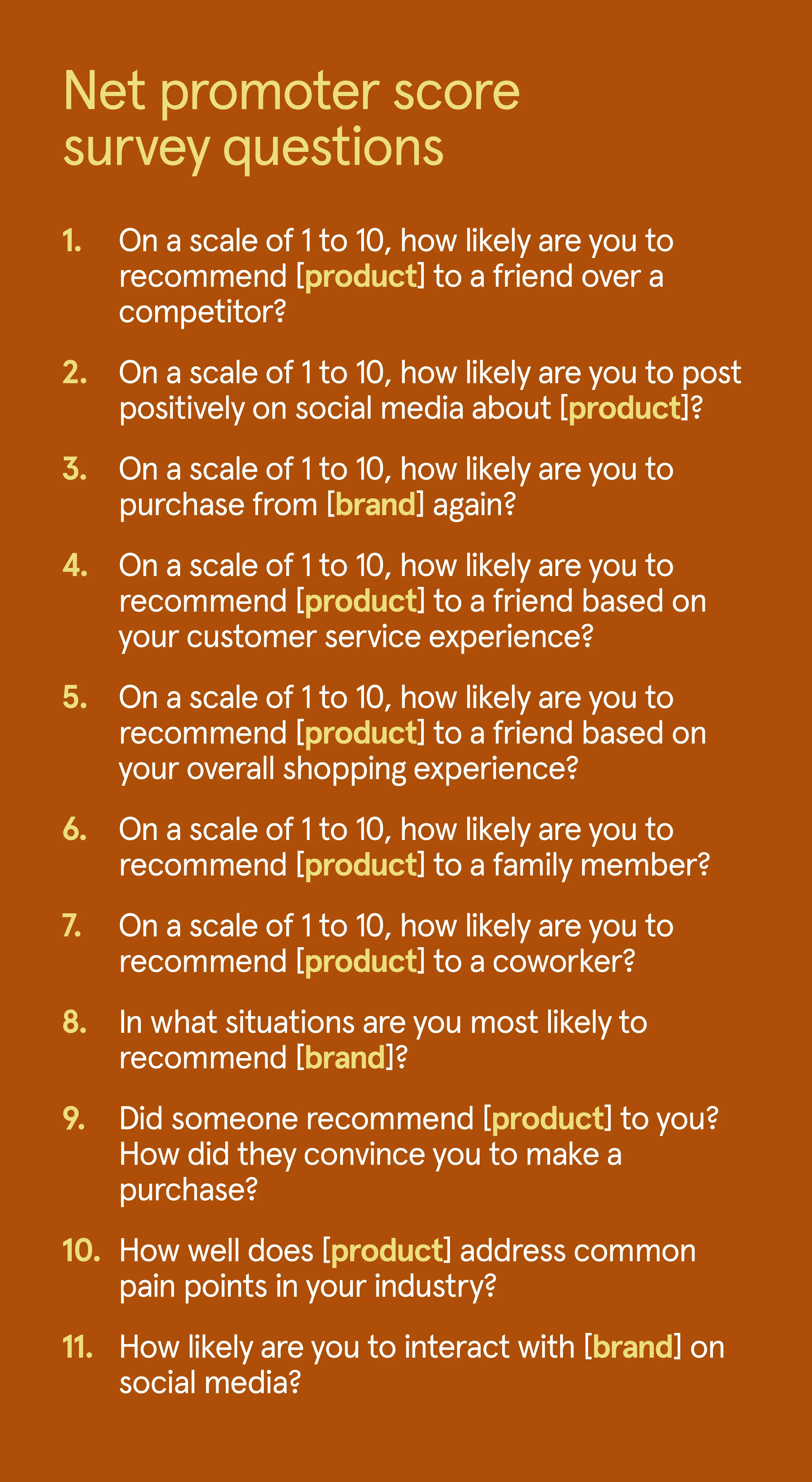
Customer effort score survey questions
Customer effort score surveys use Likert scale questions that indicate how easy it is for potential customers to make a purchase. For example, response options for “How much do you agree that chocolate is the best candy?” would be “Strongly Disagree, Disagree, Neither Agree nor Disagree, Agree, and Strongly Agree.” These questions evaluate factors like website accessibility and how well potential customers are educated about a product. The easier it is for customers to make a purchase, the better.
Ask respondents to what degree they agree with the following statements:
34. It was easy to find the information I needed to purchase on [brand]’s website.
35. I had a pleasant in-store shopping experience.
36. I found it easy to learn how to use [product].
37. I found it convenient to purchase from [brand].
38. [Brand]’s employees made it easy to resolve my issue.
39. [Brand] provides effective and easy-to-follow instructions.
40. [Product] is easier to use than its competitors.
41. [Brand]’s employees understand my needs as a customer.
42. It was simple to customize [product] to fit my needs.
43. [Brand]’s website runs on my device without any issues.
Check out our customer effort score survey template to help simplify checkout for every customer.
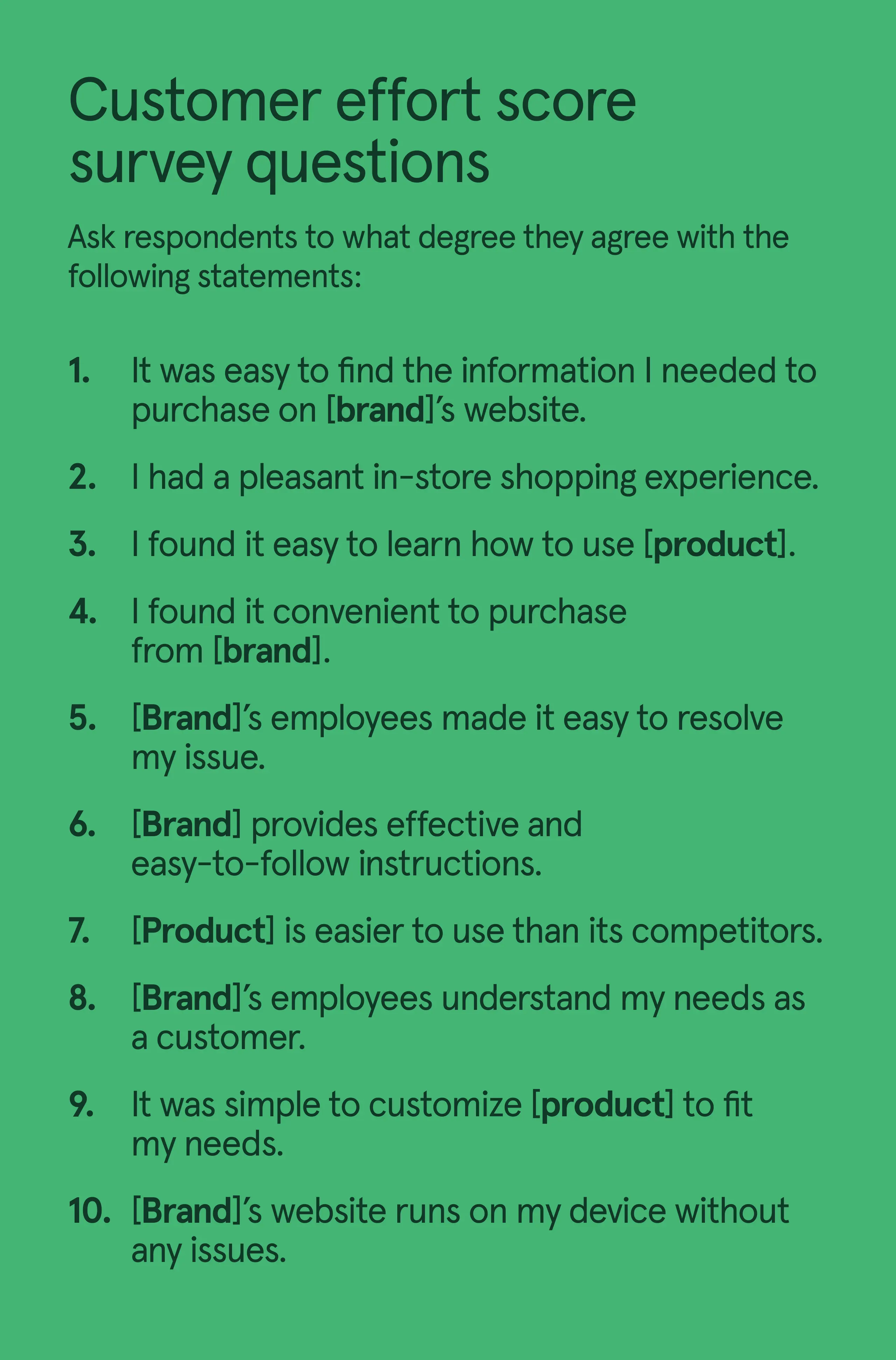
Customer satisfaction survey questions best practices
Customer satisfaction surveys provide priceless feedback about a product, brand, or experience. Let’s cover some best practices so you can gain the full benefits of a well-designed survey .
1. Take time to craft your survey
Take time to think about what your survey should accomplish. Don’t rush writing your customer satisfaction survey questions for the sake of a deadline. Think, then write. This helps keep your brand voice in your survey. Your customers really don’t want to hear from a robot—especially if the survey isn’t even thoughtful.
2. Let people skip questions
Sometimes people just don’t know—and that’s fine. How can Katy answer the question “How did our store smell today?” if she was completely blocked up with a cold and only dashed in for some lemon and honey?
When people are presented with questions they don’t know the answer to, they usually desert the survey completely. We’ve all done it.
Avoid this by letting people skip a question if they don’t want to fill it in or by adding a simple “I don’t know” response. Your customer satisfaction survey isn’t a test.
3. Don’t use leading questions
We’ve all filled out cheesy customer survey questions that are completely biased toward the company.
“How was our amazing customer success team today?”—Actually, not so great, Dave hung up on me.
“Was it easy to find things in our organized aisles?”—No, it looked like someone had let a few bears loose.
“Who made your visit extra special today?”—I’d say it was Karen; she smashed my eggs while scanning them.
If you’re asking questions like these, you’re going to be left with a load of useless answers—and a few replies from trolls.
Instead, ditch the superlatives and ask, “Did our team resolve your problem?”
Let every customer tell their own story, and listen very carefully.
4. Keep it short and sweet
Generally, the sooner you send the survey, the better. Are you going to strike when the order form has been processed or wait till the product lands in their hands? Regardless of when you send the survey, make sure the survey is tailored to your situation. You can’t ask customers about a product they haven’t received yet.
Segmenting your users is essential before sending out your customer satisfaction survey—and timing is everything.
Ask how people’s shopping experience was within 24 hours and it’ll still be fresh in their minds. Any later and they’ll probably forget unless it was awful—looking at you, Karen. Put those eggs away.
5. Use simple language
Robots haven’t taken over our jobs yet, so don’t start acting like one. Engage people by creating a customer feedback survey that mirrors a conversation.
Turn “users” into people. Ask questions as if you were speaking and ditch any jargon or formalities. Say hello, ask for their name, and why not add a thank you screen with a discount code on their next purchase? They’re doing you a big favor.
6. Keep your eye on the prize
You want to find out how happy your customers are. You’re not trying to do market research for a new product just yet, so don’t be tempted to veer off course.
Every survey you send out should have a clear goal. Before you even start putting the blocks of your typeform together, think:
1. Who are these customer survey questions for?
2. What are we actually asking?
3. How are we going to use this information?
If you can’t answer these questions, take a breather and rethink your customer satisfaction survey plan. Go for a walk, catch up with your dog—or start planning how to build a Barception .
7. Keep questions intentional
As long as you’re writing a customer satisfaction survey that'll give you the information you need, don’t get too worked up over the number of questions.
Some people say 10 questions is the best number. Others warn you not to go over 20 questions. Sometimes, even one Likert scale question can do the job. It really depends—but as a rule of thumb, the shorter a customer satisfaction survey is, the better.
52% of people said they wouldn’t complete a survey if it took them over three minutes. We exit more surveys than we complete, so keep it short and sweet.
Make it simple for people to whizz through your customer satisfaction survey, and you’ll end up with a higher survey response rate . And that means you can really start concentrating on how to give the best service ever.
Free customer satisfaction survey templates
Ready to get started? Check out these customer satisfaction survey templates from Typeform that will help you start surveying on the right foot.
General customer satisfaction survey template
This general customer satisfaction survey template helps you cover all your bases. It’s great if you’re not sure where to start.
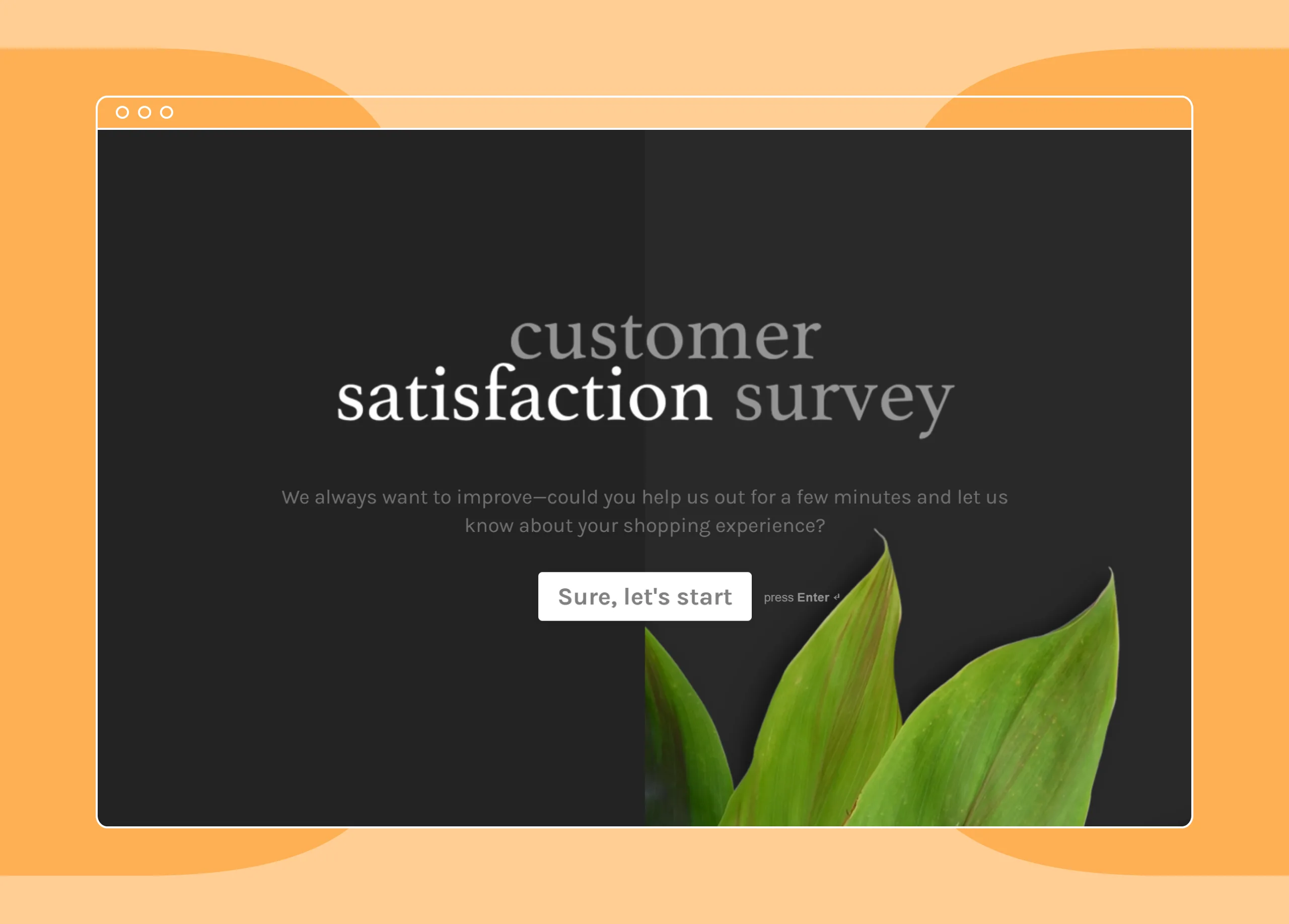
Customer service survey template
This customer service survey template helps you measure how well your team responds to customers' issues.
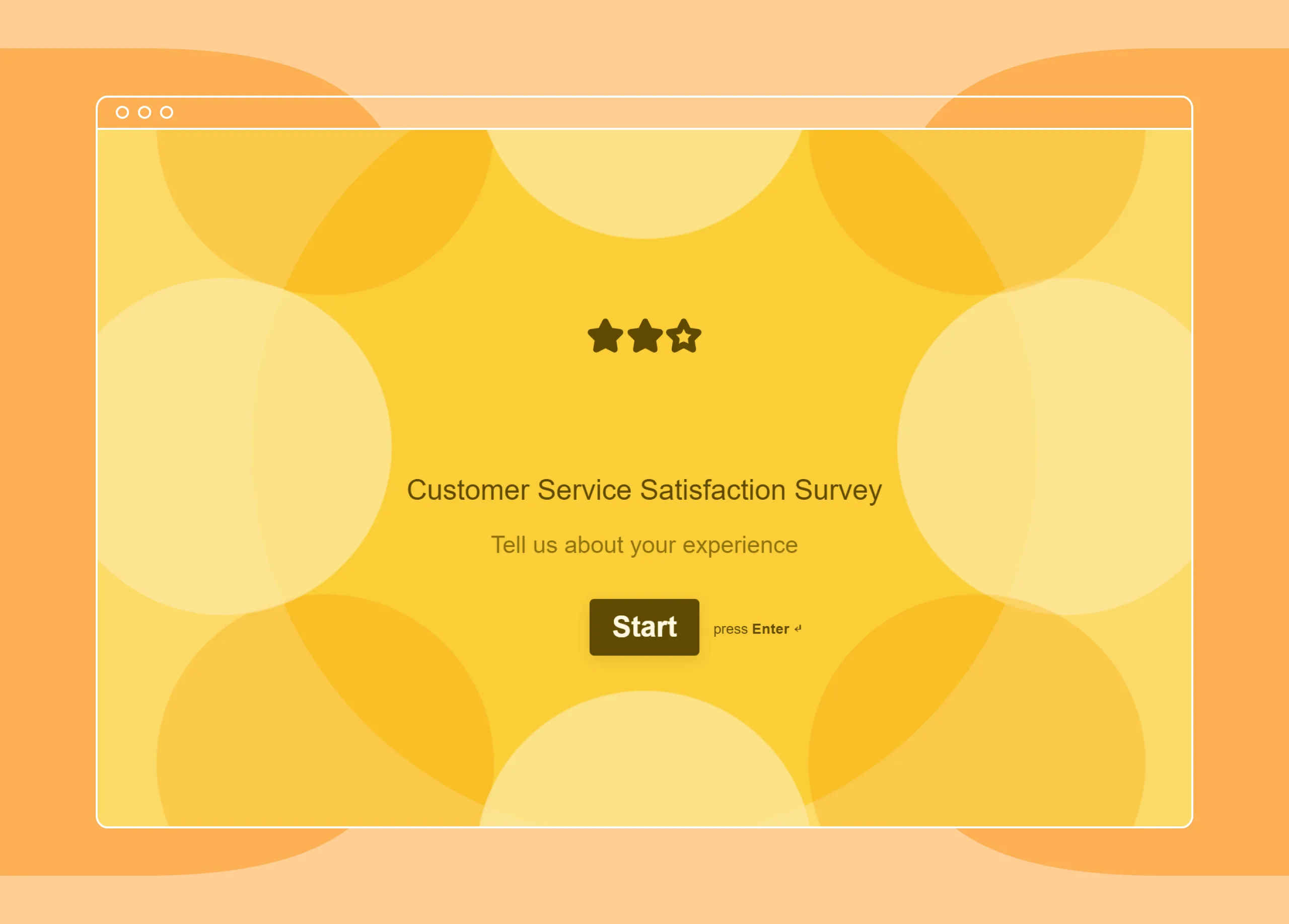
Net Promoter Score survey template
This Net Promoter Score survey template is perfect for measuring how likely your customers are to spread the good word about your brand.
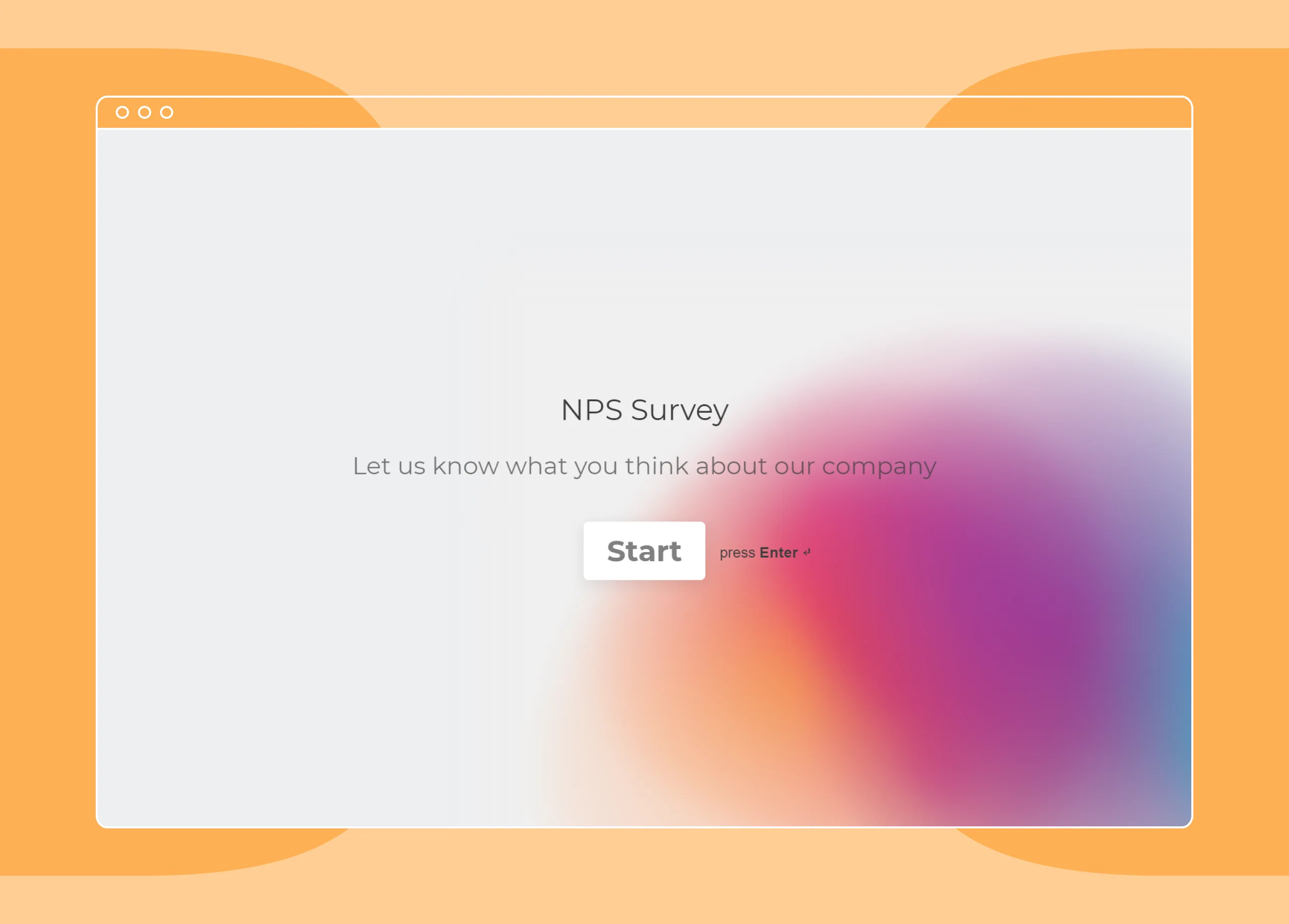
Customer effort score survey template
This customer effort score survey template helps you discover pain points in your product or purchasing process.
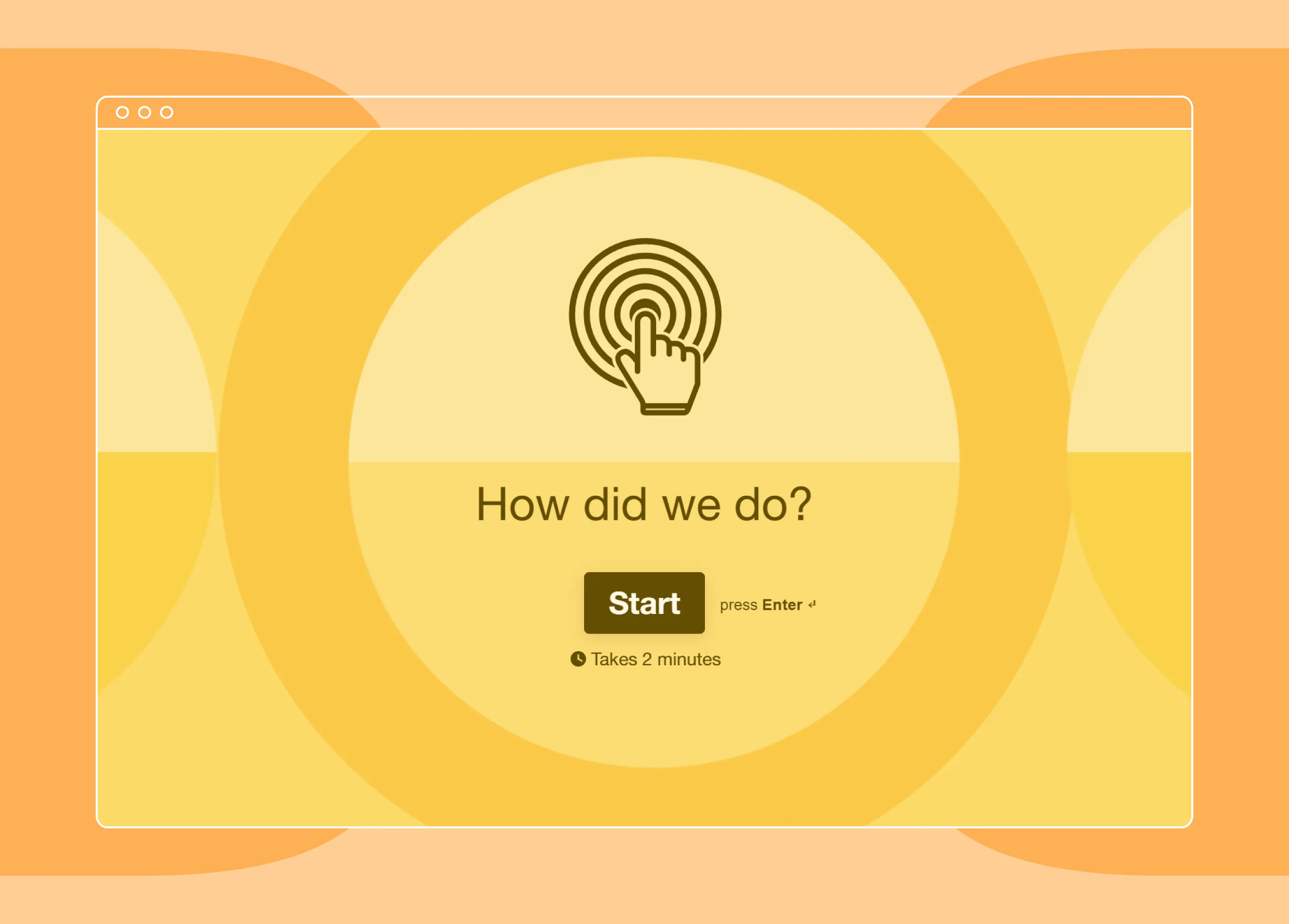
Measure customer satisfaction beautifully with Typeform
You don’t need to be a mind reader to learn what your customers want—you just need to ask the right questions. Typeform helps you achieve more with your customer satisfaction survey questions, whether you harness our superior design capabilities or AI suggestions that help you get the most out of your survey.

About the author
Lydia is a content marketer with experience across both the B2B and B2C landscapes. Besides marketing and content, she's really into her dog Louie.
Liked that? Check these out:
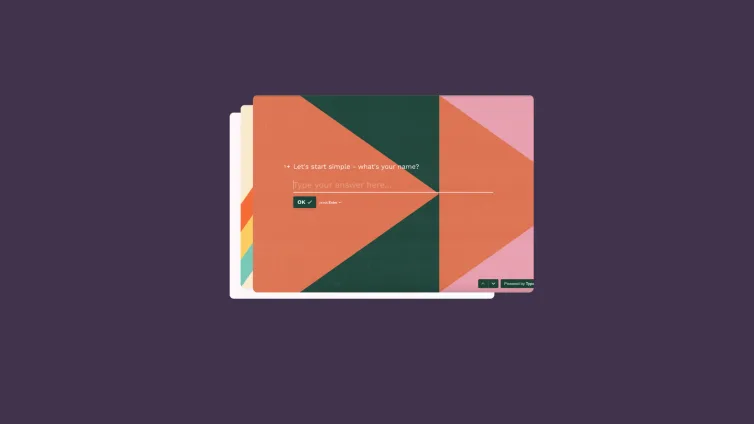
How to leverage zero-party data for marketing attribution
The cookieless future is here, so how are marketers supposed to correctly assign attribution, build informed strategies, or understand their customers? Zero-party data is your friend: learn how to collect and leverage it with this guide.
Kevin Branscum | 01.2024

Make your next market research survey count with these 9 tips
Learn how to get meaningful feedback and strengthen existing customer relationships.
Paul Campillo | 04.2016

Survey design: Best practices and 15 expert tips
Beautiful surveys perform better. Read our 15 top tips to make more effective surveys and create a bigger impact with your business.
Lydia Kentowski | 01.2024
10 examples of customer satisfaction survey questions
Last updated
18 March 2023
Reviewed by
Getting the most out of your customer satisfaction survey requires carefully selecting the right questions, and we'll show you how to do just that in this post.
- What is a customer satisfaction survey?
A customer satisfaction survey (CSAT) aims to gather information about a customer's opinion of a product or service via a questionnaire. Customer satisfaction is usually measured after an interaction with the company or brand. For example, a customer satisfaction survey can target both customers who purchase an item from the company website and those who contact customer service.
Your customer satisfaction survey can act as a live indicator of whether or not a dialogue has been settled or whether the customer still needs help. A brief follow-up with clients who have expressed dissatisfaction is often all it takes to turn them into pleased ones. Customer satisfaction surveys can also be used to understand how consumers feel about your business.
Customer satisfaction surveys are focused on customer satisfaction, and questions can be tailored or selected to focus on different aspects of the customer experience or relationship with the brand.
- Foundational elements of a good customer satisfaction survey
Pay attention to these three guidelines when you create your customer satisfaction survey:
It's essential that your questions are well-worded and focused on the customer’s actual experience with your firm. Avoid jargon, and define any special terms your customer may not be familiar with.

Stay focused
The focus of your survey should be on a specific aspect of the customer service experience. Consider the survey a check-in with your consumers to glean some helpful insight from their answers. The typical response should take about two minutes. Longer surveys will see fewer responses.
It's your company, and it can be hard to remain objective. However, refrain from using questions that reflect your biases while surveying customers. You want clients to feel comfortable enough to offer you honest feedback, no matter how negative it may be.
- Why is a customer satisfaction survey important?
Taking the time to conduct customer satisfaction surveys may shed light on the strengths and weaknesses of your organization, allowing you to address the weaknesses. By inviting client feedback, you can learn what they want and find out where else you might take your company.
Asking your clients about their satisfaction is crucial to maintaining a positive relationship with them. Keeping your current clientele happy is more cost-effective and less time-consuming than seeking new ones.
Conducting satisfaction surveys with your clientele is a great way to get to know them better. You can get your clients talking and show them you value them. If you take the time to address consumer comments, you may find that they become your most enthusiastic advocates. Promoting your business via word-of-mouth is one of the most cost-effective strategies.
Customers who have had a bad experience may not always voice their dissatisfaction but may never return. However, by conducting a customer satisfaction survey, you are encouraging conversation, and as a result, consumers are more inclined to disclose a complaint. It is your opportunity to win back the customer's trust and loyalty.
By providing a forum for feedback, customer satisfaction surveys help you better meet the requirements of your clientele. Because of this, you'll have a better chance of expanding your product or service offerings in response to your customer needs.
- Customer satisfaction survey questions
Open-ended questions present a higher cognitive load to the respondent and therefore have lower response rates. They gain valuable, granular insights, but it's a lot of work to go through these responses if there are a lot of them.
In contrast, quantitative data from Likert-type rating scales is much easier to respond to, resulting in higher response rates. It is also very easy to analyze quantitative responses by creating an average score per question, which has value in ease of interpretation and tracking trends over time.
It's crucial to clarify your objectives before producing your survey since there are many different sorts of surveys and questions you can ask to get a feel for your customer service. To gauge client satisfaction, consider the following 10 questions.
1. Why did you purchase this product?
To know your product's unique selling proposition, ask customers what made their purchase. You can find, for instance, whether people like your product because of its high quality, favorable reviews from past customers, or its reasonable pricing.
2. How did you find us?
By asking this, you'll give yourself the best possible shot at gaining new customers and enhancing your current market presence. Knowing if your marketing is reaching the correct people or if you're receiving business in other ways is quite helpful. By knowing which of your marketing channels is most successful at bringing in new clients, you can allocate your resources more wisely.
3. What additional products or new features are you interested in?
Asking your clients about additional features or products they like directly is an excellent way to understand what they want from your company. Not only might this result in happier customers, but it also could provide your marketing and creative teams with some fresh ideas. Think of it as sharing a productive brainstorming session with your customers.
4. How can we improve our services or products?
Your organization must find out where it can improve. Additional input like this might help organizations fix problems and grow over time. A customer could, for instance, complain that the help desk might do a better job of resolving issues. Companies can use this feedback to identify and improve on their areas of weakness.
5. How long have you been using our products or services?
Your company's success in customer retention can be gauged in part by looking at how long a customer has been with the brand. Loyal customers feel your company provides superior quality and service, which is why they stick with your brand.
6. Have you enjoyed your experience so far?
If you ask this question and provide users the choice to enter a detailed answer, you'll get helpful information that can be used to make the site more user-friendly. It is a great question to ask after a lead form is submitted, a purchase is made, or a support request is made.
It is crucial to customer retention and satisfaction to learn how challenging it was for clients to locate the service or information they sought. To do this, you can ask something as straightforward as, "In light of your recent experience with our website, how simple or complex did you find it to accomplish your goal?"
7. How would you describe our products and services?
You can learn a lot about how clients feel about your products and services if you let them describe them in their own words. Ask an open-ended question like this to better understand what your clients care about. In addition, their feedback can inform the selection of marketing keywords and the development of promotional content. Also, you can use the most insightful and favorable replies as testimonials in your marketing.
Is your product seen as a luxury splurge, or were they just okay with it? This question gives you valuable insight into your customers’ impressions of your offerings.
8. Would you recommend us to others?
9. how would you rate the speed of response from customer service.
Questions like these can be used to evaluate the quality of individual customer service agents as well as the customer service/customer support system overall. Individual performance evaluations, targeted training, and staffing decisions can result from responses to this question.
By recognizing and rewarding the efforts of your best workers, you can increase morale and encourage people to better adhere to procedures. Asking variations on "How polite was (Agent X)?" and "How informed was (Agent X)?" are good examples of targeted inquiries.
10. What other brands would you consider equivalent to, or better than, ours?
Asking customers for their ideas about your competitors is an excellent way to identify threats and opportunities in your market.
- How to follow up on survey results
After you have completed and submitted your survey, you may get the most helpful feedback by following the procedures outlined below.
1. Don't ignore negative responses
It is essential to respond to negative feedback from your clients. Connecting with your consumers more personally and addressing their needs may be accomplished here. Giving your company a personal touch like this is a smart move.
2. Show gratitude to respondents
Respondents will feel heard and appreciated by receiving a straightforward "thank you" message at the end of your survey. It will also increase the likelihood that customers will respond to future surveys.
3. Analyze each piece of feedback
You should review all comments. The process can become time-consuming at this point. However, open-ended responses provide deep insight, allowing you to identify competitive advantages and solve problems.
- The bottom line
Building a solid client base can be as simple as asking the right questions through customer satisfaction surveys. You can use the results of this survey to meet your customers' demands better and provide a more satisfying customer experience.
Editor’s picks
Last updated: 4 March 2023
Last updated: 20 March 2024
Last updated: 22 February 2024
Last updated: 5 April 2023
Last updated: 23 May 2023
Last updated: 11 March 2023
Last updated: 13 January 2024
Last updated: 21 December 2023
Last updated: 30 March 2023
Last updated: 14 February 2024
Last updated: 24 June 2023
Latest articles
Related topics, .css-je19u9{-webkit-align-items:flex-end;-webkit-box-align:flex-end;-ms-flex-align:flex-end;align-items:flex-end;display:-webkit-box;display:-webkit-flex;display:-ms-flexbox;display:flex;-webkit-flex-direction:row;-ms-flex-direction:row;flex-direction:row;-webkit-box-flex-wrap:wrap;-webkit-flex-wrap:wrap;-ms-flex-wrap:wrap;flex-wrap:wrap;-webkit-box-pack:center;-ms-flex-pack:center;-webkit-justify-content:center;justify-content:center;row-gap:0;text-align:center;max-width:671px;}@media (max-width: 1079px){.css-je19u9{max-width:400px;}.css-je19u9>span{white-space:pre;}}@media (max-width: 799px){.css-je19u9{max-width:400px;}.css-je19u9>span{white-space:pre;}} decide what to .css-1kiodld{max-height:56px;display:-webkit-box;display:-webkit-flex;display:-ms-flexbox;display:flex;-webkit-align-items:center;-webkit-box-align:center;-ms-flex-align:center;align-items:center;}@media (max-width: 1079px){.css-1kiodld{display:none;}} build next, decide what to build next.

Users report unexpectedly high data usage, especially during streaming sessions.

Users find it hard to navigate from the home page to relevant playlists in the app.

It would be great to have a sleep timer feature, especially for bedtime listening.

I need better filters to find the songs or artists I’m looking for.
Log in or sign up
Get started for free
- Skip to main content
- Skip to primary sidebar
- Skip to footer
- QuestionPro

- Solutions Industries Gaming Automotive Sports and events Education Government Travel & Hospitality Financial Services Healthcare Cannabis Technology Use Case NPS+ Communities Audience Contactless surveys Mobile LivePolls Member Experience GDPR Positive People Science 360 Feedback Surveys
- Resources Blog eBooks Survey Templates Case Studies Training Help center
Home Surveys
Client Satisfaction Survey Questions with Examples
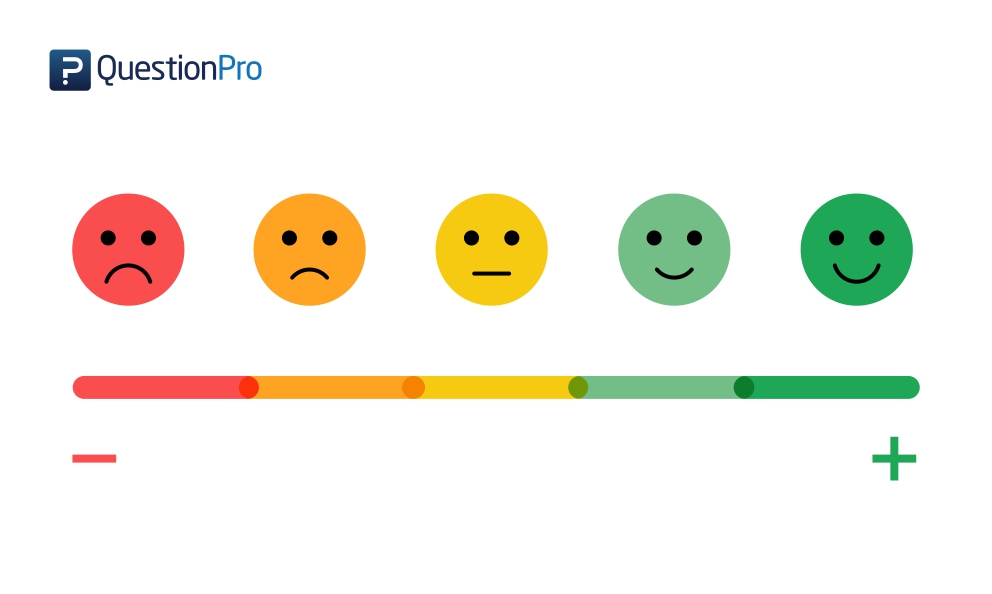
Content Index
What are Client Satisfaction Surveys and Client Survey Questions?
Reasons to conduct client satisfaction surveys, tips to conduct effective client satisfaction surveys, top 20 client survey question examples.
Client satisfaction is an important metric for the growth of an organization and client satisfaction surveys are conducted to gather client feedback about new products or services , upcoming concept and feature updates, client service and other domains of an organization. An organization, however small or large, focuses on designing products, services, and overall strategies according to their clients. Keeping clients satisfied is the primary goal of every organization in order to elevate business. Gauging client experiences with an organization not only helps the management of an organization to strategize better to minimize or eliminate negative feedback , but also channelizes the efforts put into making an organization’s operations more effective.
Client satisfaction surveys are often used to collect client feedback, compare various feedback to form new marketing strategies and improve products and services to contribute to overall progress. Satisfied clients go to great lengths to spread the word about their experience and knowing the number of satisfied clients will only be productive for an organization.
To know accurate feedback about desired subjects, an organization has to include appropriate questions. Client survey questions can be classified into the following –
- Client service: Client service team is in direct contact with most of the clients, solving their issues every day. A customer satisfaction survey should include questions that can be helpful in understanding how to improve client service to improve satisfaction levels for that aspect of the organization.
- Website and navigation: Since websites and online navigation have become widely popular with clients, it becomes critical to understand what clients think about an organization’s website and navigation . Learning how to improve the website and fixing client complaints with regards to a website has become important for an organization.
- Product/Service purchase and delivery: An organization’s success or failure is hugely dependent on the quality of the offered products and services. Including survey questions about product purchase and delivery will provide insights into how to improve the products so the client satisfaction can be enhanced.
- Client loyalty and brand shareability: Client loyalty is a factor that is entirely up to the client. They choose to be loyal towards an organization and not the other way round. Adding and analyzing the Net Promoter Score and other client loyalty measurement questions will offer data on the basis of which activities can be created to improve client loyalty.
- Marketing activities: There is a significant amount of effort that goes into contacting a client and knowing which marketing source produces the most impactful results. A marketing team does activities which reap results but there are instances where clients learn about the organization through less-known mediums. Including client survey questions regarding the marketing aspects of an organization can lead to the understanding of which mediums can be better used to improve the quality and quantity of clients.
Learn more: Market Research
There are new organizations launching every day and with the increasing competition in any market, it becomes crucial for any organization to constantly improve client experiences. Clients require a platform where they can share their pleasurable and not so pleasurable experiences and there can be no better platform than a satisfaction survey .
Here are the reasons to conduct client satisfaction surveys:
- Clients provide insights to improve products/services as well as overall purchase experience:
Clients appreciate it when organizations are proactive in collecting and implementing feedback. Data collection about client expectations and demands can lead to an effective development of a new product/service or feature update.
- Client feedback can help in retention:
It is the clients who are responsible for the progress of an organization and their opinions are extremely valuable for those who intend to grow. In case a client is dissatisfied with his/her experience, it is an organization’s main duty to bring a solution to the reason of dissatisfaction. Those organizations who work towards the improvement of their products/services according to the received feedback may eventually gain a loyal client.
It is easier for organizations to retain clients who would express their dissatisfaction when asked via a client satisfaction survey . An organization should carefully listen to client complaints and ensure them that the complaints will be resolved within a particular time-frame. Constantly working to create a better client experience should be the ultimate motive so that retention becomes easier and more effective.
Learn more: Client Satisfaction Surveys
- Satisfied clients can be better at product promotion:
The client management of an organization would know the importance of a loyal client. Providing best-in-class products is one thing and utilizing clients to spread the word for the products is another.
It is observed that a loyal client can tell at least 9 others in their network about the brand they are satisfied with. Many organizations thrive on brand advocacy and it is client loyalty that makes them talk about a particular brand with their friends, colleagues, and family. It is reported by a reputed business school that a referred client is 16% more likely to stay loyal to a brand than the others.
- Make well-informed business decisions:
Clients are the most trustworthy sources of information that backs major business decisions. By creating an effective client satisfaction survey using the best client satisfaction questions, an organization can collect quantitative data that can be used to make thorough business-related decisions.
Learn more: Qualitative Data
Writing effective client satisfaction surveys is a skill which requires the creators to keep the following tips in mind:
- Create an unbiased client satisfaction survey:
Always have an unbiased opinion about your products and services so that the questions created do not reflect the bias. While adding questions , keep away from adding superlative adjectives to describe the question and instead, include questions that are as unbiased as possible.
For example, instead of adding a question such as “What do you have to say about our enthusiastic sales executives?”, the survey should have this question: “What are your comments about our sales executive?”
- Avoid questions based on conjecture:
There are many organizations which include hypothetical scenarios in their surveys only to realize that the obtained answers were not effective for their business. Including questions based on theories may not always be fruitful. A Likert Scale or Semantic Differential Scale question can be used to gather customer experience ratings.
- Include easy-to-understand questions:
Survey questions form the most basic section of a client survey. Confusing the clients by using complicated language or context may lead to clients dropping-out from the survey . Respondents will never spend excess time reading complex questions and this made reduce the survey response rate .
- Balance close-ended and open-ended questions:
Close-ended survey questions provide insights from the list of answer options mentioned in the survey and open-ended questions allow respondents to freely respond. There may be questions such as “Do you enjoy working with our organization?” which will have just two answer options – Yes and No. But, this question can be molded into an open-ended question to collect more information.
- Keep the survey short and precise:
A survey creator is always interested in collecting as much information as possible but this often results into a long survey which eventually will not be effective in gaining desired results. Short surveys with a selected number of survey question will be much more effective than a long and imprecise survey.
Learn more: Sample Survey Questions & User Interface Survey Questions
As discussed earlier, there are five bifurcations for client surveys. Here is the list of 20 client survey questions according to those divisions:
- Client Service
Almost 45% of clients are annoyed by the helpdesk executives and 30% of client care executives do not have the required knowledge. These statistics can hamper the progress of an organization and thus, knowing about client service from a client satisfaction survey is important.
- Very Professional
- Adequately Professional
- Neither Professional or Unprofessional
- Not Very Professional
- Not At All Professional
Learn more: Client Service Surveys
- Website and Navigation
There are situations where website drawbacks and inefficiencies are visible to the clients and not the organization’s management. These client survey questions can be included to understand aspects of the websites which can be improved only to observe an increase in the customer satisfaction levels.
- Very Easily
- Not Very Easily
- Less than 1 second
- 1-2 seconds
- 2-3 seconds
- More than 3 seconds
- On a scale of 0-10, how user-friendly is our website?
Learn more: Website Evaluation Surveys
- Product/Service purchase and delivery
The aspect of customers enjoying the purchased products or appreciating the manner in which the product was delivered is important for an organization’s evolution.
- Very Similar
- Very Different
- Was the product easy to install? If not, what are the problems while installing? (Open-ended question)
Learn more: Product Surveys
- Client loyalty and brand shareability
Client loyalty is closely associated with brand shareability and retention. For an organization to be competent with regards to client retention, the following questions should be added in the client satisfaction survey:
- On a scale of 0-10, How likely are you to recommend our products to your friends and colleagues? ( Net Promoter Score Question )
- Yes, only via Email
- Yes, only via SMS
- Yes, via Email and SMS
Learn more: Net Promoter Score Surveys
- Marketing activities
The marketing team leads from the front to build an organization’s brand value and client feedback about the marketing approach is vital.
- Social Media Channels
- Newsletters
- Medium/Quora or similar platforms
- Not Very Often
- Not At All Often
Learn more: Marketing Surveys
MORE LIKE THIS

The Best Email Survey Tool to Boost Your Feedback Game
May 7, 2024

Top 10 Employee Engagement Survey Tools

Top 20 Employee Engagement Software Solutions
May 3, 2024

15 Best Customer Experience Software of 2024
May 2, 2024
Other categories
- Academic Research
- Artificial Intelligence
- Assessments
- Brand Awareness
- Case Studies
- Communities
- Consumer Insights
- Customer effort score
- Customer Engagement
- Customer Experience
- Customer Loyalty
- Customer Research
- Customer Satisfaction
- Employee Benefits
- Employee Engagement
- Employee Retention
- Friday Five
- General Data Protection Regulation
- Insights Hub
- Life@QuestionPro
- Market Research
- Mobile diaries
- Mobile Surveys
- New Features
- Online Communities
- Question Types
- Questionnaire
- QuestionPro Products
- Release Notes
- Research Tools and Apps
- Revenue at Risk
- Survey Templates
- Training Tips
- Uncategorized
- Video Learning Series
- What’s Coming Up
- Workforce Intelligence
Learn / Blog / Article
Back to blog
How to write customer satisfaction survey questions to master your market [with examples]
Happy, successful customers are the heart and soul of any business. They’re what transform your growth from a funnel into a flywheel.
You can create happy customers, but to do that you have to truly understand them and what they think about your business.
So how do you know what they’re thinking? You have to ask!

Last updated
Reading time.

To provide an inside perspective on surveying customer satisfaction, we collaborated with Michael Redbord, who helped build HubSpot's support and service teams and has worked with customers for over eight years. Today, he’s the General Manager of HubSpot's newest product line, Service Hub , which helps their customers grow through exceptional service.
Both Hotjar and HubSpot use customer feedback surveys to understand our customers and what the market demands. For HubSpot, this approach has driven dramatic changes over the years—taking them from a small marketing app to the more complete front-office software suite they are today.
In this article, Michael shares the most important things he’s learned about customer satisfaction surveys, so you can take some of his learnings and use them to adopt a practice of collecting customer feedback for your business to better understand your market.
What is a customer satisfaction survey?
4 types of customer satisfaction surveys, 11 customer satisfaction survey question examples, 4 customer satisfaction survey templates, 4 more ways to understand your customers, create a customer satisfaction survey today.
With Hotjar, you can create a survey in seconds that will help you better understand your customers and find out if they’re truly satisfied.
A customer satisfaction survey is a questionnaire designed to help businesses understand what their customers think about their products or services, their brand, and their customer support. Customer satisfaction surveys allow companies to improve products strategically, increase customer retention , optimize the user experience , create customer delight , and deliver exactly what the market demands.
Michael emphasizes how HubSpot uses customer satisfaction surveys to understand the micro-level experiences of individual users and address their concerns, while always returning to macro-level questions like “Where is the market going?”, “How is our product on the cutting edge?”, and “Where do we need to improve?”
There are several ways to understand if your customers are happy, loyal, and satisfied with your product or service, and each can help you learn something about the user experience. Here are four of the most effective online surveys you can use to understand your customers.
1. Customer Satisfaction Score (CSAT)
CSAT surveys measure your customers’ overall satisfaction with a specific aspect of your business. They usually contain a simple question with a binary response (e.g. yes/no, happy face/sad face) and ask things like “Did our product do what you wanted it to do?”
CSAT scores are usually high (in the 98%+ range), so a sudden spike in negative scores tells you there’s an issue that needs immediate attention.
2. Net Promoter Score® (NPS)*
A Net Promoter Score ® survey asks customers to rate how likely they are to recommend your company or product to a friend or colleague on a rating scale of 0–10. You then compare your percentage of detractors (0–6 answers) to that of promoters (9–10 answers) to see where your company stands—the more promoters you have, the more you can infer people are satisfied with you.
Use NPS surveys to determine whether your business successfully cultivates customer loyalty.
3. Customer Effort Score (CES)
The Customer Effort Score measures how much effort it takes for customers to either use your product or fix a problem through customer support.
HubSpot sends a CES survey after they close each support ticket. A CES question will ask “How easy was it to solve your problem?”, and customers are typically given a 5-point likert scale with response options like ‘very difficult’, ‘somewhat difficult’, ‘about as easy as I expected’, ‘somewhat easy’, and ‘very easy'.
4. Milestone surveys
Milestone surveys are questionnaires sent out at key touchpoints in the customer journey to help understand the user experience. A milestone can either be time-based (e.g. sending a survey 60 days after signup) or experience-based (e.g. a pop-up survey that’s triggered once onboarding is complete).
There are many directions you can take your customer survey questions —and w hile there are no wrong answers, there are right questions to ask . Depending on the customer insights you want to gather, it’s important to choose the types of questions that will lead to the most actionable results.
For example, if you’re looking for quantifiable feedback that’s easily monitored over time, asking rating scale questions (like NPS or CES ) is the way to go. And to dive deeper into customer expectations and satisfaction levels, you should ask open-ended questions, or pair a multiple choice question with a follow-up question that gets users to describe their experience in their own words.
Here’s a list of example questions to consider when deciding what to ask your customers:
Customer feedback questions
Was this article useful? [yes/no]
Is our pricing clear? If not, what would you change?
What would increase the product quality, according to you?
In your own words, how can we improve the onboarding process?
Were you able to achieve the purpose of your visit today? [yes/no]
What’s the one thing that nearly stopped you from buying from us?
Did you get the help you needed during your customer service experience? [yes/no]
What persuaded you to complete the purchase of the item(s) in your cart today?
How likely are you to recommend us to a friend or colleague? [on a scale of 0–10 ]
What's the next feature or functionality we should build? [can be multiple choice]
How satisfied are you with the content on this page? [on a scale of 1 to 5, very dissatisfied to very satisfied]
💡Pro tip: there’s a customer satisfaction survey for just about every occasion, whether you’re testing a new feature, analyzing customer churn , or determining what, exactly, turns prospects into loyal customers. When the sky’s the limit, it can be difficult to effectively distill a bigger goal into specific and meaningful survey questions.
Hotjar’s AI for Surveys is the perfect tool to turn to—just tell it your goal and watch as it generates a corresponding survey in seconds. And don’t worry about handling high response rates: the AI will automatically analyze all responses and prepare a summary report with suggested next steps to take. Talk about a time saver!
To get started right away, here are four customer satisfaction survey templates you can use. If you’re looking for more pre-built survey examples, check out or bank of survey templates .
🔥 How it works : click on each image to learn more about the survey and try out a live version for yourself. Each survey takes only a minute to set up, so dive right in.
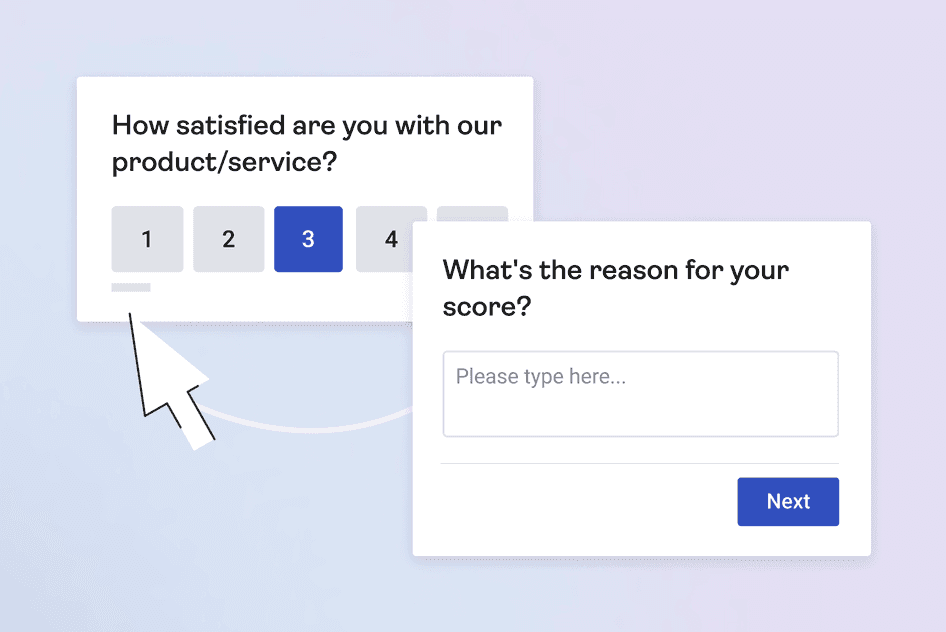
Find out how satisfied your customers really are with this CSAT survey template
2. Net Promoter Score® (NPS) survey template
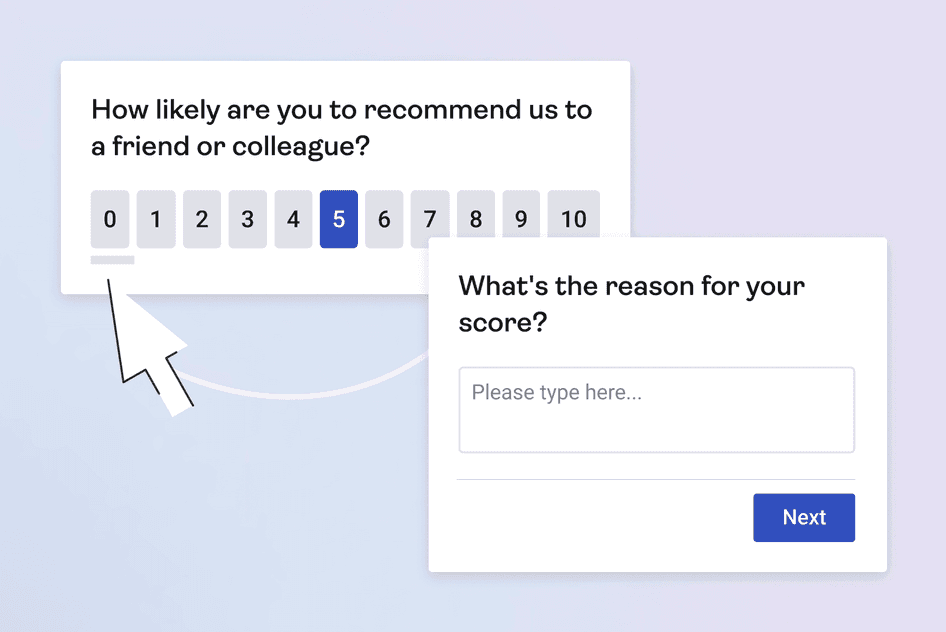
Hotjar’s NPS® survey template makes it easy to measure customer loyalty
3. Customer Effort Score (CES) survey template
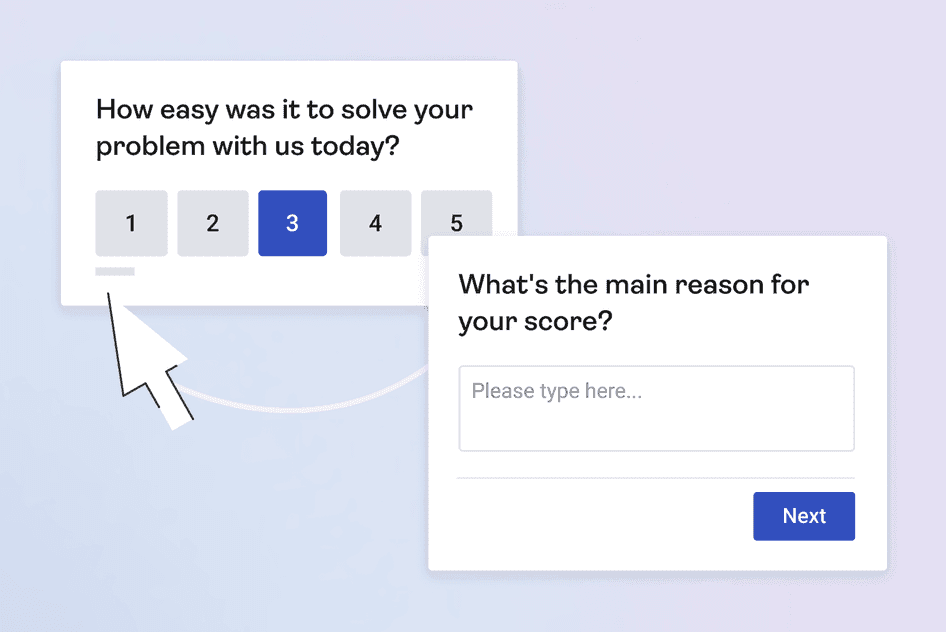
This CES survey template will help you make sure your customers are set up for success when using your product or dealing with your customer service team
4. Post-purchase (or point-of-conversion) milestone survey template
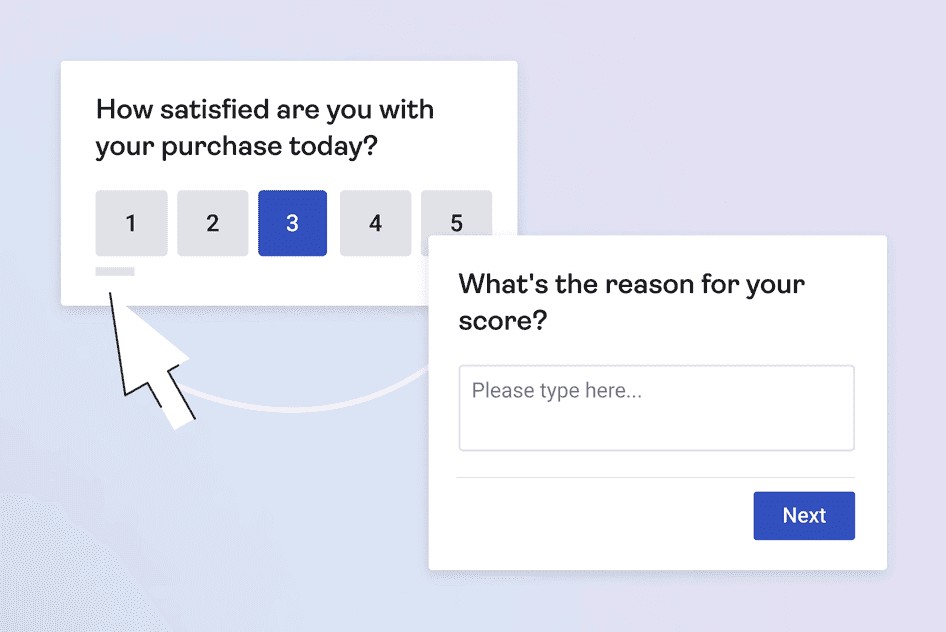
Check in with customers at a key milestone on their customer journey with this post-purchase survey template
💡Pro tip: want to make customer satisfaction a daily focus at your business? Automatically share customer feedback results with the rest of your team by integrating Hotjar directly with Slack or Microsoft Teams . Discuss insights and collaborate on initiatives without opening another app.
1. User personas
User personas are semi-fictional characters based on real data about the people who use your website. Getting to know your users will help you stay on top of the market by giving them what they want. Consider using a user persona survey to ask your current customer base specific demographic questions so you can build user personas off of real respondents.
2. Market research
Market research is a collection of techniques used to understand your target market. Good research identifies customer needs, fears, drives, and frustrations. You can use this information to home in on your target audience, design better products, and improve the customer experience .
3. H eatmaps
Hotjar Heatmaps are a visual representation of user behavior that shows where users click, tap, and scroll. They help you understand what page elements are interacted with or ignored, so you can start forming a clearer idea of what works (and what doesn’t) on your website. This is a great way to uncover any pain points that may be preventing users from successfully interacting with your website.
4. Session recordings
Hotjar Recordings show the anonymous activity of individual users, which you can tie to their survey answers. In other words, if someone tells you they’re having a hard time using your product, you can watch a recording of their activity to gain insights about the pain points they experience.
Final word of advice: by following these steps, you will be able to build a solid foundation for understanding your customers, addressing their needs and concerns on an individual or micro-level, and improving their overall experience on a larger scale. Of course, you might not see an immediate increase in your scores when you start making improvements, but if you collect solid data and trust in the process, your scores will improve over time—and your satisfied customers will ultimately drive your success.
*Net Promoter, Net Promoter System, Net Promoter Score, NPS, and the NPS-related emoticons are registered trademarks of Bain & Company, Inc., Fred Reichheld and Satmetrix Systems, Inc.
Related articles

User research
5 tips to recruit user research participants that represent the real world
Whether you’re running focus groups for your pricing strategy or conducting usability testing for a new product, user interviews are one of the most effective research methods to get the needle-moving insights you need. But to discover meaningful data that helps you reach your goals, you need to connect with high-quality participants. This article shares five tips to help you optimize your recruiting efforts and find the right people for any type of research study.
Hotjar team

How to instantly transcribe user interviews—and swiftly unlock actionable insights
After the thrill of a successful user interview, the chore of transcribing dialogue can feel like the ultimate anticlimax. Putting spoken words in writing takes several precious hours—time better invested in sharing your findings with your team or boss.
But the fact remains: you need a clear and accurate user interview transcript to analyze and report data effectively. Enter automatic transcription. This process instantly transcribes recorded dialogue in real time without human help. It ensures data integrity (and preserves your sanity), enabling you to unlock valuable insights in your research.

Shadz Loresco

An 8-step guide to conducting empathetic (and insightful) customer interviews
Customer interviews uncover your ideal users’ challenges and needs in their own words, providing in-depth customer experience insights that inform product development, new features, and decision-making. But to get the most out of your interviews, you need to approach them with empathy. This article explains how to conduct accessible, inclusive, and—above all—insightful interviews to create a smooth (and enjoyable!) process for you and your participants.
57 Customer Satisfaction Survey Questions To Ask For Better Feedback

Asking the right customer satisfaction survey questions can tell you much more than whether your customers are simply satisfied or dissatisfied. The answers reveal feedback that can help you retain business, validate business decisions and strategies, and ultimately grow your brand.
So, to help you create effective surveys , here’s a list of customer satisfaction (CSAT) questions to ask.
General customer satisfaction survey questions
Here are sample feedback questions that help you target opinions on overall experience, product or service usage, as well as customer motivations:
- On a scale of 1 to 10, how satisfied are you with our product or service?
- On a scale of 1 to 10, how satisfied are you with your experience on our site today?
- How would you rate your experience with our product or services today?
- How would you rate us on the following? (Follow with a list of products, services, or activities)
- How often do you use our product or service?
- Has our product or service helped you achieve your goals?
- On a scale of 1 to 10, how likely are you to recommend our product or service?
- Which three of these [features/offerings/etc.] matter more to you when you use our product?
- For what purpose are you using [product or service]? (Follow with a list and include ‘other’ as an option.)
- What’s the biggest gain you’ve seen while you’ve been using our product or service?
- What would you change about our product or service?
- What can we improve in our product or service?
- How can we improve our customer service ?
- What would stop you from buying from us again?
- Have you ever had a negative experience with us and if so, can you describe what happened?
- How have you used our services in the past?
- What can we do better?
You can send these general survey questions to your customer base periodically or directly after an event. For example, video and messaging apps like Hangouts and Viber will ask you about the quality of video and audio right after you finish calls.
Want to ask for feedback from your customers via email?
Try these seven email templates (plus tips to encourage your customers to reply).
Grab the templates here
Post onboarding survey questions
Here are questions that will help you understand whether your onboarding process works and where you can potentially make improvements:
- On a scale of 1 to 10, how satisfied are you with your onboarding experience?
- How would you rate your level of knowledge of what our product can do? (Follow with a list from low to high.)
- During the onboarding process, were you set up with everything you needed to use our product?
- Do you feel empowered to be successful with the product?
- Do you feel our product is going to help you achieve the goals that you want to achieve?
- Is there anything critical to your success that wasn’t covered during our onboarding process?
Post training survey questions
This is mostly relevant to SaaS, but if your industry also does customer training, you can modify these questions to specifically reference your services.
- How satisfied are you with your training?
- How confident are you about using our product/service?
- How well do you feel you know our product’s features after your training?
- Did you feel you got what you needed out of your training?
- Were all your questions answered during the training?
- What can we improve in our training process?
- What suggestions do you have for our team regarding training?
New product launch survey questions
Here are some questions to help you evaluate whether a new product has a future or whether it needs fine tuning:
- On a scale of 1 to 10, how useful is our new product to you?
- How would you rate our new product?
- How satisfied are you with our new product?
- Have you tried our new product?
- Have you used our new feature?
- Is our new product easy to understand?
- Do you have suggestions for improving our product?
Download all questionsWant to save all 57 questions for later? Make a copy of the full list .
Post purchase survey questions
Here are sample customer satisfaction survey questions to help you evaluate customer experience after purchases:
- How would you rate your shopping experience with us?
- How easy was it for you to navigate our site?
- How would you rate our communications while you were making your purchase?
- How would you rate our post-purchase communications?
- Was your order delivered in the timeframe you expected?
- Did you feel you were able to check your order status at any time?
- Was the item you purchased as described?
- Was our product or service as you thought it would be?
- How could we have improved your purchase experience?
- If you faced any challenges while you were shopping what were they?
The exact timing and length of your post-purchase CSAT or email surveys will depend on what you want to know. If you just want to gauge the overall feeling of your customers towards their purchasing experience, you can ask simple broad questions.
To inform more in-depth analysis , you can send a survey with multiple questions about price, site navigation, delivery time, and ask the customer to rate each one of them on a Likert scale. Amazon, for example, may ask you to rate a seller based on factors like speed of delivery, the accuracy of description, etc.
Post customer support survey questions
Here are customer satisfaction survey questions to help you assess how well your support team resolved customer issues or provided them the information they needed:
- How would you rate your experience with our support team?
- How would you rate the responsiveness of our support team?
- How would you rate the professionalism of our support team?
- How effective was our chatbot in understanding your question?
- How easy was it for you to navigate our help center?
- Did you get help in a timely manner?
- Did our chatbot help you get the answers you needed?
- Did you find what you needed in our help center?
- What would you change in our help center if you could?
- Please help us improve by giving us your opinion on our support process.
These types of questions can be sent automatically to customers when a support ticket closes.
How to create customer satisfaction survey questions
To make the most of your customer satisfaction survey , keep these tips in mind:
1. Plan your customer survey correctly
2. consider the different types of customer satisfaction survey questions, 3. follow best practices when creating survey questions.
Here are some more details:
Think about:
- Survey timing. Is it a generic quarterly survey or is it taking place after a critical milestone like a product order or customer onboarding? If the survey is in relation to a particular interaction, it’s important you don’t leave too much time between the two.
- Target audience. B2B and B2C companies often vary significantly in the questions they ask customers. Similarly, when your buyer isn’t the same as your end-user, you might end up asking different questions depending on who takes the survey.
- Survey Purpose. Decide your desired survey outcome first, i.e., do you want general customer satisfaction feedback or actionable qualitative data to inform your strategy? What other metrics are you trying to measure (e.g. customer effort score (CES) or net promoter score )?
Are you prioritizing the right CS KPIs?
Learn how CS leaders are measuring their teams' impact on growth and revenue.
There are different types of questions based on the response format and the reason behind the question. Having a mix of these types can help you get better insight. Here are some examples:
- Multiple choice questions (e.g. choose A, B, C)
- Likert scale questions (e.g. choose on a rating scale of 1 to 10)
- Matrix questions (e.g. how satisfied are you with each of the following aspects of your experience? Very satisfied to very dissatisfied)
- Open-ended questions (e.g. explain your answer)
- Demographic questions (e.g. age, gender, education category)
- Ranking questions (e.g. rank these items in order of importance)
- Image choice questions (e.g. choose the image showing the better user experience)
- Click map questions (e.g. click on the part of the image you like the most)
- Slider questions (e.g. drag the slider to rate your answer)
- Avoid double negatives. For example, don’t ask “Do you dislike not having product notifications?” These questions confuse respondents.
- Ask why instead of if. For example, ask, “Why do you like our product” instead of “Do you like our product”. With this approach, you maximize the amount of actionable feedback.
- Avoid leading questions. Don’t ask, “Are you satisfied with our award-winning customer support?” This may make respondents feel uncomfortable sharing their true views.
- Ensure questions match response formats . If you ask “Are you satisfied?”, the answer should automatically be yes or no. If you want to use a Likert scale (e.g 1 to 10), modify the question to something like “How satisfied are you?” If you want to use a star rating, change it to “How many stars would you give us?” and so on.
- Use open-ended questions whenever it makes sense. Open-ended questions draw out deeper insight, but they’re more time-consuming to respond to and more difficult to analyze. Use them sparingly for only the most cutting questions.
- Be careful with demographic questions. If you want to collect demographic data, do it at the end of the survey and only ask for the information you absolutely need. Be sure to be inclusive, too, and keep an eye out for laws. For example, some countries forbid asking for age unless the question is optional.
Be serious about feedback
Although sending targeted CSAT surveys is important, successful companies are open to feedback constantly. Apart from sending surveys with tools like Delighted, Typeform, and SurveyMonkey, try to cultivate a level of trust that will encourage your customers to proactively tell you what they think.
For example, you can include a link to anonymous surveys in every email communication. Or, you could place a link in a prominent position on your site. You could even use your chatbot to collect feedback from customers 24/7.
Most importantly, show that you care about your customer’s voice . And the best way to do that? Act on the feedback you get. Many customers don’t believe that companies act on the feedback they provide. So, this is a great opportunity to positively surprise them.
Check out how the Acquire platform helps you offer the customer experience people want .
Related Articles
.webp)
21 Powerful Customer Satisfaction Survey Questions
.jpeg)
Customer satisfaction informs you about customer happiness . It tells how satisfied your customers are with your products, services, and capabilities. Along with product reviews and ratings, customer satisfaction helps you improve your services , develop your products, and make the overall experience with your site more user-friendly.
Here at Survicate , we are obsessed with client satisfaction , and you should be, too. After all, providing high-quality products, services, user experience, and customer care brings money to the bank.
But, how do you find out if your customers are truly satisfied? It's simple! Start sending customer surveys frequently and asking the right customer satisfaction survey questions .
In this article, we will show you 21 perfectly designed examples of customer satisfaction survey questions for SaaS and free, ready-to-use survey templates . Depending on their goal, we divided the questions into four groups:
- Product feedback
- Customer effort while dealing with the website and the product
- The position of your company against the competition
- The general experience with your company

Customer Satisfaction (CSAT) survey
The most basic way of measuring customer satisfaction is by using the CSAT question . Here are the questions it comes with and how you should use it.
1. How satisfied are you with [product name]?
This question measures customer satisfaction overall. Responses will help you discover your customers’ needs and give you ideas for changing and improving. The score is a widely recognized customer experience metric. It helps predict company growth and reduce customer churn .
This question is usually measured on a five-point rating scale. (However, you some choose to use other Likert scales, eg. 1-to-10 rating scale surveys .) You can use numbers or a star rating system. A great tool like Survicate will also let you take advantage of the Likert or smiley scale.
Product feedback survey questions
Simply put, a product survey is a powerful way to discover what your customers think about the products or services you offer.
Running surveys before launching a new product means you get to see what people expect. Product research cuts the risk of developing good-for-nothing features.
Plus, depending on the survey questions you include, it can help you create and design what you’re making.
You can also use product feedback surveys for existing products to see how users enjoy the experience. So they’re always helpful.
2. Which of the following words would you use to describe our product?
Why should you care how people would describe your product? Because it’s an important issue when your product gets described as ‘buggy’ instead of ‘life-saving.’
If you don’t want to give your users any suggestions, you can use the open-ended variation of this customer survey question and ask "How would you describe our product?”.
Answers to any of those will show you how well you communicate your value proposition and product vision to users . If your goal is to provide them with the world’s most sophisticated graphics software and people describe it as ‘Paint with 1 cool feature,” it means that the communication is broken.
Hint: Check what are the most common positive words used to describe your product. If they are very frequent, it may indicate that this is what your customers are looking for in your product. You can use such words in your future marketing campaigns.
💡 YOU MAY BE INTERESTED IN: Product research survey templates library
3. How well does our product meet your needs?
This broad product question is nonetheless specific enough to provide actionable results. Offering a product or service that meets customer needs is a prerequisite to providing high customer satisfaction. If the product doesn’t meet the needs of users they are more likely to churn .
Hint: To make this customer feedback question even more actionable, ask the following two questions.
4. Which 3 features are the most valuable to you?
This question is vital for SaaS companies . Their products tend to offer dozens of features and most of the customers use only a handful of them.
Researching which ones are the most important and valuable to users will help you understand how customers interact with your product and what they really need .
Don’t be surprised when people say that the most important to them are features you consider secondary. We discovered exactly this with our exit intent survey —a simple feature that turned out to be a must-have for many customers.
5. What are the 3 most important features we’re missing?
Offering exactly what your customers need helps improve retention . If the product doesn’t offer everything your customers need, sooner or later they will find another provider.
The same goes for e-commerce —customers are more likely to return if you offer what they are searching for and want to buy.
Answers to this customer survey question will help you minimize risks associated with building a product roadmap or planning expanding inventory.
6. If you could change just one thing about our product, what would it be?
This is a variation of question 4. This time you're asking about just one change your customers would like you to introduce.
Now, you're not considering consider any missing features. What you do take into account is that your customers may have very specific needs regarding the products you already have.
As with the question above, the main purpose is to improve customer retention . Take into consideration all the suggestions made by your customers.
Firstly, focus on the most frequent ones. Act on any feedback you receive as failing to do so is a mistake that may cost you too much too soon.
7. What problem would you like to solve with our product?
This question asks for information that usually cannot be gauged by analytics which is the type of solution your customers search for.
Knowing the answers to this question allows you to focus on the strongest features of your product and helps to prioritize any future improvements that could be made.
Hint: It’s great to ask this question even before finalizing the sale. Your potential customers might be looking for something different than what the product they've picked offers.
If you have other products that would suit their needs better, it’s great to point them towards them before it’s too late and they get disappointed with a product that was not designed for what they actually need.
8. How would you rate the value for the money of the product?
That is a very valid customer satisfaction survey question. First and foremost, you should use it while considering any changes to the pricing of your product or service.
If the feedback you receive proves that your customers think that your product is too expensive, you should definitely reconsider your plans to increase your prices. Maybe you could reach your financial goals by introducing some sales or discounts instead.
Hint: It’s great to ask your customers these questions after they've used your product for some time. You might want to follow up with them after a finalized purchase, e.g. two weeks or one month after the sale.
Further Reading: Top 10 Product Surveys and Product Survey Questions
Customer Effort survey questions
9. how easy is it to navigate our website.
This is a must-have question to use when there are any changes in the UX design of your website . What you consider innovative, easy, and user-friendly , may not be seen the same way by your customers .
Take into consideration any feedback you receive. Unheard complaints from your users may result in churn, so make sure they are happy with what they see and find on your website.
When it comes to new users or potential customers, it is also great to ask them this customer satisfaction survey question .
Your customers may see your website from a totally different perspective. It is worth taking their opinion into consideration.
10. Were you able to find the information you were looking for on our website?
It’s obvious you want your visitors to find the information they need as easily and as quickly as possible. The happier they are with the navigation of your website and the time they take to get the information they need, the higher the chance they will return and bring new customers with them.
Hint: If there is certain information that seems to be particularly hard to find for your visitors, make sure it’s somewhere they will have quick access to. It may be worth a shot to add another section to the menu that would link directly to that subpage.
11. How much effort did you personally have to put forth to handle your request?
Customers’ need for support is the one thing that you should always take into consideration, whether it's with your website or the product. It’s crucial that your customers are able to fill their complaints and get support quickly.
Quick actions to fix bugs and support your customers can enhance retention and make your workflow much smoother.
12. How did this effort compare to your expectations?
This is a satisfaction survey question that can give you a clear indication of whether what you are doing is a reflection of customers’ needs. If the effort your customers had to put in was greater than they expected, it should give you some food for thought.
It may be beneficial to reconsider the stages where your customers faced difficulties. Maybe some processes need simplification?
It’s possible that your customers expected your product or service to be more difficult than it really is. If you managed to exceed your customers’ expectations, keep going, and keep moving forward!
Hint: Send this question, along with question number 10, in a follow-up survey after providing customer support. It should happen no later than a day or two afterward to get a fresh insight into the quality of provided support.
13. How responsive have we been to your questions or concerns about our products?
This customer satisfaction survey question is wonderful at the end of any interaction with a customer that required support. This is a clear indicator of making sure you spend enough time supporting them to make them feel well taken care of.
14. To what extent do you agree with the following statement: The company made it easy for me to handle my issue.
This customer survey question is great because it encompasses a lot of issues at the same time. You can use it to monitor your customers’ overall experience with your website, your products, or any requests they may have.
Allow them to, first, give a specified rating and, later, to express their opinion in their own words. Any feedback you may receive in this case is very valuable, as it gives you information on whether there are any hot spots in your workflow that require immediate action.
Hint: As with questions 10, 11, or even 12, this customer satisfaction survey should be sent to your customers very soon after providing support. The fresh perspective can give you a clear indication of what you are doing right or wrong.
Feedback on your position against your competition: survey questions
15. compared to our competitors, is our product quality better, worse, or about the same.
This is a wonderful satisfaction survey question: it’s straightforward and very measurable. It gives a very clear image of the quality of your products in comparison with your competition .
It may and should be followed by questions that will go into greater detail on your customers' opinions, but it is a great starting point for taking any further actions.
Hint: Send such customer satisfaction survey somewhere between two weeks and one month after the purchase. Let your customers take some time with your product and get to know it a bit better before judging it against your competitors.
16. Why did you choose our product rather than a competitor’s?
Here, you ask for information on the things that differentiate your product from your competition. You want to know what tipped the balance in your favor.
It’s not only important to know what can be improved, but also what is noticed by your customers as good and valuable. You want to take this into account while considering any changes or improvements in the strategy of your product.
17. Which other options did you consider before choosing our product?
You may think you don’t need this customer feedback question to know what your competition is. The truth is, it’s good to know exactly which products your customers believe to be your competition .
Sometimes they take into account companies that you would never think of.
It is especially useful to know if they happened to compare you with a totally different type of product. Then, it is worth a while to check if your communication with potential and current customers creates a clear image of your product that is coherent with your own vision .
Besides, the odds will be in your favor if you use the feedback to constantly improve what you provide to your customers and make sure that you are a better option than your competitors.
Feedback on the general experience with the company: survey questions
18. on a scale from 0 to 10, how likely are you to recommend our company to a friend or colleague.
This simple customer feedback question (followed by the question ‘Why?’) changed the way marketers see customer satisfaction. Net Promoter Score®, otherwise called NPS, introduced hard data to the world of quantitative data and assumptions.
Measuring and improving your NPS should be the first step in improving customer satisfaction.
Recommended reading: What is Net Promoter Score? The Guide to Top NPS Surveys
Hint: The standard for NPS is to research it using email surveys . However, if you run a news website or other type of business where you don’t really have customers, NPS can also be effectively used. Just run the survey on a website using targeted website surveys .
Target either returning users or use the more elaborate technique based on viewed URLs or cookies.
19. How likely are you to buy again from us?
Why bother researching repeat purchase intention when you can see in Google Analytics how many people actually bought something again? However, GA won’t help you if you’re just starting a business or if you sell durable goods.
Think about cars or furniture. People don’t buy them once a month. So, if you want to see how many customers will come back, you need to wait as long as several years to get the data. But you can capture intent sooner. Just ask your customers.
Hint: Send such client satisfaction surveys to your customers on a regular basis, e.g. once a year, depending on your industry and Customer Lifecycle. The best idea would be to observe the medium frequency with which your customers are making their purchases.
Observe trends and find out what are the reasons for increasing or decreasing the intent of buying again. Plus, you can then check how answers translate into actual acquisition. It will allow you to build a model of repeat purchases.
It will just require integrating your survey tool with Google Analytics or a similar tool you’re using. Learn more about this in our article on measuring customer satisfaction .
20. What would you say to someone who asked about us?
You should not be fishing for compliments with this customer survey question. What you can measure here is the customer’s general perception of your product and your brand. It will help you to check if what you consider your company to be is really what your customers truly see.
It will help you specify the image you want your company to have and implement actions that will allow you to achieve it.
21. What else would you like us to know?
This is a truly universal customer feedback question. No matter what the subject of your survey is, it is always valuable to ask if your customers have anything else to say.
It can give you additional insights, sometimes on issues that you would not expect. This, in turn, allows you to take necessary actions much more rapidly.
Hint: You can either send this customer satisfaction question in a targeted website survey (e.g. after the website visitors respond to your questions regarding the pricing while on the pricing page), in-message surveys via email (either with the follow-up surveys after the purchase or providing the customer support), or in your exit/return intent surveys (it can give you the actual answer why they decided to churn or return the product).
Recommended reading: If you are working in marketing, spend another minute to read Top 10 Marketing Surveys and Marketing Survey Questions.
Why are customer satisfaction surveys important?
Customer satisfaction surveys are essential because you can check if providing the best customer service or product checks out with reality. You can keep a high level of customer satisfaction that can be a strong predictor of customer retention, loyalty, and product repurchase by quickly responding to negative experiences.
Satisfied customers are more likely to purchase again and recommend the shop to their friends and coworkers. A loyal customer is worth even up to 10 times more than their first order.
Check out our infographic on the importance of customer satisfaction for more statistics that prove you can't ignore measuring your clients' happiness!
How long should a customer satisfaction survey be?
Customer satisfaction surveys should be as short as possible . No one wants to spend 30 minutes answering questions. People are busy, your customers/leads included. Surveys with 1-3 questions have the highest average completion rate (83.34%).
Think hard about what you want to achieve with your survey or what information you want to get. The more questions your questionnaire includes, the longer it takes to fill it in, the lesser the chance your respondent will complete it, especially if it's a mobile app survey since mobile users tend to have shorter attention spans.
FURTHER READING:
- How To Get Survey Completion Rate of Over 80% [Real Study]
- How To Get People to Take Your Survey & Get More Responses
- Top 11 Survey Incentive Ideas to Use Without Breaking the Bank (Ultimate Guide)
When should you send a survey to your customers?
To get the most reliable answers, you should send satisfaction surveys to your customers right after they have experience with your products or services—it's called a post-purchase survey .
This way, your customers' experience will be fresh enough, and you’ll be able to make sure you’re offering a perfect experience or quickly make amends. On the other hand, you want to measure customer experience with your product or services constantly, so we suggest you set up customer satisfaction surveys on a regular basis (daily, weekly or monthly). Just don't be too offensive to your customers.
Ready-to-use free survey templates
Survicate is a powerful customer satisfaction tool . Here are the top 15 ready-to-use survey templates used by Survicate customers - so you never run out of ideas on what survey to run next.
- NPS (Net Promoter Score) - Ask how likely customers are to recommend you. Predict repurchases and referrals.
- Product-Market Fit - Discover what’s the key benefits people get from your product. Build products people love.
- Website Experience - Get people to rate your website’s usability, then make the right improvements!
- CSAT ( Customer Satisfaction Score ) - Establish if customers are happy with your product or service. Fix what’s not working well.
- CES (Customer Effort Score) - Measure if doing business with your company is as easy as pie.
- User Experience - Ensure your users are happy with the experience they get.
- Brand Awareness - Validate your product position on the market.
- Churn Reason - Reduce churn by collecting insight on why your customers cancel their accounts.
- Exit Intent - Uncover why visitors leave your website or product. Remove the obstacles to reduce lost leads.
- Reader Interest - Get new content ideas. Find out what your audience would like to read about next.
- Buyer Personas Research - Learn more about your leads and customers so you can sell to them more effectively.
- Content Rating - Establish if your audience enjoys your content, and what you can do to make it better.
- How Did You Hear About Us - Find out where your clients first came from and which channels are worth investing resources in.
- Likert Scale - Let your audience rate the different aspects of your business with just one question.
- Coronavirus returning to the office check-in - Find out how your employees feel about returning to work in the office and how to support them.
How brands use surveys to get more value

Droplr used surveys to determine what their users thought about the app and learn why some of their users remain inactive.
The NPS survey allowed Droplr to identify promoters and detractors and target each group with a different Intercom campaign.
Promoters as a group of delighted users were invited to write a product review. With this approach, Droplr managed to increase the number of reviews 16 times!
Droplr also started to survey inactive users by asking, “Did you have any problems after signing up on Droplr?”. They quickly discovered that some of the users got lost in the product, their onboarding wasn’t smooth, while for others, it was difficult to understand the product value.
Thanks to surveys, Droplr started to better educate its users with guides, tips, and case studies. Read the complete Droplr case study .

Looka surveyed its customers to find out why they failed to finalize a logo purchase.
Respondents had five options to select from:
- Not ready to start my business
- The logos are too expensive
- I can’t perfect my logo design
- Too busy to finalize my logo
- I used one of your competitors
Looka learned that many customers who didn’t purchase their logo package found it too expensive. This led them to develop a new pricing package that was location-dependent.
While $65 for a premium logo package may be reasonable in North America, entrepreneurs in developing countries can find it cheaper to hire a graphic designer.
Pricing changes allowed Looka to increase its ROI by 2400%.

Weex used surveys to identify churn reasons. The company sent out an email survey to their churned customers saying: “We’ve noticed you’ve recently ported out. Can you tell us what was the reason?” (In telecommunication, the term “port-out” means to switch between mobile operators).
As soon as Weex discovered the two main reasons for churn—inadequate network coverage (which was beyond their control) and a lack of understanding of the product offering, they could address the issue.
Weex changed its product communication and presented it more transparently. Read the complete Weex case study .
Looking for more inspiration? There are many more customer stories to explore!

The easiest way to measure customer satisfaction
Asking the right question is the key to researching customer satisfaction. Of course, you can ask questions such as ‘How satisfied are you?’ but the answers won’t provide you with very detailed and substantive conclusions.
It’s always better to ask more specific questions . The answers will clearly show you what works well and which areas of your activity need improvements and how urgent they are. While creating a survey , you can also include questions that are not directly related to customer satisfaction but are important to you.
For example: Ask how customers found out about you, what their demographics are (roles, parental status, etc.—anything that will help you tailor services to their needs), or whether they used any similar products before.
The choice depends on what exactly you want to research and your target audience.
You can learn how to build your ideal customer audience in order to better tailor your services or products with our customer segmentation guide .
Often, it’s better to create and send one survey with six to eight questions than to create one survey with five questions to research customer satisfaction, and send another short survey later on to research something else.
Regardless of what kind of survey you'd like to send, we have over 400 templates for you to choose from. With our free trial , you'll get a taste of our Business plan for 10 days. What's not to like? Sign up for free and start measuring customer satisfaction today!

We’re also there

- Terms and conditions
- Adience privacy policy
A guide to customer satisfaction research in B2B, including asking the right questions
September 29, 2023

Lots of businesses claim to be customer-centric, yet not enough companies ensure their customers are actually satisfied.
Tracking customer satisfaction, identifying any issues, and then taking action to improve these results in happy product buyers and users. They are more likely to buy again, increase their spending, remain loyal customers, and recommend you to their contacts.
These contacts could soon become customers themselves, without any acquisition costs or business development efforts on your part. However, on the flip side, most dissatisfied customers will leave – you can replace them, but that needs more time and resources.
Keeping customers costs up to 25 times less than capturing new ones, Hubspot reports . Not only that, but Profitwell has estimated a 60% increase in customer acquisition costs over five years – and these costs are higher in B2B than B2C .
Therefore, every B2B company can benefit from a regular B2B customer satisfaction study to help retain satisfied customers.
The research reveals customers’ needs and wants, so you know what they expect from you. Satisfaction tracking sets a benchmark for your business – standards to maintain, or aim for if your current performance is below par.
It also outlines what customers think of your brand and gives less vocal ones a platform to share their views on perceived service quality constructively. An insightful B2B customer satisfaction research study can help boost both the top line and bottom line, by showing you:
- How to keep customers, growing revenues
- How to improve customer loyalty, reducing acquisition costs
- What customers’ unmet needs and wants are
- Where your business needs to improve customer satisfaction
- How your business is performing against competitor benchmarks
How to do B2B customer satisfaction research projects
Areas of customer satisfaction to explore
Best practices for customer satisfaction research in B2B
Here is our advice for conducting customer satisfaction research projects end-to-end with a B2B audience including:
- Research setup
- Methodology
- Design and fieldwork
- Analysis and reporting
#1 Research setup
First things first, engage key internal stakeholders at the outset and put a plan in place to keep them informed throughout the project. This is crucial if your customers interact with different departments across the business, e.g. service, product, sales, and account teams.
Gain the support of stakeholders who oversee customer relationships as soon as possible. Don’t bypass them otherwise, they and/or their customers may react badly and question why you kept them out of the loop.
Stakeholders may:
- Need to grant access to customer contact details or check data-sharing permissions
- Require convincing that customer satisfaction research will bring benefits
- Have their own questions to ask, so they should have input in the design stage
- Need to follow up on the research results
This last point is vital. Any key stakeholders excluded from the research process could challenge the final insights and recommendations – querying if you asked the right questions or included the right mix of customers.
This is where it helps to have a market segmentation , splitting your customer base into different groups with comparable wants, attributes, and behavior. Recruiting for a customer satisfaction research project based on your segments means you can compare results later on and develop separate follow-up action plans.
If specific customer accounts, segments, international markets , etc. spend significantly more than others, factor these differences into your research setup. Make sure you not only include key groups in the research, but you factor in their relative importance.
Aim to explore strategically important relationships in-depth. Try to focus on major accounts as a priority, but sometimes stakeholders are keen to include everyone.
Work with internal stakeholders to decide upfront which customers’ feedback matters most, before recruiting respondents. Set target quotas to ensure a representative spread of your customer base – in terms of your main buyer segments, customer spending, etc.
#2 Methodology
When it comes to deciding between quantitative and qualitative research to measure customer satisfaction:
- Quant is traditionally the more common approach for customer satisfaction research, with businesses looking for robust satisfaction metrics to track over time.
- But, in B2B research, note that a customer satisfaction survey will usually have a smaller base size in comparison with a B2C one. The target market is relatively smaller and senior decision-makers willing to take part in research are much harder to find in B2B .
- Tracking customer satisfaction metrics is only useful coupled with an understanding of why you received that rating. Ideally, resources permitting, aim to get qual insights from across your customer base, on top of a quant survey.
- Qual depth interviews with decision-makers at your major accounts help reveal the reasons behind customer satisfaction scores. It also ensures their opinions have sufficient sway on the program’s insights.
- Moreover, qual interviews are a good way to make key clients feel appreciated, with a less indirect or impersonal approach compared to online surveys.
Beyond quant survey data, other metrics you already have access to, such as website engagement statistics, may also add context to your research results. Social media research can also provide rich insights into the customer journey and experience.
It’s best to take an open-minded approach to research methods and instead prioritize getting the most useful results possible.
Whether you’re going to use a quant questionnaire or qual topic guide, there’s an important balancing act to get right. It’s very valuable to include questions on competitor perceptions but without making the research interviews too long, to avoid the risk of respondent fatigue.
Context is crucial with satisfaction scores – if 90% of your customers are satisfied with your performance, that sounds great, but not if 95% are satisfied with a competitor’s service quality. If competitors in your space receive higher satisfaction scores for similar services, you need to know the reasons why.
Your competitor intelligence will shed light on where your business requires improvement – to get more customers, make them satisfied, and take a greater market share. You’ll also get a competitor-based customer satisfaction benchmark to compare your company against.
#3 Design and fieldwork
The research design will determine how useful your results are. Depending on your objectives, the type of customer satisfaction survey questions you need will differ.
Don’t use customer satisfaction survey templates found online – these will be too generic to deliver actionable insights that are relevant for B2B industries.
Below are some of the main customer satisfaction survey examples to consider. Something simple and tactical, such as asking customers to use five-star rating systems, is quick and easy – but very transactional.
Arguably scores such as these only add value and provide powerful insights in combination with more strategic and insightful research. More strategic studies are very specifically tailored to your business and research objectives – e.g. by using bespoke metrics combined with exploratory questioning around the scores.
- Overall customer satisfaction score (CSAT): e.g. On a scale of 1-10, where 10 is extremely satisfied and 1 is extremely dissatisfied, how would you rate your satisfaction with [company/service]?
- Net promoter score (NPS): e.g. How likely are you to recommend [company] to a friend or colleague?
- Customer effort score (CES): e.g. How easy was it for you to register for our free trial today?
- Customer churn analysis: e.g. What was the main reason why you decided to stop using [company]?
- Five-star rating: e.g. Please rate the service you received today: ☆☆☆☆☆
- Bespoke metrics based on your industry: e.g. How many times do you use our software each week, on average?
Traditionally, the first three are popular in customer satisfaction surveys, but basing your strategy around these isn’t always the best overall approach in B2B
It’s possible to track metrics for each of these with just one or two questions – often straight after a customer touchpoint – but collecting data this way is piecemeal and difficult to draw conclusions from.
But in a 10-minute online survey, there could be scope to include most of the questions you need for each of #1-6, depending on how many other research objectives you have. A typical CSAT-based survey often includes an NPS question and might also explore reasons why customers have lapsed or churned.
However, there isn’t always enough time – or need – to cover everything. Besides, because there are different types of loyalty in B2B industries, in our experience, NPS questions are not as useful as they are in B2C.
Also, there’s little value in getting lots of scores for the sake of it. Usually, it’s more useful to base a study around one of the above approaches, e.g. a bespoke metric, then do a deep-dive into customers’ reasons for their scores.
#4 Analysis and reporting
Customer satisfaction research projects that ask respondents for too many scores often lead to a ‘data dump’ report that’s difficult to read and act on.
Whether the customer interviews were long or short, set aside data that isn’t interesting or unique. There’s no need to include the answers to every question in a report:
- For any qual results, analyze the results thoroughly – look for common themes and run brainstorming sessions to find the most relevant and interesting stories.
- For quant results, look for statistically significant stories. Always add significance testing to the tables, so that some of the most noteworthy findings stand out.
If you have enough data to filter your results, e.g. by customer spend, it leads to more powerful conclusions and more commercially-prioritized next steps after the debrief.
There is more to B2B customer satisfaction research than getting an overall score and the underlying reasons.
Customers may be happy with some aspects of your business but less so with others. Exploring satisfaction for different aspects of your client-facing operations helps you narrow down where you’re performing well versus the areas for improvement.
Then you’ll know more specifically where remedial action is needed. Common areas of satisfaction, or dissatisfaction, to explore in a project include:
- Overall: As above
- Product/Service: Ask customer satisfaction questions about your product range, quality, reliability, durability, appearance, speed, and so on, where relevant
- Buying process : E.g. How easy is it to find what you’re looking for on our website? How satisfied are you with the order customization options?
- Customer service: Ask questions about staff’s availability, knowledge, helpfulness, responsiveness, proactivity, and complaint handling.
- Account management: E.g. How satisfied are you with your account manager? Why/why not?
- Delivery: Ask questions about delivery speed, meeting deadlines, costs, recyclable packaging, and so on.
- Pricing : Explore satisfaction around your product/service pricing, discounts, invoice clarity, and value-for-money perceptions
The above list is an example – some of these may not be relevant to your business and there will likely be other areas you’d like to explore in a customer satisfaction research study.
Want to know if your research objectives need B2B customer satisfaction research?

#1 Explore areas of both satisfaction and dissatisfaction
When creating customer satisfaction surveys, it’s tempting to prioritize questions that aim to identify and explore weaknesses or areas for improvement.
But it’s important to include enough questions that let customers confirm what you’re doing well and give reasons why. That way, you capture the positive experiences that more of your customers need to have.
Similarly, when analyzing the results, don’t only focus on negative outcomes and plans to address these. Also, highlight the positive stories to learn from and keep aiming for.
#2 Use statistical techniques to explore subconscious satisfaction
Statistical trade-off techniques such as regression analysis explore beyond respondents’ given answers, identifying hidden factors that influence their perceptions.
Your customers may not realize the true reasons behind their views. Regression analysis shows the relationship between a dependent variable – e.g. overall satisfaction – and independent variables like factors, product features, and so on.
Statistical models may also identify a ‘shadow effect’ – one major factor with a significant effect on satisfaction scores regardless of your performance in any other area.
#3 React in real-time to any issues that customers raise
Some customers may use the survey as a forum to raise their queries, concerns, or issues, so be prepared to respond quickly.
Include a clear option to flag comments for customer service staff or their account manager, so you can close the loop promptly.
It helps stop any problems from escalating and also avoids the risk of data analysts treating the comments as standard open-ended responses.
#4 Capitalize quickly on the momentum from your research
After the research, take time to thank customers for theirs. Explain how their feedback will drive change – set customer expectations by telling them what you’re doing next and ideally, when they’ll start seeing the impact.
Then the real work starts. You could collaborate with a select few key customer accounts to develop action plans, based on the results, to make sure your next steps will land well.
Start by running workshops with your customer-facing staff, so they understand the areas driving positive and negative outcomes. Don’t wait long, otherwise, priorities may change.
Looking to run some B2B customer satisfaction research?
Tracking customer satisfaction, identifying any issues, and then taking action to improve these, leads to happy customers. They’re more likely to buy again, increase their spending, remain loyal to your company, and pass on recommendations to their contacts.
B2B customer satisfaction research can show you: how to keep customers and grow revenues; how to improve customer loyalty, reducing acquisition costs; what customers’ unmet needs and wants are; where your business needs to improve customer satisfaction; and how your business is performing against competitor benchmarks.
Engage key internal stakeholders at the outset and put a plan in place to keep them informed. If specific customer accounts, segments, international markets, etc. spend significantly more than others, factor these differences into your research setup.
Ideally, resources permitting, aim to get qual insights from across your customer base, on top of a quant survey. It’s also valuable to include questions on competitor perceptions but make sure the research interviews are still concise to avoid respondent fatigue.
Don’t use a customer satisfaction survey template found online – they’re too generic for B2B – but consider including overall customer satisfaction score (CSAT); net promoter score (NPS); customer effort score (CES); customer churn analysis; five-star rating; and/or bespoke metrics.
Common areas of satisfaction, or dissatisfaction, to explore in a customer satisfaction research project include: overall; product/service; buying process; customer service; account management; delivery; and pricing.
This list is an example – some of these may not be relevant to your business and there will likely be other areas you’d like to explore in a customer satisfaction research study.
In customer satisfaction research, we also recommend that you: explore areas of both customer satisfaction and dissatisfaction; use statistical techniques to explore subconscious satisfaction; react in real-time to any issues that customers raise; and capitalize quickly on the momentum from your research.

Chris Wells
Chris Wells is a B2B marketing researcher and strategist. He was previously on the management team at B2B research specialist Circle Research, winners of the Best Research Agency at the 2016 MRS Awards. Chris has helped to deliver hundreds of research and strategy projects for B2B organizations.
Got a B2B market research project you’d like to discuss?
More from the blog.

April 23, 2024
We explore the range of B2B ecommerce models and how market research can inform your launch or optimize a current strategy.

April 1, 2024
The Adience guide to getting market research insights that help improve your performance throughout the B2B sales cycle.

March 7, 2024
We explore the different definitions of market intelligence, how it supports your business goals, and how to use it in B2B.
- Quantitative Research
- Qualitative Research
- Qual-Quant-Qual
- Communities
- Market Research Consulting
- NewtonX Prime
- All Capabilities
- Advertising Effectiveness
- Brand Awareness Research
- Brand Perception Research
- Brand Tracking Research
- Message Testing
- Competitive Intelligence Research
- Competitive Landscape Analysis
- Go-to-market Research
- Market Entry Research
- Market Feasibility Study
- Concept Testing Research
- Conjoint Analysis
- MaxDiff Analysis
- Product Validation Testing
- UX Research
- Customer Journey Research
- Customer Loyalty Research
- Customer Satisfaction Research
- Persona Research
- Pricing Research
- Advertising & Marketing
- Financial Services & Institutions
- Healthcare & Life Sciences
- Hedge Funds
- Higher Education
- Human Resources
- Institutional Investors
- Management Consulting
- Manufacturing
- Media & Internet Publishers
- Private Equity
- Venture Capital
- Why NewtonX
- Case Studies
17 customer retention survey questions to unlock relationship drivers
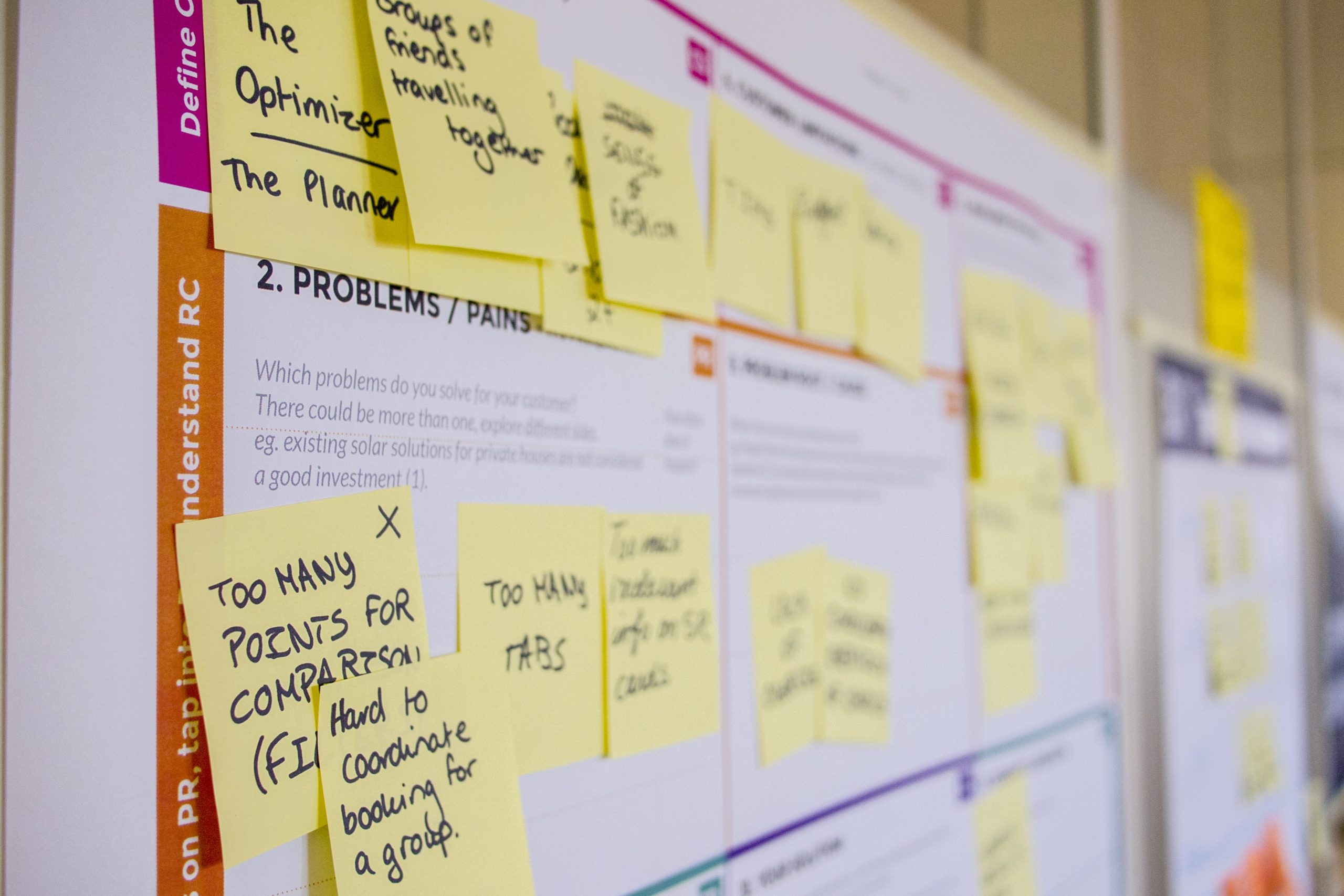
Keeping customers and building a loyal customer base are key to a growing and profitable business. But what drives retention and loyalty in your industry in general? What matters to customers of your company, products, and services in particular?
Selecting customer retention survey questions for market research into these dynamics will help you pinpoint why customers stay and why they increase engagement with your company.
Patiwat Panurach, NewtonX’s VP of Strategic Insights and Analytics, suggests: “Be extremely clear on your objectives, as they will drive the questions you ultimately select.” You can use the insights from your customer survey questions in improving your marketing messages and sales processes.
Here are the keys to gaining a deeper understanding of your customers’ perceptions, behaviors, and motivations toward your brands.
Customer retention vs customer loyalty
People often mention customer retention and loyalty in the same breath. While related, the ideas are subtly different.
Customer retention refers to a customer continuing to buy and use your products and services. It is binary. You either keep the customer, or you don’t. Your customer retention rate is the percentage of customers who return to buy again within a specified time frame.
Customer loyalty is about the relationship customers have with your company or brands. It is based on trust, understanding, and a positive relationship. It goes beyond customer retention. Loyal customers recommend your company and advocate for you. It is measured in degrees. A client can be slightly loyal, coming back to buy again, more loyal, expressing a degree of customer satisfaction or even delight, or passionately loyal, telling everyone how great you are.
What is a customer retention survey?
A customer retention survey is a tool used by businesses to gather feedback from their existing customers with the aim of assessing their satisfaction, loyalty, and likelihood to continue using the products or services. The primary purpose of a customer retention survey is to understand the factors that influence customer retention and identify areas for improvement. Because measuring customer loyalty is a deeper, more complex process , customer loyalty survey questions are more extensive. Add these to the retention and customer retention survey questions above for a complete picture.
Why do customers leave?
There are several common reasons why customers may leave your company and churn. While the specific reasons can vary depending on the industry and the nature of the business, some of the most frequently observed factors include:
- Poor Customer Service : Customers value quality customer service, and if they consistently experience unresponsive or ineffective support, it can lead to dissatisfaction and churn.
- High Prices or Lack of Value : Customers may decide to leave a service if they feel the price is too high compared to the perceived value they receive. This could be due to better alternatives in the market or a mismatch between the cost and the benefits provided.
- Inadequate Product or Service Qualit y: Customers expect products or services to meet their needs and fulfill their expectations. If they encounter consistent quality issues, defects, or subpar performance, they may seek alternatives.
- Lack of Personalization : Customers appreciate personalized experiences that cater to their individual preferences and needs. When businesses fail to provide personalized offerings or communication, customers may feel undervalued and seek alternatives.
- Competitive Offerings : The presence of strong competitors offering better features, pricing, or overall value can entice customers to switch to their products or services.
- Changes in Needs or Circumstances : Customers’ needs and circumstances can change over time. If a service no longer aligns with their evolving requirements, they may decide to churn and explore other options.
- Negative Word of Mouth : Negative reviews or recommendations from friends, family, or online sources can significantly impact customer decisions. If a service consistently receives poor feedback, it can lead to churn.
- Unresolved Issues or Complaints : When customers face unresolved issues or complaints, and their concerns are not adequately addressed or resolved in a timely manner, it can erode trust and loyalty, leading to churn.
- Lack of Engagement or Relevance : If customers do not feel engaged or connected to a service, they may lose interest and seek alternatives that offer more relevant and engaging experiences.
It’s important for businesses to identify these churn drivers and proactively address them to reduce customer attrition. By understanding the specific reasons for churn within their industry and target market, businesses can develop tailored strategies to enhance customer satisfaction, improve retention rates, and foster long-term loyalty.
What are the key objectives of customer retention survey questions?
At NewtonX, we understand the importance of effective customer retention strategies and the need to achieve specific objectives. A comprehensive approach focuses on measuring and optimizing key retention factors to drive sustainable business growth.
Customer retention solutions need to revolve around the following core objectives:
- Maximize Customer Satisfaction : We prioritize maximizing customer satisfaction among your existing customer base. Through targeted surveys and in-depth analysis, we identify areas where satisfaction can be enhanced, ensuring that your customers receive the best possible experience.
- Proactive Identification of Dissatisfied Customers : Our customer retention program includes proactive measures to identify dissatisfied customers before they consider leaving. By implementing a robust feedback mechanism, we detect warning signs and address concerns promptly, enabling you to retain valuable customers.
- Understanding the Reasons for Customer Churn : We help you uncover the underlying reasons why current customers choose to leave your business. Our surveys delve into the factors that contribute to customer churn, providing valuable insights that inform strategic improvements and retention efforts.
- Attention to Customer Details : We recognize that building personal relationships with customers can be challenging, especially as businesses grow. However, maintaining a personalized approach is crucial. Our customer retention solutions ensure that you retain the “friendly face” of your business, fostering meaningful connections with customers even as you scale.
8 key customer retention survey questions to ask
- What prompted you to buy our product/service?
- How would you rate the quality of the product/service purchases?
- How satisfied are you with it?
- With what aspects are you most satisfied?
- With what aspects are you least satisfied?
- Do you plan on buying such a product/service again?
- How likely are you to buy from us?
- How likely are you to recommend us?
9 key customer loyalty survey questions to ask
- How long have you been a customer, and how much do you buy? Ideally, your CRM has these answers, but if not, be sure to ask!
- How likely are you to switch to a competitor? Why is that?
- How likely are you to buy from us again? Why is that?
- Would you buy other products/services from us?
- Do you plan to buy more in the future? Why?
- What do we do well?
- What could we improve?
- How likely are you to recommend our product/service?
- When talking about us to others, what do you say?
How to effectively measure customer retention?
To effectively measure and enhance customer retention, it’s crucial to employ comprehensive survey strategies that capture key insights. Here are multiple options for measuring customer retention using surveys:
- Customer Satisfaction Surveys : Conduct surveys to gauge the satisfaction levels of your current customers. Include questions that assess their overall experience, product/service quality, customer support, and likelihood to recommend your business to others. Utilize rating scales, open-ended questions, and Net Promoter Score (NPS) to obtain a holistic view of customer satisfaction.
- Exit Surveys : Implement exit surveys to identify the reasons why customers choose to leave your business. Ask about their primary concerns, factors that influenced their decision, and any areas where you fell short of their expectations. This feedback can help you address issues and make improvements to retain future customers.
- Customer Retention Program Evaluation : Evaluate the effectiveness of your customer retention program by conducting surveys specifically tailored to measure its impact. Include questions about program awareness, perceived value, and whether customers feel it has influenced their decision to continue doing business with you.
- Employee Feedback Surveys : Involve your employees in the customer retention process by gathering their insights. They often have valuable perspectives on customer interactions and can provide suggestions for improving customer retention efforts. Employee feedback surveys can help identify areas where training, support, or process improvements are needed.
- Benchmarking and Comparison Surveys : Compare your customer satisfaction and retention levels against industry benchmarks or your competitors. Conduct surveys that capture customer perceptions of your business in relation to others, allowing you to identify areas where you excel or need improvement.
- Continuous Improvement Surveys : Implement regular surveys to monitor customer satisfaction and identify opportunities for ongoing improvement. These surveys can focus on specific touchpoints or aspects of your business, helping you identify areas where you can exceed customer expectations and drive higher retention rates.
Uncover the drivers of long profitable relationships with NewtonX
Measuring customer loyalty and retention and uncovering the secrets behind them can drive profitability. It is easier to sell to an existing customer base and the margins are often much better.
Worried about what kind of questions to ask in your study? Whether it’s for customer retention survey questions, persona survey questions , or even win loss survey questions , NewtonX B2B market research services can help you identify what to ask and understand customer loyalty in your industry. Contact us today if you want to learn more about your potential or existing customer base and how to nurture a lasting relationship with them.
Sign up for our newsletter, NewtonX Insights:
Related content, ask customer experience survey questions to measure customer relationships.
Customer experience survey questions seek to uncover the details of customer interactions, customer service, and customer satisfaction with your company.
How a top private equity firm validated their investment thesis with NewtonX insights
Top Private Equity Firm Sought to Invest Confidently How can we ensure positive returns on a risky investment? A leading private equity firm needed critical answers to help them evaluate a high stakes investment in
B2B customer satisfaction research tips and what to avoid
Garnering customer feedback or gauging customer satisfaction is one of the most important initiatives for enterprise success, particularly in B2B industries, where reputation is king. Despite this importance, however, the strategies that most business leaders

How to use generative AI deliberately, for better B2B research results
Originally published on Greenbook on May 15, 2023. Walk into any research forum—or an IIEX conference—and you’ll find the conversation will invariably turn to AI. Generative AI may be all the buzz, but it’s

- Privacy Overview
- Strictly Necessary Cookies
This website uses cookies so that we can provide you with the best user experience possible. Cookie information is stored in your browser and performs functions such as recognising you when you return to our website and helping our team to understand which sections of the website you find most interesting and useful.
Strictly Necessary Cookie should be enabled at all times so that we can save your preferences for cookie settings.
If you disable this cookie, we will not be able to save your preferences. This means that every time you visit this website you will need to enable or disable cookies again.
- (855) 776-7763
All Products
BIGContacts CRM
Survey Maker
ProProfs.com
- Get Started Free
Want insights that improve experience & conversions?
Capture customer feedback to improve customer experience & grow conversions.
100+ Market Research Questions to Ask Your Customers

Babu Jayaram
Head of Customer Success - ProProfs
Review Board Member
Babu Jayaram brings over 20 years of experience in sales and customer service to his role on the Qualaroo Advisory Board. With a profound understanding of sales and conversion strategies, ... Read more
Babu Jayaram brings over 20 years of experience in sales and customer service to his role on the Qualaroo Advisory Board. With a profound understanding of sales and conversion strategies, Babu is committed to delivering exceptional results and fostering robust customer relationships. His expertise extends beyond mere management, including adept handling of support tickets, overseeing internal and customer-facing knowledge bases, and training support teams across diverse industries to ensure exceptional service delivery. Read less

Author & Editor at ProProfs
Shivani Dubey specializes in crafting engaging narratives and exploring Customer Experience Management intricacies. She writes on vital topics like customer feedback, emerging UX and CX trends, and sentiment analysis.
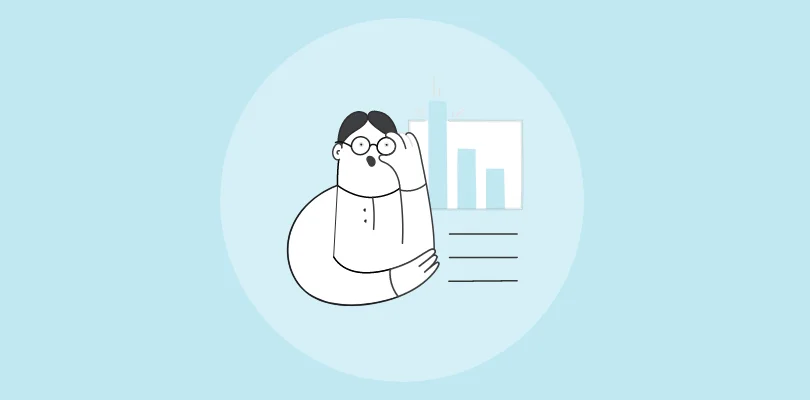
Asking the right market research questions can help you understand your target customers and map their behavior and preferences.
But what does it actually mean?
Let’s look at a sample from a market research survey report for mapping brand awareness:
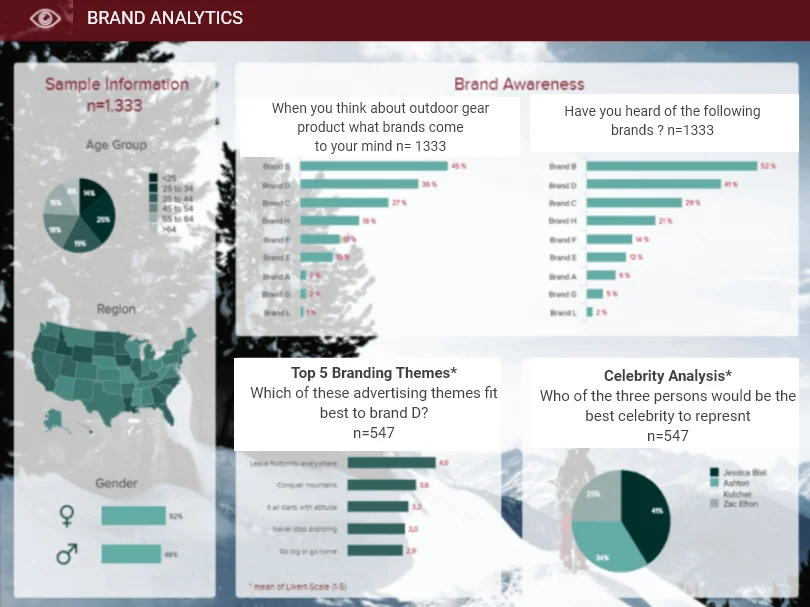
From this simple Q&A report, you can:
- Visualize the proportions of demographic segments among your audience.
- Measure how your brand is performing in comparison to others.
- Pick the top preferred brand among the customers, explore what makes it stand out, and apply the same techniques to your brand.
- See how your target market perceives brand advertisements and promotional efforts.
Now imagine if this type of data set is available for different aspects of your business – product development, marketing campaigns, optimization plans, and more.
That’s what market research does for you.
With the evolution of customer interaction points and constantly changing market trends, more and more businesses are fueling efforts to do in-depth market research, as evidenced by the steady increase in the revenue of the market research industry worldwide.
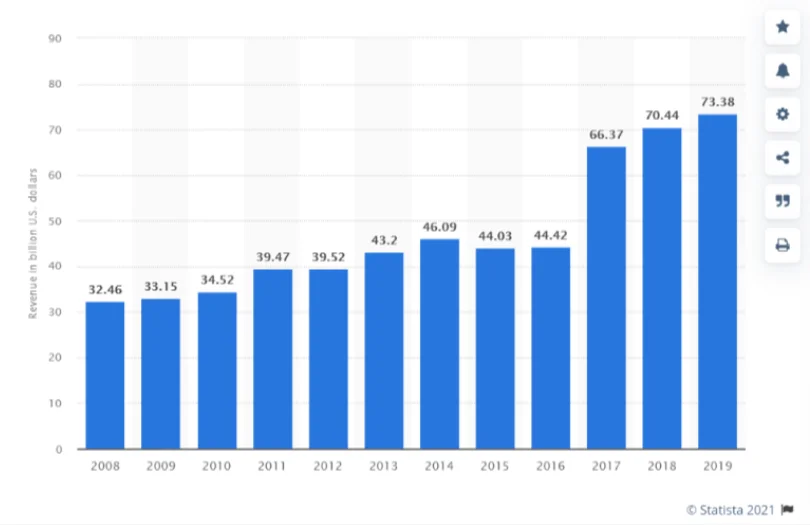
Market research can help you develop essential business strategies and maintain a competitive advantage over other brands to increase conversions and customer base.
And it all starts with asking the right questions to the right audience.
That’s why we have created this collection of 100+ market research questions to ask your target market. Each question aims to uncover a specific attribute about your customers. You can use a combination of these customer research survey questions, interviews, and othe marketing questionnaires for customers.
We have also added key tips to help you write your own effective market analysis questions if the needed.
100+ Great Market Research Questions to Ask Your Customers
The main challenge while designing and conducting research is – “What questions should I ask in my customer research survey?
That’s why we have a carefully curated list of market research questions to help you get started.
To Explore New Product Opportunities

- What was your first reaction to the product?
- Would you purchase this product if it were available today?
- What feature would you like to see on the website/product?
- Which feature do you think will help improve the product experience for you?
- Of these four options, what’s the next thing you think we should build?
- What’s the one feature we can add that would make our product indispensable for you?
- Would implementing [this feature] increase the usability of the [product name]?
- Please let us know how we can further improve this feature.
- What problem would you like to solve with our product?
To Collect Feedback on Existing Products
- Have you heard of [product name or category] before?
- How would you feel if [product name] was no longer available?
- How disappointed would you be if you could no longer use [Product/feature name?]
- How often do you use [product name]?
- How long have you been using [product name] for?
- When was the last time you used [product name]?
- Please rate the following product features according to their importance to you.
- According to you, In which area is this product/service lacking the most? Specify below.
- How does the product run after the update?
- Rate our product based on the following aspects:
- Have you faced any problems with the product? Specify below.
- What feature did you expect but not find?
- How are you planning to use [product or service]?
- How satisfied are you with the product?
To Segment the Target Market
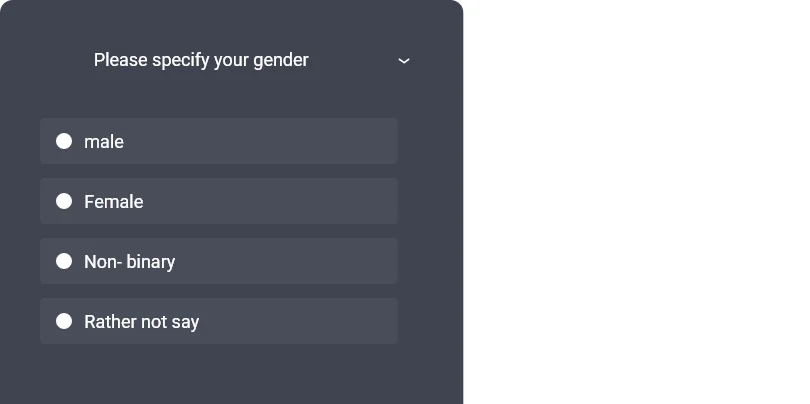
Please specify your age.
- Please specify your gender.
- Select your highest level of education.
- What is your current occupation?
- What is your monthly household income?
- What is your current marital status?

- What is the name of your company?
- Where is your company’s headquarters located?
- Please specify the number of employees that work in your company.
- What is your job title?
- In which location do you work?
- Which activity do you prefer in your free time?
- Which other physical activities do you take part in?
- Where is your dream holiday destination?
- Please rate the following as per their priority in your life – Family, work, and social life?
- Are you happy with your current work-life balance?
- Do you describe yourself as an optimist or a pessimist?
- How often do you give to charity?
- How do you travel to work?
- How do you do your Holiday shopping?
To Conduct a Competition Analysis

- Which product/service would you consider as an alternative to ours?
- Rate our competitor based on the following:
- Have you seen any website/product/app with a similar feature?
- How would you compare our products to our competitors?
- Why did you choose to use our [product] over other options?
- Compared to our competitors, is our product quality better, worse, or about the same?
- Which other options did you consider before choosing [product name]?
- Please list the top three things that persuaded you to use us rather than a competitor.
- According to you, which brand best fits each of the following traits.
To Gauge Brand Awareness
- [Your brand name] Have you heard of the brand before?
- How do you feel about this brand?
- How did you hear about us?
- Describe [brand name] in one sentence.
- If yes, please tell us what you like the most about [your brand name]?
- If no, please specify the reason.
- How likely are you to purchase a product from this company again?
- If yes, where have you seen or heard about our brand recently? (Select all that apply)
- Do you currently use the product of this brand?
- Have you purchased from this brand before?
- Of all the brands offering similar products, which do you feel is the best brand?
- Please specify what makes it the best brand for you in the category.
- Which of the following products have you tried? (Select all that apply)
- On a scale of 1 to 10, how likely would you recommend this brand to a friend or colleague?
To Map Customers’ Preferences
- Have you ever boycotted a brand? If so, which brand and why?
- What influences your purchase decision more – price or quality of the item?
- How many hours do you spend on social media like Facebook, Instagram, etc.?
- How do you do your monthly grocery shopping – online or through outlets?
- How do you search for the products you want to buy?
- Rate the factors that affect your buying decision for [product].
- What persuaded you to purchase from us?
- How likely are you to purchase a product from us again?
- Please rate the following aspects of our product based on their importance to you.
- What is the most important value our product offers to you?
- Which of the following features do you use least?
- How well does the product meet your needs?
To Map Customers’ Reservations
- Is there anything preventing you from purchasing at this point?
- What’s preventing you from starting a trial?
- Do you have any questions before you complete your purchase?
- What is the main reason you’re canceling your account?
- What are your main reasons for leaving?
- What was your biggest fear or concern about purchasing from us?
- What is the problem that the product/service helped to solve for you?
- What problems did you encounter while using our [product]?
- How easy did we make it to solve your problem?
- What is your greatest concern about [product]?
- Have you started using other similar products? If yes, what made you choose that product?
To Perform Pricing Analysis
- Would you purchase the product at [price]
- According to you, what should be the ideal price of the [product name]?
- Is our product pricing clear?
- According to you, what is the ideal price range for the product?
To Collect Feedback on Website Copy
- Please rate the website based on the following aspects:
- How well does the website meet your needs?
- Was the information easy to find?
- Was the information clearly presented?
- What other information should we provide on our website?
- How can we make the site easier to use?
- What could we do to make this site more useful?
- Is there anything on this site that doesn’t work the way you expected it to?
- How easy was it to find the information you were looking for?
- Have feedback or an idea? Leave it here!
- Help us make the product better. Please leave your feedback.
To Assess Website/Product Usability
- Are you satisfied with the website layout?
- What features do you think are missing on our website?
- What features do you not like on our website?
- Was our website navigation simple and user-friendly?
- How much time did it take to find what you were looking for on our website?
- Was it easy to find the products you are looking for?
- Was the payment process convenient?
To Uncover Market Trends and Industry Insights
- Did you purchase our product out of peer influence or individual preference?
- How do you form your opinion about our product?
- Do you follow trends of the product, or do you prefer to go with what you know?
- Do discounts or incentives impact your decision-making process?
Market Research Survey Templates
One of the easiest ways to conduct market research is to use survey templates. They can help you save time and effort in creating your own market research surveys.
There are many types of market research survey templates available, depending on your objectives and target audience. Some of the most popular ones are:
- Demographic Templates: These templates help you segment your customers based on their location. It can help you tailor your marketing strategies and offers to different customer groups.

- Consumer Behavior Templates: These templates help you keep your pulse on your target market.
Industry Insights Templates: These templates help you get detailed information about your target industry and business.

Breakdown of Different Market Research Questions
The answer choices in a market research survey question can significantly impact the quality and reliability of the response data you collect from the audience.
Some answer types help categorize the audience, while others measure their satisfaction or agreement.
So, before listing the customer research survey questions to ask your target audience, let’s understand their types:
Multiple Choice
A multiple-choice question type lets users select more than one answer from the given options. These questions are great for collecting multiple data sets using the same question and gauging people’s preferences, opinions, and suggestions .
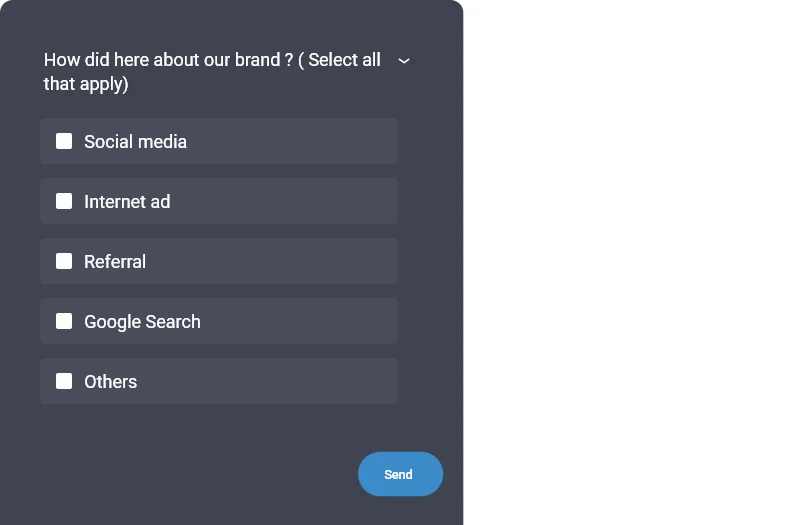
Single Choice
In a single-choice question, the respondent can select only one answer from the given options. This question type is great for:
- Segregating the users.
- Prioritizing product updates based on user consensus.
- Disqualifying irrelevant respondents by placing the question at the start of your customer research survey.
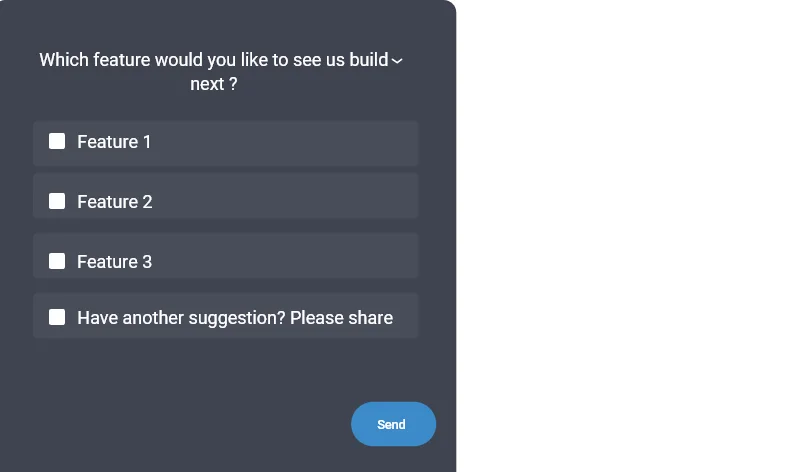
Matrix Match
A matrix matching grid can combine multiple market research questions into one to make the survey shorter . There is only one condition – the individual questions should have the same response anchors as shown in the image below:
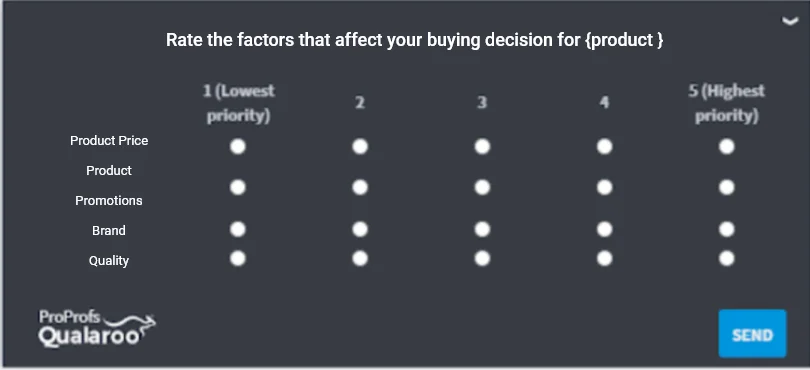
The questions are arranged in rows while the answer options occupy the grid columns.
Ranking Question
A ranking question can help map customers’ preferences and set priorities for product development . This question type asks the respondent to arrange the given options in their decreasing/increasing preference.
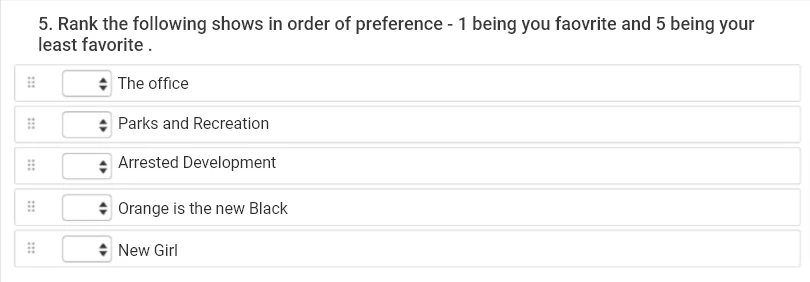
Dichotomous
A dichotomous question poses a simple yes or no scenario to the respondent. These question types can help disqualify irrelevant people from the survey and categorize the users into two groups .
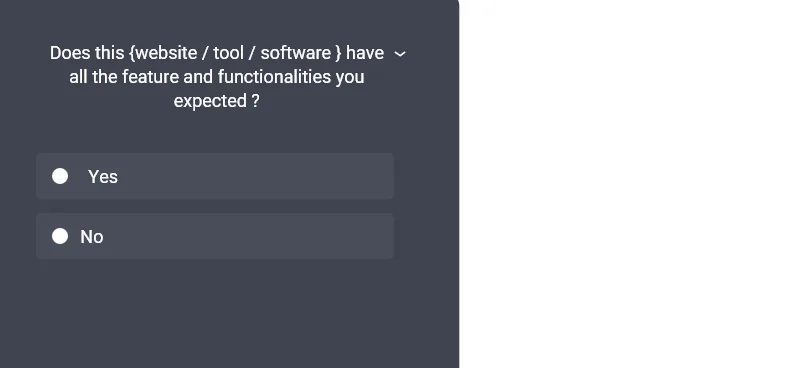
Likert Scale
Likert scale market research questions can help you measure the extent of respondents’ agreement/disagreement with the given statement . The answer options are arranged from positive to negative sentiments or vice-versa, with the neutral option in the middle.
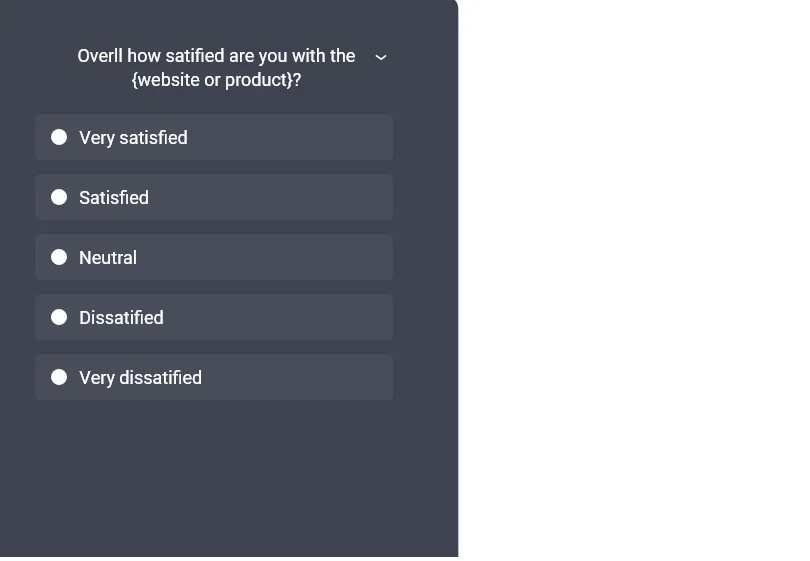
There are two types of Likert scales: 5-point and 7-point .
Open-ended market questions let you explore the respondents’ minds without adding any restrictions to the answer . This question type is followed by a blank space for the respondent to add a free-text response.

You can add an open-ended question as a follow-up after the first question to explore the reasons for the customer’s previous answer. It also lets you collect more in-depth information about their issues, pain points, and delights.
Tools like Qualaroo offer tons of different question types for your surveys. Just pick the question and match its answer option type from the drop-down. To make it more effective, you can add branching to the survey.
How to Write Your Marketing Research Questions
It’s imperative to have a dedicated repository of market research questions for your surveys. But nothing’s better than crafting your questions.
For this, you need to sit with your team and discuss what information you require from the customers. It lets you analyze and document how much data you already have in your system, which can help set the market research scope.
We have listed some questions you need to ask yourself before asking market research questions to your potential customers or target market:
Audience Segmentation Questions
Audience segmentation questions help to size up your target market and provide a granular view of the audience . Not all customers are equal, and audience segmentation makes it possible to focus on each group individually to address their issues, fears, and expectations.
Here’s what you need to know before you start writing customer research survey questions to understand your audience:
- Do we understand the demographics of the new market we are trying to target? (Age, location, ethnicity, education, company, annual income, etc.)
- What are the locations that drive the most customers to our business? How are these locations different from others?
- What are the interests, preferences, and fears of people from our new target market? Have we addressed these situations for our current customer base?
- What are the psychographics attributes of the current customers and potential market? Are we targeting these in our campaigns?
- What are the most popular engagement channels for our customers? Which channels drive the most traffic to our website?
- Do we have enough data to perform value segmentation to separate high-value customers from low-value customers?
- How often do these high-value customers make a purchase?
Product-Based Market Research Questions
Product-based market research questions can produce precious insights to channel into your product development and optimization strategies . You can see how changing technology affects customers’ behavior, what new features they want to see in your product, and how they perceive your products and services over the competition.
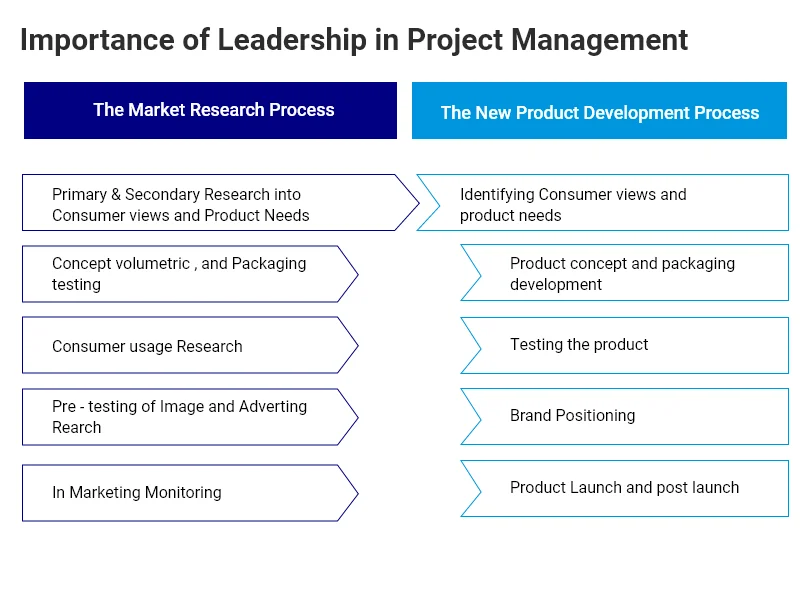
Start by gathering information about the following:
- How does our product compare to the competition based on the features?
- What products do our competitors offer?
- What new features do customers want to see in our products? Do we have a product roadmap to deliver these updates?
- What unique solutions do our products offer? What is the value proposition that reflects this offering?
- Does our product incorporate the latest technological advancements?
- What channels do we use to collect product feedback from our users?
- What are customers’ preferences while choosing our products over competitors?
Pricing Market Research Questions
Pricing analysis can help you make your product more affordable to different customer segments while maintaining the desired gross margin. It also lets you restructure the pricing tiers to provide features depending on the customers’ requirements and company size .
Watch: (1/5) Supercharge Your Revenue With Data-Driven Pricing
Your sales and marketing team can help you hone in on the market research questions to ask your customers for running pricing analysis:
- Do the customers ever complain about the difficulty in finding the pricing information?
- What is the pricing structure of our competitors for the same products? What features do they include for a specific price?
- How do customers find our pricing when compared to the competitors?
- Do our products provide value for money to the customers? Does the sales pitch reflect this point?
- Can we restructure the pricing, and how will it affect the revenue?
- Are there any customer segments that have high-value potential but find the current pricing unaffordable? What are the plans for such customers?
- Are we in a situation to offer a basic free plan to encourage customers to try our product before upgrading?
- What promotions can we run to attract more customers?
- Should we target customers based on income, company size, or type of solution to set our product prices?
Brand Reputation Market Research Questions
A brand reputation questionnaire for marketing research gives you information on how well your target market knows about your brand. You can uncover previously unidentified channels to increase brand awareness and find potential customers to promote your brand .
Start by gauging what customers are saying about your brand:
- Which channels receive mentions of our brand? Are these posts positive or negative?
- Do we have a system in place to analyze and monitor these reviews and posts?
- What are the reviews of our brand on different sites? What is the overall impression of our brand in the market?
- How are we currently addressing the negative reviews and complaints? What do our customers think about the handling process?
- What is the impression of our brand in our target market?
- What brand awareness campaigns are our competitors running?
- Is our brand among the top choices of our target customers?
Advertisement & Campaign-Based Questions
These customer research survey questions let you assess the effectiveness of your current value propositions and campaigns . You can channel the customer insights into your advertising strategies to design targeted campaigns for different customer segments to reduce the overall acquisition cost and increase conversions.
Ask the following questions to collect information about the different marketing campaigns that are performing:
- What are the best modes to run the advertisement campaigns to reach our target audience?
- What is the estimated lifetime value of customers acquired from current campaigns? Is it higher or lower than the acquisition costs?
- Which campaigns bring the most ROI and why?
- How well do our advertisements present our value proposition to the customers? Do they address customers’ fears and expectations to attract them?
- Are we running A/B tests to improve our online campaigns? How are we gathering data to build the A/B test hypotheses – surveys, heatmaps, eye tracking, etc.?
- What advertisement campaigns do our competitors run?
7 Question Types to Use in Market Research Surveys
We mentioned earlier that market research questions provide important data for different operations like product development, marketing campaigns, sales pipeline and more.
But to what extent?
Let’s break it down to individual processes and understand how insights from customer research surveys can impact them:
To Know Your Target Market
Understanding your target audience is the fundamental aspect of market research, be it a new target market or existing customers. If you know what marketing research survey questions to ask your target market, you can identify different customer types’ unique traits and preferences.
The data can help you segment the users based on demographic, psychographic, geographic, and other attributes. These include their behavior, purchase preferences, age, location, habits, delights, frustrations, and more.
You can then create various customer personas and fuel your sales strategies to maximize ROI.
Case study – How Avis increased its revenue per customer
Avis, a leading car rental company, was looking to enhance customer experience by offering useful car add-ons like navigation systems, child seats, insurance, etc., to customers with their booking. So, it reached out to AWA Digital to find a way to promote these products and increase their sales.
AWA digital implemented customer research campaigns using targeted surveys to determine which add-ons were popular among the customers and why.
Using these insights, the team added an interstitial pop-up just before the booking page to show relevant add-ons to the customers.
This simple update dramatically increased the sales of add-on items and helped Avis generate more revenue per customer.
Read the entire case study here .
To Plan the Product Roadmap
A product roadmap is a visual representation of the current status of your product and planned updates over time. It shows a high-level summary of planned activities and priorities for different teams to take the product to the next level.
Steve Jobs famously said – “You’ve got to start with the customer experience and work backward to the technology. You can’t start with the technology then try to figure out where to sell it.”
And market research helps to align your product strategies with the customer demand. Using targeted marketing survey questions, you can gauge what new features or functionality customers want to see in your products.
It helps to plan product development strategies based on customers’ consensus to prioritize the ideas that can have the most impact on customers and replace intuition-based approaches with data-backed decisions.
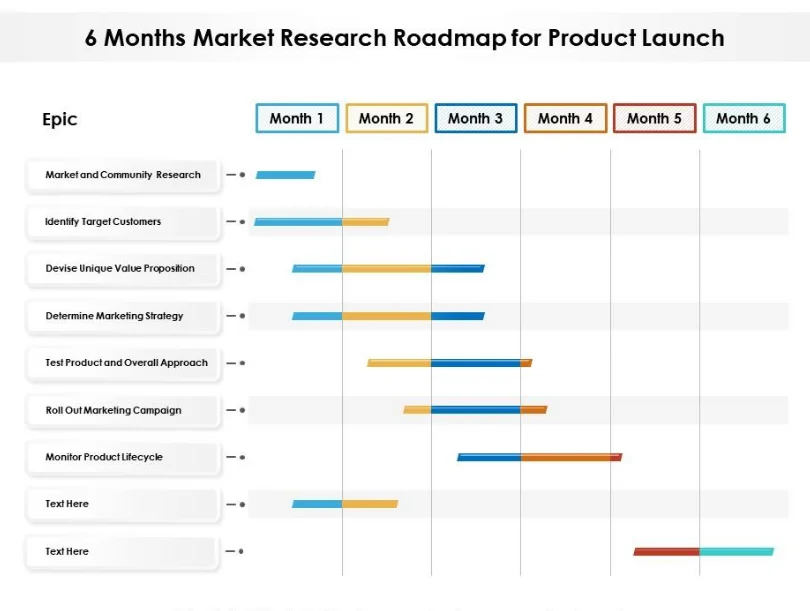
Customers’ demands change with market trends and technological advancements. That’s why your product map also needs to evolve constantly with time to reflect these changes in your product development cycle.
By designing targeted market research questions to ask the customers, you can uncover their expectations to deliver optimal product solutions.
That’s what our next case study demonstrates.
Case study – How customer research drives Twilio’s operations
Twilio, a cloud communications platform places customer discovery and research at the core of their product development strategies. It helps its teams to anticipate customer needs in a constantly changing market.
Lack of time and budget are the two biggest challenges that the company faces in its product development cycle. So, the team uses targeted market research questionnaires for a product to understand the challenges the customers face today and the ones they will face tomorrow.
With an abundance of ideas and no time to test them all, the feedback data from surveys is used to prioritize the hypotheses to run the tests. It makes the process more efficient and effective in producing positive results.
This data-backed approach is used across 18 different teams at Twilio to release new functionality every week and deliver optimal solutions to the clients.
Read the complete case study here .
To Reduce Acquisition Costs
Your customer base consists of multiple customer segments with different preferences and purchase potential. That’s why you cannot sell to everyone and need to find the right audience for your products.
If an acquired customer doesn’t bring in more revenue than it costs to acquire them, it will increase your acquisition costs over time.
We don’t want that, do we?
For example, let’s say you are targeting the entire market population using the same campaign. If your acquisition cost per customer is $300 and you acquire 20 customers from one campaign, you need to make more than $6000 to register profits.
The difficulty is you don’t know about these customers’ purchase behavior and capacity, so you cannot be sure if you will reach your goals. It adds unnecessary risks to your marketing ventures.
But, if you were targeting a specific segment with high income, regular shopping habits, or proven history of brand loyalty, You can obtain better results.
Now, the question is –
How will you separate these potential long-term customers from one-time buyers and high-value targets from other segments?
One way to do this is by building customer personas using the data from the market research survey questions. A buyer persona defines different attributes of a particular customer segment so you can hone in on the right audience to funnel your marketing efforts.
Here’s what a typical persona includes:
- Target regions
- Target demographic (age, marital status, gender)
- Ideal psychographics (hobbies, social channels, activities they indulge in, goals)
- Preferred interaction channels
- Favorite brands and products
- Total revenue till date
- Estimated lifetime value
Once you have a clearer picture of different customers, you can find high-value prospects with the potential to be long-term customers looking for product solutions that your business offers.
You can then design the correct pitch using the market research data to bring in these customers and control the overall acquisition costs.
For example:
- Plugin the demographic and psychographic data into CRM software like BIGContacts or Salesforce to convert high-value targets.
- Use your CRM to create segmented lists of prospects based on estimated value, location, current status, and more. Then target these groups individually with personalized value propositions to increase conversion rates.
- Identify their preferred mode of communication and technographic inclinations to find the right opportunities to pitch your product offering at the precise moment.
Even if acquiring and retaining such customers costs more, their overall revenue can balance the acquisition costs to deliver higher profits.
To Design Targeted Marketing Campaigns
By knowing how your target audience behaves and interacts with your business, you can find the exact opportunities to target them with personalized campaigns.
- You can use mail campaigns to target website users with app-exclusive offers to encourage them to download your app and improve app adoption.
- Add in-app broadcast messages about upcoming offers, exclusive membership benefits, and other incentives for new users to push them towards the end of the funnel.
- Create multiple landing pages to target different customer types.
- Design location-based ad campaigns with personalized value propositions based on audience preferences and problems at each location.
Case Study – How Canon’s campaigns generated 700% ROI
AWA digital was tasked by Canon, one of the biggest electronics companies worldwide, to assess and increase the demand for their products in different geographies. So, the AWA team conducted customer research using target market survey questions and discovered the following attributes about customers’ purchase behavior and reservations:
- In some regions, people were reluctant to spend money on a Canon camera as they weren’t sure if Canon was an authoritative brand.
- In other regions, authority was not as important to the users.
Using these insights, AWA optimized the ads campaigns’ messaging for different locations to include what consumers deemed important purchase factors.
The results?
With in-depth customer feedback, Canon generated an overall ROI of 700% in all regions using personalized campaigns to target the audience.
To Improve Brand Awareness
Whether you are into soft drinks or not, You probably would have heard of Coca-Cola’s 2011 Share-A-Coke ad. This single campaign put the Coke brand back on the map and reversed the 10-year steady decline in sales in the US.
Coke understood what motivates their customers and delivered a product offering that appealed to the masses to increase its brand equity- the excitement to get a Coca-Cola bottle with their name on it.
How did they do it?
In 2011, Coca-Cola rolled out its share-a-coke campaign in Australia. The company debranded the traditional Coke logo from the bottle and replaced it with the phrase “Share a Coke with” followed by a name.
The campaign used the list of the country’s most popular names (nicknames). The purpose was to make people go out and find the Coke bottle with their name on it and share it with their friends. The campaign was subsequently rolled out in 80 countries.
How did it impact Coca-Cola as a brand:
- In Australia, it’s estimated that the campaign increased Coke’s share by 4% and increased consumption among young adults by 7%.
- #ShareACoke became the top trending hashtag on Twitter globally and received over 1 billion impressions.
- In the USA, the campaign increased Coke’s market share by over 2% and brought 11% more sales compared to the previous year.
It’s not limited to big brands only.
Understanding the customers and placing your product’s value offering along with their habits, lifestyle, and behavior can help you extend your brand’s reach.
Today, there are multiple touchpoints to connect with your customers and map their journey to uncover their issues, motivations, and fears to address in your campaigns.
- Monitor brand mentions on social media and engage with the users to cultivate an online community and promote your brand.
- Reach out to satisfied customers and turn them into your brand ambassadors.
- Use targeted ad campaigns that connect people’s emotions and general behavior to imprint your brand’s image in their minds.
Quick Tips for Writing Awesome Market Research Survey Questions
With the inter-team research complete, you are ready to write your own market research questions to ask your target audience. Keep these general dos and don’ts in mind to ensure that the market survey fulfills the purpose without affecting the data quality or response rate.
Use Mutually Exclusive Response Options
If you are using response anchors with specific ranges like age group or income, check that the options do not overlap . Otherwise, it will produce an irregular data set.
Please specify your age:
In the above example, the respondent lying on either extremity of the given age ranges may get confused on which option to choose. For example, a 28-year-old respondent can choose from both second or third options.
Plus, two different respondents of the same age may select different options, which will skew your demographic data.
You can avoid this confusion by creating mutually exclusive groups as shown below:
Always Add A “Not Applicable” Or “Rather Not Say” Option
Since market research questions extract personal information, some respondents may not want to share such details with you. These include questions about age, income, gender, hobbies, social activities, and more.
Forcing such questions on the customers without allowing them to skip can irate them and lead to survey abandonment .
That’s why you can also use Qualaroo’s skip and branching logic to create smart surveys that only ask relevant questions to your respondents based on their previous answers.
Calculate the Required Sample Size
Sample size plays a vital role in your market research questions to determine the reliability of your response data.
If the response volume is low, the results may not be conclusive to point towards customers’ consensus. On the other hand, a larger sample size than required means a waste of the company’s valuable resources and time.
That’s why it’s important to calculate the required sample size to estimate the number of responses you need for your market research survey questions.
You can use any survey sample size calculator available online to get started. Just fill in the required details to get the required sample size.
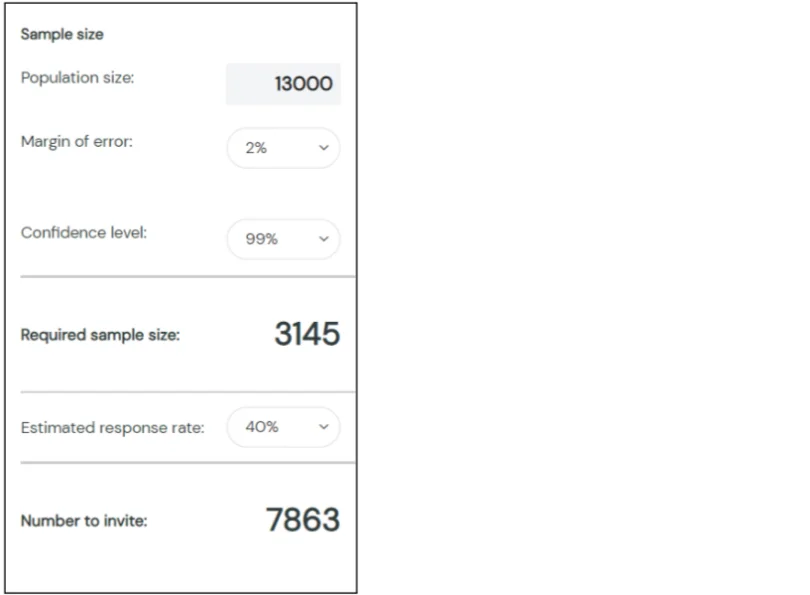
For example, to reach a statistical significance of 99%, you need at least 3145 responses to your market research questionnaire.
Consider Adding Incentives
Studies show that incentivized customer research surveys or questionnaires fetch higher response rates than general surveys.
The incentives encourage customers to invest their time in a survey and get something in return.
It means creating a gated questionnaire for market research can help you reach the required sample size quickly . The incentive can be a simple discount code, free shipping coupon, free ebook, or other freebies.
However, there is a possibility that irrelevant respondents may fill out the survey randomly just to get to the offer, which may skew the results. You can use screening questions to filter out unsuitable respondents.
Avoid Double-Barreled Market Research Questions
A double-barreled question poses two questions into one. The problem with such questions is that the respondent may have opposing views about the two statements in the questions. It makes it harder for them to choose one answer from the options .
“Please rate the [product name] on a scale of 1-10 based on overall quality and price?”
Here, the respondent may find the product quality appreciable while thinking it to be overpriced at the same time. In such a case, they may skip the question or select any option randomly.
You can easily sidestep this hurdle by breaking your double-barreled market research question into two to make it less confusing for the respondents.
Importance of Market Research
We mentioned earlier that market research questions provide important data for different operations like product development, marketing campaigns, sales pipeline, and more.
Understanding your target audience is the fundamental aspect of market research, be it a new target market or existing customers. If you know what customer research survey questions to ask your target market, you can identify different customer types’ unique traits and preferences.
AWA Digital implemented research campaigns using targeted customer research surveys to determine which add-ons were popular among the customers and why.
Steve Jobs famously said – “You’ve got to start with the customer experience and work backward to the technology. You can’t start with the technology and then try to figure out where to sell it.”
And market research helps to align your product strategies with the customer demand. Using targeted customer research survey questions, you can gauge what new features or functionality customers want to see in your products.
Image Source: Slide Team
By designing targeted market research questions to ask the customers, you can uncover their expectations to deliver optimal product solutions.
Case study – How customer research drives Twilio’s operations
Twilio, a cloud communications platform, places customer discovery and research at the core of its product development strategies. It helps its teams to anticipate customer needs in a constantly changing market.
Lack of time and budget are the two biggest challenges that the company faces in its product development cycle. So, the team uses targeted market research questionnaires for a product to understand the challenges the customers face today and the ones they will face tomorrow.
With an abundance of ideas and no time to test them all, the feedback data from customer research surveys is used to prioritize the hypotheses to run the tests. It makes the process more efficient and effective in producing positive results.
Your customer base comprises multiple customer segments with different preferences and purchase potential. That’s why you cannot sell to everyone and need to find the right audience for your products.
For example, let’s say you target the entire market using the same campaign. If your acquisition cost per customer is $300 and you acquire 20 customers from one campaign, you must make over $6000 to register profits.
But, if you were targeting a specific segment with high income, regular shopping habits, or a proven history of brand loyalty, you could obtain better results.
Now, the question is –
Image Source: brightspark
- Plug the demographic and psychographic data into CRM software like BIGContacts or Salesforce to convert high-value targets.
- Use your CRM to create segmented lists of prospects based on estimated value, location, current status, and more. Then, target these groups individually with personalized value propositions to increase conversion rates.
- Add in-app broadcast messages about upcoming offers, exclusive membership benefits, and other incentives for new users to push them toward the end of the funnel.
AWA Digital was tasked by Canon, one of the biggest electronics companies worldwide, to assess and increase the demand for their products in different geographies. So, the AWA team conducted a customer research survey using target market questions and discovered the following attributes about customers’ purchase behavior and reservations:
- In other regions, authority was not so important to the users.
Whether you are into soft drinks or not, you probably would have heard of Coca-Cola’s 2011 Share-A-Coke ad. This single campaign put the Coke brand back on the map and reversed the 10-year steady decline in sales in the US.
Coke understood what motivates its customers and delivered a product offering that appealed to the masses to increase its brand equity- the excitement to get a Coca-Cola bottle with its name on it.
- In Australia, it’s estimated that the campaign increased Coke’s share by 4% and consumption among young adults by 7%.
It’s not limited to big brands only.
Market Research: A Key to Your Business’ Success
Market research is a vital process for any business wanting to understand its customers and market better. By asking the right questions and using the right tools like Qualaroo, you can gain valuable insights that can help you improve your products or services, enhance your customer experiences, and grow your business.
In this blog, we have shared some of the best market research questions to ask your customers, as well as some of the best customer research survey templates to find market trends and industry insights. We hope that this blog has helped you learn more about market research and how to conduct it effectively.
About the author
Shivani dubey.
Shivani has more than 3 years of experience in the modern creative content paradigm and technical writing verticals. She has been published in The Boss Magazine, Reseller Club, and HR Technologist. She is passionate about Artificial Intelligence and has a deep understanding of how organizations can leverage customer support technologies for maximum success. In her free time, she enjoys Nail art, playing with her guinea pigs, and chilling with a bowl of cheese fries.
Creative Circle Wins 2024 ClearlyRated Awards for Client and Talent Service Excellence
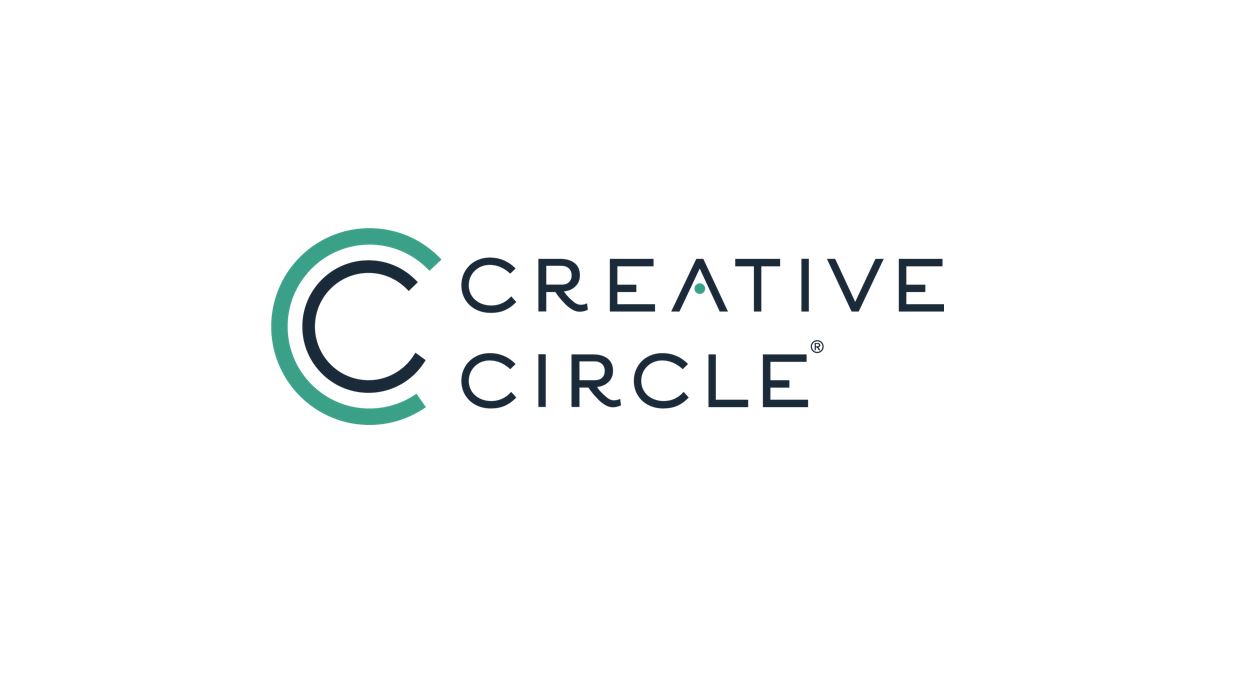
Creative Circle is thrilled to share that we have won ClearlyRated’s 2024 Client and Talent Awards for service excellence ! This marks the sixth consecutive year winning the award on the talent side, and the fourth consecutive year for clients.
ClearlyRated, a satisfaction research firm, presented these awards in partnership with Gold sponsor ClearEdge Marketing based on the 2023 results of weekly surveys that Creative Circle administered to clients and candidates.
“At Creative Circle, our guiding principle is to deliver a uniquely outstanding customer experience,” said Creative Circle President, Matt Riley. “We’re extremely proud to see our dedication to that goal recognized in these awards from ClearlyRated. I want to thank every Creative Circle employee for ensuring our clients’ and candidates’ experiences remain our topmost priority.”
“I’m so excited to introduce the 2024 winners alongside their verified ratings and reviews on ClearlyRated.com ,” said ClearlyRated CEO, Eric Gregg. “Creative Circle again proved their commitment to providing outstanding experiences and superior service. They’re raising the bar for excellence and I couldn’t be more proud to celebrate their success.”
Client Results
Our clients completed 775 satisfaction surveys in 2023, rating us on average as a 9.1 out of 10. Our Net Promoter Score of 71.2% is nearly double the industry average of 36% and categorizes us as “excellent” in client satisfaction.
Clients rated us most highly — with more than 97% rating us positively — in communication speed/responsiveness, candidate presentation, and communication clarity. 93.4% of clients agreed that they will partner with Creative Circle again in the future.
Here are a few of our favorite responses:
- Kathleen O., VP of marketing for a software company
- Amy M., creative director for an advertising agency
- Dawn C., senior marketing services manager for a nonprofit
Candidate Results
Our candidates completed nearly 4,000 satisfaction surveys in 2023, rating us on average as a 9.1 out of 10. Our Net Promoter Score of 72.2% is more than double the industry average of 30% and categorizes us as “excellent” in client satisfaction.
Candidates rated us most highly — with more than 92% rating us positively — in Creative Circle’s communication and responsiveness, how they were treated by our clients, and how prepared they felt for their roles.
Here are just a few of the positive responses we received:
- Chris A., marketing automation manager
- Jenny B., content creator
- Arshaun C., information architect
To get in touch with Creative Circle for marketing or creative services, fill out this form and somebody will be in touch shortly. If you’re a candidate looking for work, apply to roles on the Creative Circle website here .
About Creative Circle
Creative Circle provides marketing and creative services, including studio and flex bench teams, agency services, talent acquisition, and consulting. Our strength comes from our talent community, and our power lies in leveraging this network to provide flexible custom solutions for our clients.
Creative Circle is part of the Commercial Segment of ASGN Incorporated (NYSE: ASGN). To learn more, visit creativecircle.com .
About ClearlyRated
Rooted in satisfaction research for professional service firms, ClearlyRated utilizes a Net Promoter® Score survey program to help professional service firms measure their service experience, build online reputation, and differentiate on service quality. Learn more at https://www.clearlyrated.com/solutions/.
Looking for something?
We’ve been in the hiring business for 20 years and we’ve vetted more than a million professionals along the way. We’ll connect you with exceptional candidates to help bring your creative visions to life.
Look for Work
Look for Talent


IMAGES
VIDEO
COMMENTS
4. Identify trends across customer segments. Customer satisfaction surveys allow you to access rich data on how customers interact with your product regularly. Depending on the scope of your survey, you can use your survey questions to narrow down on specific behaviors, actions, preferences, and more.
Customer satisfaction surveys (CSAT) are an important way to measure how your customers feel about their experience with your company. Creating customer satisfaction surveys is reasonably straightforward, but you have to make sure you're asking the right questions. If you ask too many questions, customers won't fill out the whole survey.
Different types of questions to use in customer satisfaction surveys. The ultimate reference list of customer satisfaction survey questions. General customer satisfaction. Product feedback. User profiling. Market positioning. Four rules for writing customer satisfaction survey questions. Clarity.
Step 3: Develop Customer Satisfaction Surveys. Developing well-crafted customer satisfaction surveys is an important stage in customer satisfaction research. It serves as the primary tool for gathering customer data and insights. A well-crafted customer satisfaction survey will ensure that you get relevant and meaningful data.
Satisfaction is a great indicator of retention, loyalty, and likelihood to repurchase. High levels of satisfaction (with pleasurable experiences) are strong predictors of customer and client retention and product repurchase. Customer satisfaction data that answers why loyal customers or clients enjoyed their experience helps the company ...
2. Gauging customer loyalty: These surveys give customers a chance to share feedback that yields their propensity to be a loyal customer. Companies can use this information to better retain customers. 3. Identifying customer trends: Surveys allow companies to identify trends in customer satisfaction over time.
8 best types of customer satisfaction research questions. The top customer satisfaction questions shared by marketers were as diverse as the businesses they work for. But there were several common themes in the questions they found most helpful. Here are the favorite customer satisfaction survey questions, divided by category, for you to draw ...
Respondents use a scale from 1 to 10. These satisfaction post chat survey responses generate a score ranging from -100 (minus hundred) to 100 (a hundred). Based on the score, you can group your customers into three categories: Promoters: Those are the customers who gave you a rating of 9 or 10. They are happy and loyal.
41. [Brand]'s employees understand my needs as a customer. 42. It was simple to customize [product] to fit my needs. 43. [Brand]'s website runs on my device without any issues. Check out our customer effort score survey template to help simplify checkout for every customer. Create a survey with Typeform today.
2. Show gratitude to respondents. Respondents will feel heard and appreciated by receiving a straightforward "thank you" message at the end of your survey. It will also increase the likelihood that customers will respond to future surveys.
Client satisfaction is an important metric for the growth of an organization and client satisfaction surveys are conducted to gather client feedback about new products or services, upcoming concept and feature updates, client service and other domains of an organization. Learn all about client satisfaction survey questions and examples.
Each survey takes only a minute to set up, so dive right in. 1. Customer Satisfaction Score (CSAT) Find out how satisfied your customers really are with this CSAT survey template. 2. Net Promoter Score® (NPS) survey template. Hotjar's NPS® survey template makes it easy to measure customer loyalty. 3.
To make the most of your customer satisfaction survey, keep these tips in mind: 1. Plan your customer survey correctly. 2. Consider the different types of customer satisfaction survey questions. 3. Follow best practices when creating survey questions. Here are some more details: 1.
In this article, we will show you 21 perfectly designed examples of customer satisfaction survey questions for SaaS and free, ready-to-use survey templates. Depending on their goal, we divided the questions into four groups: Product feedback. Customer effort while dealing with the website and the product.
30 Best Customer Satisfaction Survey Questions to Ask. Written by. Shivani Dubey, Author & Editor at ProProfs. Updated: 25 Apr, 2024. "You reap what you sow" is an apt adage for customer satisfaction surveys. The feedback you collect is only as good and valuable as the questions you ask. Imagine investing hours in crafting the perfect ...
Of all of the different types of market research projects an organization can pursue, conducting customer satisfaction surveys is the most common.. Why? At its core, customer satisfaction is the essence of market research. It involves formally reaching out to customers, asking for feedback, and taking action with the results. The process is simple, informative, and offers a high return on ...
An insightful B2B customer satisfaction research study can help boost both the top line and bottom line, by showing you: How to keep customers, growing revenues. How to improve customer loyalty, reducing acquisition costs. What customers' unmet needs and wants are. Where your business needs to improve customer satisfaction.
Customer satisfaction is the key factor for successful and depends highly on the behaviors of frontline service providers. Customers should be managed as assets, and that customers vary in their ...
Definition, Types, Examples and Best Practices. By Nick Jain. Published on: June 26, 2023. Customer research is defined as the systematic process of gathering and analyzing information about customers, their behaviors, needs, preferences, and experiences. Learn more about customer research with types, examples and best practices.
A customer retention survey is a tool used by businesses to gather feedback from their existing customers with the aim of assessing their satisfaction, loyalty, and likelihood to continue using the products or services. The primary purpose of a customer retention survey is to understand the factors that influence customer retention and identify ...
Abstract. Customer satisfaction (CS) has attracted serious research attention in the recent past. This paper reviews the research on how to measure the level of CS, and classify research articles ...
Usage of an outside customer satisfaction survey company can save you time and ensure results are unbiased. These third-party market research companies can lend their experience and expertise to the process. And the best customer satisfaction firms will work with you to customize an approach, methodology, and questions for the CSAT survey.
Likert scale market research questions can help you measure the extent of respondents' agreement/disagreement with the given statement. The answer options are arranged from positive to negative sentiments or vice-versa, with the neutral option in the middle. There are two types of Likert scales: 5-point and 7-point.
TROY, Mich.: 8 May 2024 — With domestic air passenger volume up 9.4% year over year and seemingly no end in sight to crowded gates, stuffed overhead bins and expensive fares, airlines have their hands full trying to maintain customer satisfaction. According to the J.D. Power 2024 North America Airline Satisfaction Study,SM released today, big investments by airlines in staff training and ...
TROY, Mich.: 9 May 2024 — Driven by the prospect of higher interest rates, lower fees and around-the-clock access, new customers flocked to online-only direct banks during the past year. For the most part, the direct banks delivered on their end of the bargain. However, according to the J.D. Power 2024 U.S. Direct Banking Satisfaction Study,SM released today, struggles with customer service ...
Here's why North American travelers are kind of dissatisfied, according to consumer research company J.D. Power's 2024 North American Airline Satisfaction Study.
Creative Circle is thrilled to share that we have won ClearlyRated's 2024 Client and Talent Awards for service excellence! This marks the sixth consecutive year winning the award on the talent side, and the fourth consecutive year for clients. ClearlyRated, a satisfaction research firm, presented these awards in partnership with Gold sponsor ClearEdge Marketing based […]